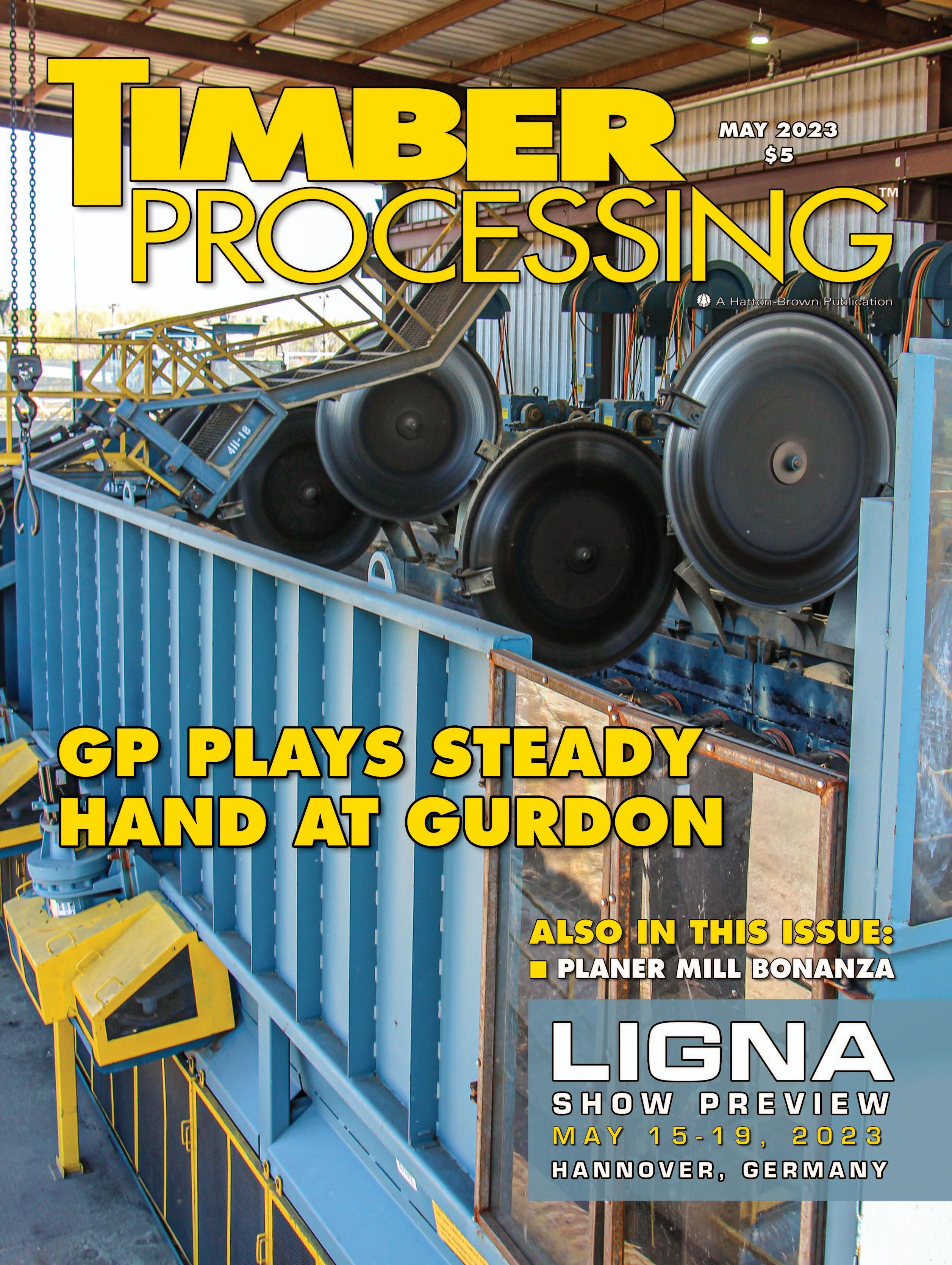
CLICK HERE IF YOU HAVE NOT ALREADY OPTED IN!

CLICK HERE IF YOU HAVE NOT ALREADY OPTED IN!
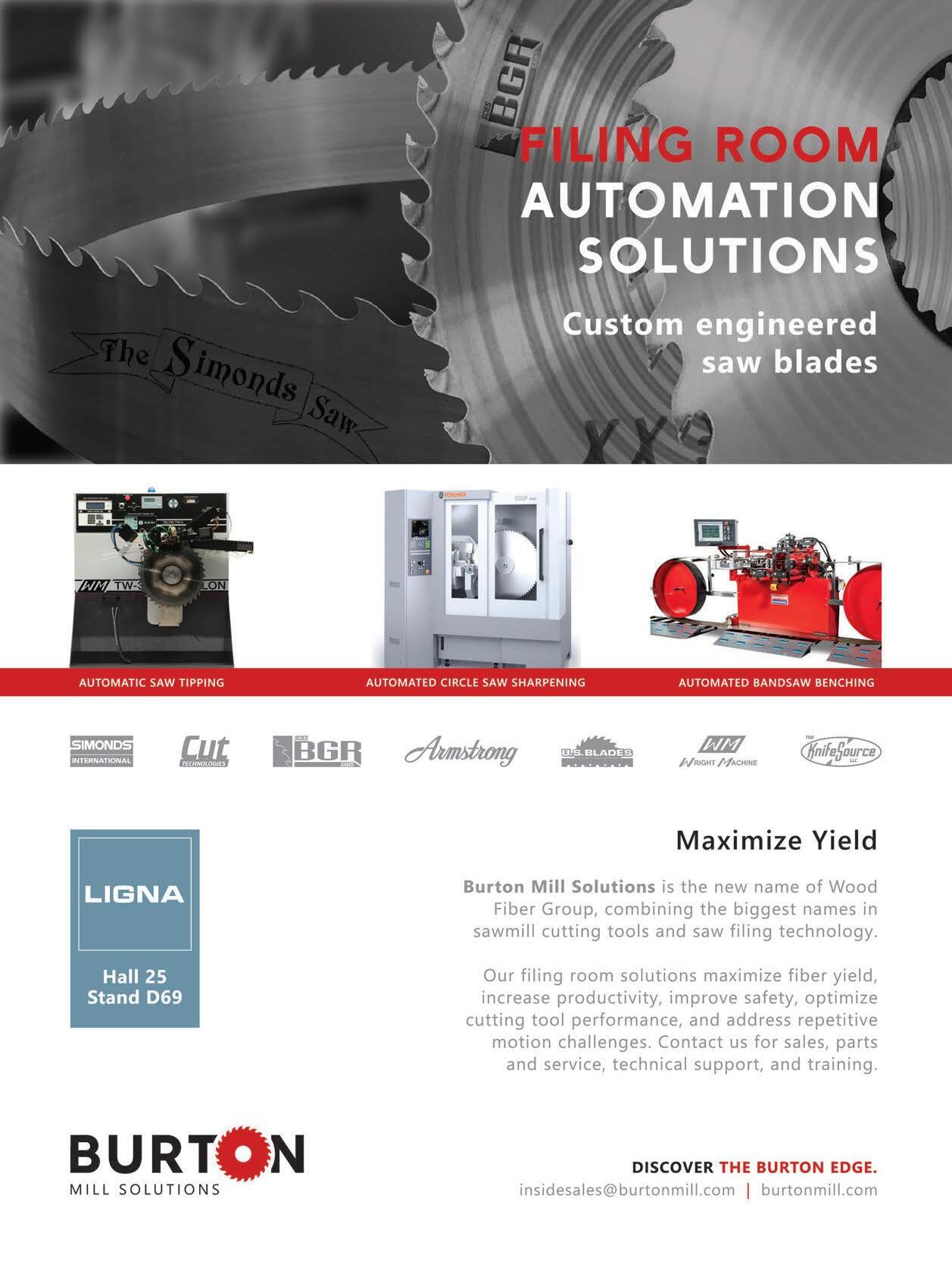
CLICK HERE IF YOU HAVE NOT ALREADY OPTED IN!
Hatton-Brown Publishers, Inc.
Street Address: 225 Hanrick Street
Montgomery, AL 36104-3317
Mailing Address: P.O. Box 2268
Montgomery, AL 36102-2268
Telephone: 334.834.1170
FAX: 334.834.4525
Publisher: David H. Ramsey
Chief Operating Officer: Dianne C. Sullivan
Editor-in-Chief: Rich Donnell
Senior Editor: Dan Shell
Senior Editor: David Abbott
Senior Editor: Jessica Johnson
Publisher/Editor Emeritus: David (DK) Knight
Art Director/Prod. Manager: Cindy Segrest

Ad Production Coordinator: Patti Campbell
Circulation Director: Rhonda Thomas
Online Content/Marketing: Jacqlyn Kirkland
Classified Advertising:
Bridget DeVane • 334.699.7837
800.669.5613 • bdevane7@hotmail.com
Advertising Sales Representatives:
Southern USA
Randy Reagor
P.O. Box 2268
Montgomery, AL 36102-2268
904.393.7968 • FAX: 334.834.4525
E-mail: reagor@bellsouth.net
Midwest USA, Eastern Canada
John Simmons
29 Bugelli Drive
Whitby, Ontario, Canada L1R 3B7
905.666.0258
E-mail: jsimmons@idirect.com
Western USA, Western Canada
Tim Shaddick
4056 West 10th Avenue
Vancouver BC Canada V6L 1Z1
604.910.1826 • FAX: 604.264.1367
E-mail: twshaddick@gmail.com
Kevin Cook
604.619.1777
E-mail: lordkevincook@gmail.com
International Murray Brett
58 Aldea de las Cuevas, Buzon 60
03759 Benidoleig (Alicante), Spain Tel: +34 96 640 4165 • + 34 96 640 4048 E-mail: murray.brett@abasol.net
Timber Processing (ISSN 0885-906X, USPS 395-850) is published 11 times annually (monthly except Jan./Feb.) by Hatton-Brown Publishers, Inc., 225 Hanrick St., Montgomery, AL 36104. Subscription Information—TP is free to qualified owners, operators, managers, purchasing agents, supervisors, foremen and other key personnel at sawmills, pallet plants, chip mills, treating plants, specialty plants, lumber finishing operations, corporate industrial woodlands officials and machinery manufacturers and distributors in the U.S. All non-qualified U.S. Subscriptions are $55 annually: $65 in Canada; $95 (Airmail) in all other countries (U.S. Funds). Single copies, $5 each; special issues, $20 (U.S. funds). Subscription Inquiries— TOLL-FREE: 800-6695613; Fax 888-611-4525. Go to www.timberprocessing.com and click on the subscribe button to subscribe/renew via the web. All advertisements for Timber Processing magazine are accepted and published by Hatton-Brown Publishers, Inc. with the understanding that the advertiser and/or advertising agency are authorized to publish the entire contents and subject matter thereof. The advertiser and/or advertising agency will defend, indemnify and hold any claims or lawsuits for libel violations or right of privacy or publicity, plagiarism, copyright or trademark infringement and any other claims or lawsuits that may arise out of publication of such advertisement. Hatton-Brown Publishers, Inc. neither endorse nor makes any representation or guarantee as to the quality of goods and services advertised in Timber Processing. Hatton-Brown Publishers, Inc. reserves the right to reject any advertisement which it deems inappropriate. Copyright ® 2023. All rights reserved. Reproduction in whole or part without written permission is prohibited. Periodicals postage paid at Montgomery, Ala. and at additional mailing offices. Printed in U.S.A.
Postmaster: Please send address changes to Timber Processing, P.O. Box 2419, Montgomery, Alabama 36102-2419
Other Hatton-Brown publications: Timber Harvesting • Southern Loggin’ Times Wood Bioenergy • Panel World • Power Equipment Trade
Volume 48 • Number 4 • May 2023 Founded in 1976 • Our 495th Consecutive Issue NEWSFEED TP&EE 2024 Dates Announced COVER: Georgia-Pacific regularly invests in its SYP sawmill at Gurdon, Ark., which is why it’s a keeper. Story begins on PAGE 10. (Jessica Johnson photo) 6 GP AT GURDON Always Going Strong 10 TURPENTINE PART THREE Worker Conditions Were Less Than Ideal 50 LIGNA PREVIEW German Show Is Gearing Up 18 PLANER MILL BONANZA New And Upgraded Technologies Abound 62 MACHINERY ROW Greentree Reworks Log Breakdown 76 AT LARGE Binderholz Celebrates Enfield 78 Renew or subscribe on the web: www.timberprocessing.com A Hatton-Brown Publication VISIT OUR WEBSITE:www.timberprocessing.com
CLICK HERE IF YOU HAVE NOT ALREADY OPTED IN!
Dan Shell Senior Editor
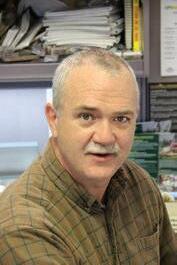
LUMBERING ALONG WITH JAMES OLIVER DUNN

Some of my very first memories are playing around my grandmother’s house located on a county road in Brushy Creek, Ala., which is a suburb of East Chapman, Ala. (that’s a joke), located of course adjacent Chapman, which is no longer a town but primarily the Boise Cascade Chapman mill site, though the small community around it clings tenaciously to the tiny post office out on Hwy. 31. In fact, the county road where my father grew up dead-ended into the W.T. Smith Lumber Co. log yard, and both sides of my family had various relationships with the mill and its owners that go back well over 100 years.
As a result of family formulations and demographics, my parents became a repository of sorts for what is likely several thousand family photos, letters, documents, etc. And when I say thousand I mean a mountain of material that’s more easily measured in pounds than pages: boxes of cartons filled to the brim. With my parents’ passing in the past two years all this has come into my hands, and much of it is related to life and work in the piney woods of Butler County in south central Alabama. Things like a boxful of dozens of “courting” letters between my grandmother and grandfather—who eventually became the roads crew supervisor for Rocky Creek Logging, a W.T. Smith Lumber subsidiary—when he was living and working in the legendary Logtown. Miss. on the banks of the Pearl River. Some of the letters have really neat old Victorian nosegay cards in them, and from what I can tell my grandfather spent a lot of letters apologizing for various things. But what do you do with this stuff? Right now the plan is seal it into my attic and let my kids worry about it one of these decades.
So as we’re boxing and packing trying to get their house ready to sell, an envelope pops out: an interview with James Oliver Dunn, my maternal great grandfather who went to work for the McGowin family at W.T. Smith Lumber in 1908 and worked in the planer and molding operations for 43 years. The interview ran in Lumbering Along, the company paper for the company town that Chapman was way back when, in November 1951. My family still has a nice collection of Lumbering Alongs that have been donated to the Hatton-Brown Publishers industry archives, and each issue gives amazing insight to life and work in the Deep South during the postwar era.
The McGowins were just getting started with W.T. Smith Lumber and had bought Dunham Lumber just south of the mill, and the former owners had recommended ol’ great granddad as a good planer mill specialist. He had received the job offer third hand through a rural telephone system that included sending his brother out to tell him about it.
W.T. Smith was having lumber quality problems. Greeley McGowin told Dunn he could have the job if he could keep it. Great granddad told him the first hour they were dissatisfied with his work he was gone. “I waited here forty-three years for somebody to tell me to get going,” he said.



The company also bought out Empire Lumber in Andalusia, and Dunn went there to finish up the mill run as the Chapman site expanded: three sawmills, a veneer mill, a “terrible big” stave mill, a big turpentine still and a big box plant all running here at the same time.

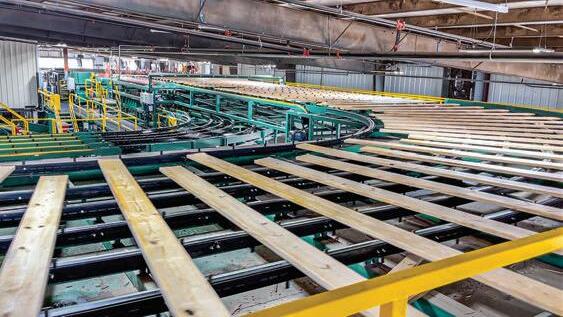
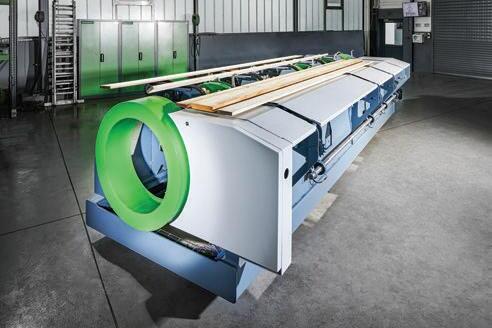
This was the last couple decades of steam power and the daily cacophony that accompanied it was part of the rhythm of life around the mill, Dunn explained: “There used to be the most racket here. Everything was operated by steam power. Every one of those mills had a call whistle. It took at least thirty Contact Dan Shell, ph: 334-834-1170; fax 334-834-4525; e-mail: dan@hattonbrown.com
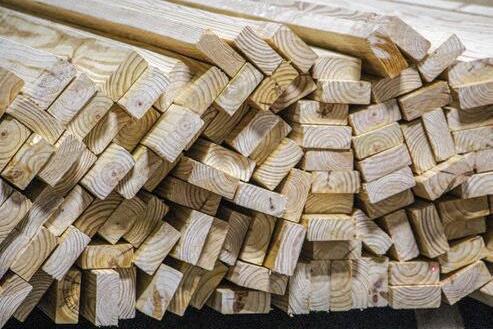
10 18 50 62 THEISSUES
TIMBER PROCESSING ■ MAY 2023 ■ 5 ➤ 86 CLICK HERE IF YOU HAVE NOT ALREADY OPTED IN!
NEWSFEED
TP&EE SHOW DATES SET FOR 2024
Hatton-Brown Expositions LLC announces that the next Timber Processing and Energy Expo (TP&EE) will be held September 25-27, 2024 at the Portland Exposition Center in Portland, Ore. The 2024 show will be the sixth biennial TP&EE to be produced since 2012 by
Hatton-Brown Expositions, LLC, an affiliate of Hatton-Brown Publishers, Inc. and of Timber Processing, Panel World and Wood Bioenergy magazines. All of the TP&EEs have been held at the Portland Exposition Center. (The 2020
More than 1,200 representatives of 112 wood products producer companies and hundreds of individual lumber, veneer, plywood, engineered wood products and wood pellet mills registered for the 2022 TP&EE. They viewed 170 exhibitor companies who displayed their equipment and technologies in a soldout Hall E.

While the show has traditionally emphasized lumber manufacturing, the 2022 event revealed increasing attendance from the veneer, plywood and EWP industries. And since the 2022 show, several announcements have emerged indicating a growing wood biomass industry in the Northwest, including several planned wood pellet facilities. This means that the 2024 event should truly live up to its Timber Processing & Energy Expo billing! Meanwhile several lumber and plywood mill expansion projects are in the works, such as Sierra Pacific Industries in Eugene, Ore. and Roseburg at Coquille, Ore. and Riddle, Ore.

“We realize that the city of Portland continues to receive negative publicity for various reasons, but in the end the Portland Expo Center remains the best site because of its spacious equipment staging and move-in capacities—compared to other facilities we’ve looked at—as well as its centralized location for the Northwest forest products industry,” comments Show Director Rich Donnell. “The Portland Expo Center, after coming through the pandemic, is again filled with events all during the year. And just across the Columbia River only a few miles north from the show site is the ever-bustling city of Vancouver, Wash., where more exhibitors are hosting hospitality events after the show.”
The 2024 first stage of the TP&EE exhibitor space renewal program has begun. For exhibitor information, contact Jessica Johnson: jessica@hattonbrown.com.
6 ■ MAY 2023 ■ TIMBER PROCESSING
CLICK HERE IF YOU HAVE NOT ALREADY OPTED IN!
TP&EE drew personnel from 112 wood products producer companies in 2022.
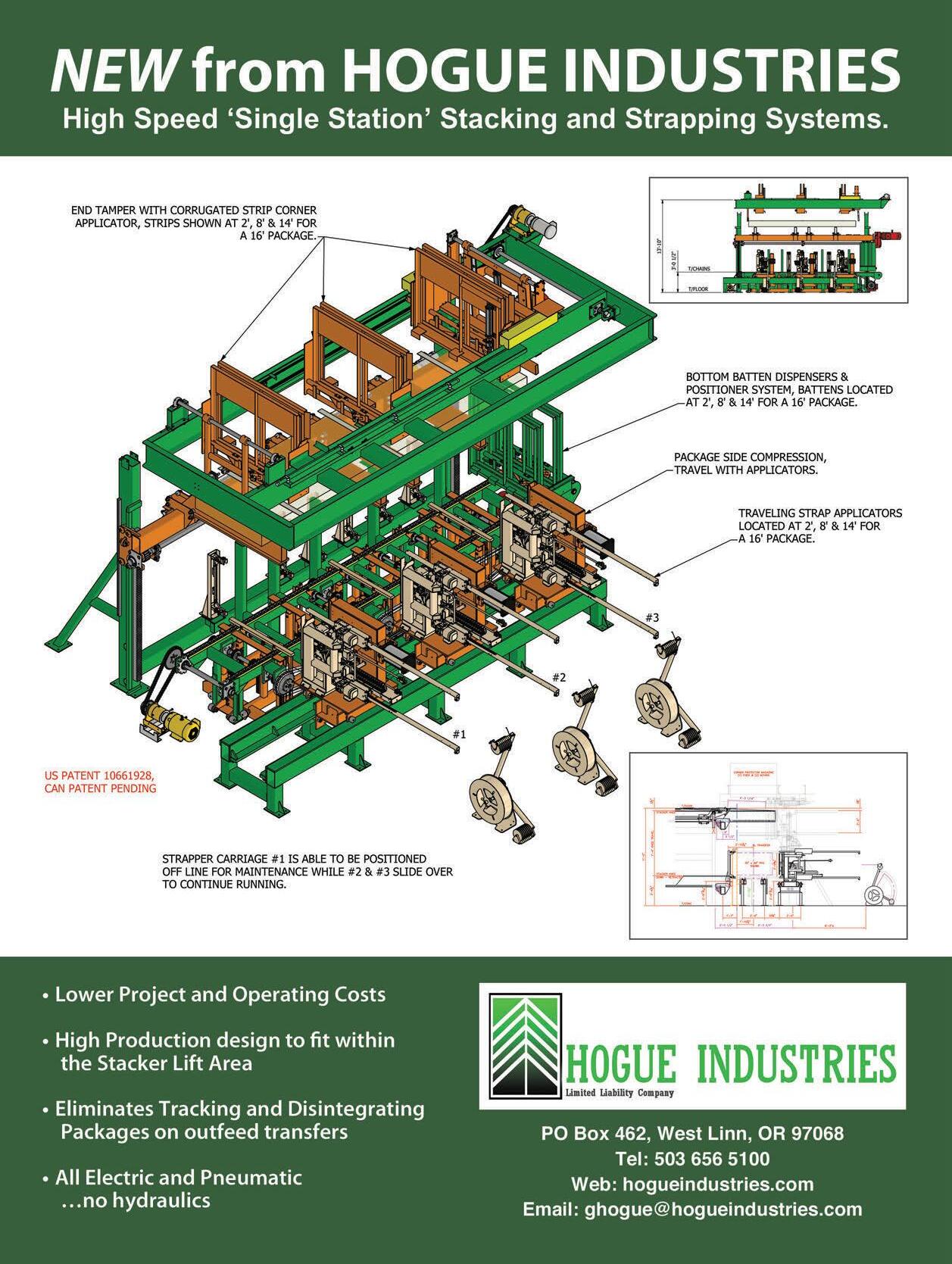
CLICK HERE IF YOU HAVE NOT ALREADY OPTED IN!
SYP SHIPMENTS SHATTER RECORDS
Shipments of southern pine lumber recorded an increase in 2022 from the previous year for the 13th consecutive year, according to the Southern Forest Products Assn., which tabulates shipment totals with the Southern Pine Inspection Bureau (SPIB) and Timber Products In-

spection (TP). The 2022 total also marked the third straight year of shipments above the 20 billion BF mark, starting with 20.8 billion BF in 2020.
Shipments in 2022 totaled 22.16 billion BF, a 5.5% increase over the volume shipped in 2021 (20.93). They have been on an increase since 2009, when shipments totaled 11.79 billion BF, down from 14.57 in 2008.
“If there’s any question about the demand for southern pine, the 2022 shipment report confirms its popularity among design and construction professionals. It also supports the message that, as a naturally renewable resource, wood is the most environmentally friendly, easily accessible, and among the most trusted materials available for building homes or businesses,” comments SFPA Executive Director Eric Gee.

The 2022 record is the longest consecutive growth in shipments since recordkeeping began in 1915. The next closest stretch of consecutive growth was a five-year span from 1974 (6.92 billion BF) to 1979 (9.28) followed by three four-year spans: 1980 to 1984, 1991 to 1994, 2001 to 2006.
BYPRODUCTS LOOK TO PELLET MILLS

In March Enviva Inc. received its construction permit from the Alabama Dept. of Environmental Management (ADEM) for its Epes plant under construction in Sumter County, Ala. The revised permit enables Enviva to build a state-of-the-art industrial wood pellet manufacturing facility at a brownfield site.
In 2020, Enviva acquired more than 300 acres of land on the coast of the Tombigbee River in Sumter County for its forthcoming Epes plant. The Enviva Epes site location resides on the former manufacturing site of a wood products company that had closed in recent years.
“Enviva is excited to repurpose a former business site and construct a brandnew state-of-the-art manufacturing facility, jumpstarting economic growth and bringing employment opportunities back to the community,” comments Thomas Meth, President and CEO of Enviva.
Enviva has been active in Sumter County since its initial assessment of the site in 2018. Enviva has part-
NEWSFEED 8 ■ MAY 2023 ■ TIMBER PROCESSING
➤ 83 CLICK HERE IF YOU HAVE NOT ALREADY OPTED IN!
SYP lumber production capacity continues to grow with new mill operations such as Biewer Lumber at Winona, Miss.

CLICK HERE IF YOU HAVE NOT ALREADY OPTED IN!
MAKING
IT WORK
By Jessica Johnson
GURDON, Ark.
Like many manufacturing complexes of a certain age, GeorgiaPacific’s Gurdon site serves multiple purposes. Having started out solely as a plywood plant with a hog making chips for paper, the site has come a long way in its history. The sawmill was an afterthought, built so buyers could get wood cheaper. As the industry, GP and the markets have changed since 1978, so has Gurdon Lumber. Gone
are the days the facility just subsidizes its plywood big brother with a single shift. Now, the 230MMBF two-shift sawmill shines on its own—including a large infusion of capital designed to help both mills run better.
Though the sawmill has stepped into the sun, it still has some remains of its humble beginnings, which include the shared wood yard. For 15 years, Mill Manager Mike Hamill says Gurdon Lumber has been on a journey to improve. A
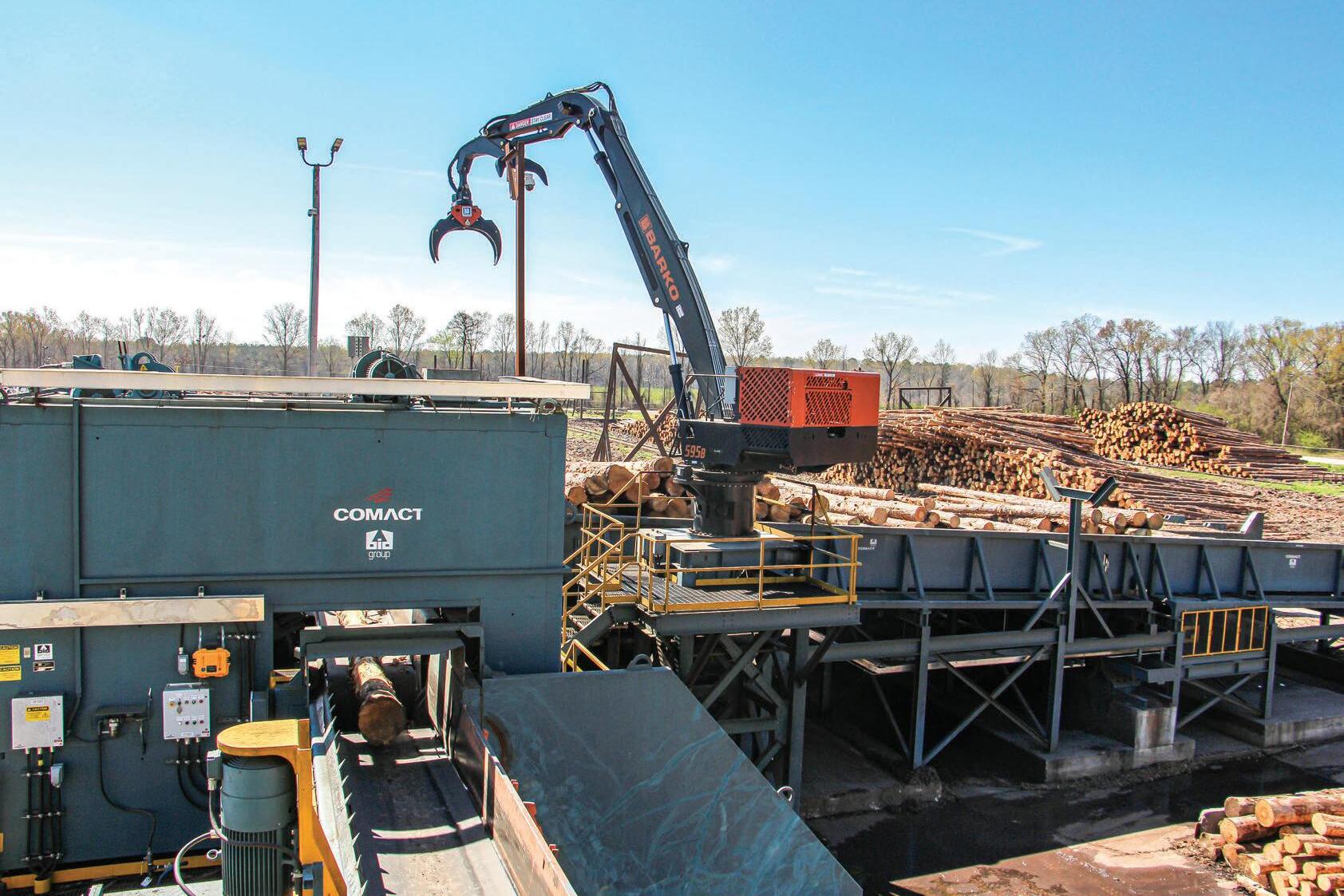
Georgia-Pacific’s Gurdon manufacturing complex is home to both a plywood plant and a sawmill, where the wood yard feeds both.
CLICK HERE IF YOU HAVE NOT ALREADY OPTED IN!
planer project in 2015 really reinvigorated production rates. But, still the mill struggled. The bottleneck was the wood yard. Having to feed both fully operational sites put a lot of stress on the vintage equipment. So, as 33-year Gurdon veteran (and Wood Yard Superintendent) George Boyette says, the third time was the charm. After completing plans and working with vendors not once, not twice, but three times, Gurdon got the go ahead and awarded Comact, through BID Group, a merchandiser line project in 2020.


This new merchandiser had a tall order feeding both, but it replaced a machine that had originally been installed to help cut pulpwood for a drum debarker to ultimately make paper chips. A huge driver of the project was the possibility of what the sawmill could produce if it had the right tools. Hamill says that the timing of the project was really good for the mill, and the mill was able to lean heavily on
its veterans to help with smoothing out project completion wrinkles.
“The industry skill sets are diminishing,” he adds. “You don’t have a lot of people that have been at the same facility for 30 or 40 years. Despite the loss of long-tenured employees, we had a successful startup. In fact, it was probably one of our best projects.”
One such wrinkle that was quickly figured out was how to keep both facilities going during site prep. Boyette and his crew mounted a small Barko on the top of the deck to help fill the gaps. “It was tough,” he concedes, “They blocked us
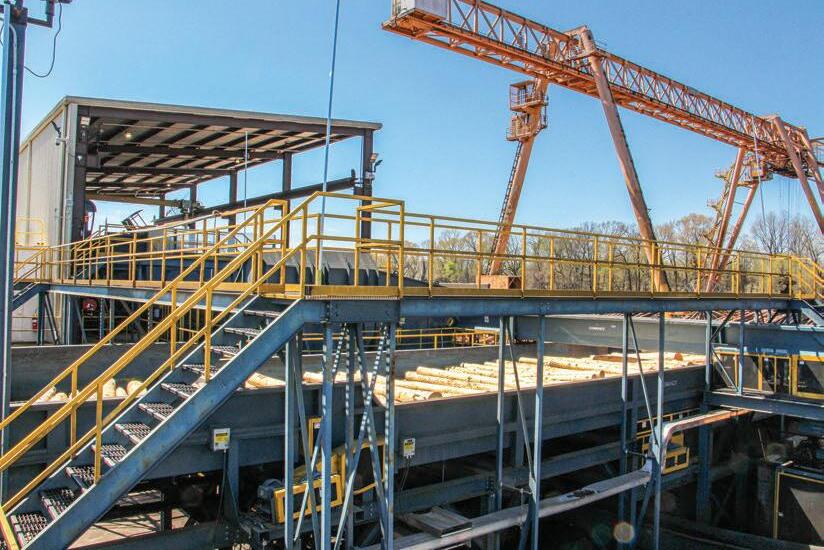
off we had to come up with ways to keep the wood flowing.”
However, even though the project went smoothly, there were a few learning curves. Looking back Hamill says despite flow issues related to programming, and a few additional mechanical modifications, the project and the team knew what needed to be done and did it. He adds with pride that BID has said the Gurdon team runs the merchandiser better than many others. “I tie that to the mill team’s experience. They had an old Model T and now they have a Ferrari.” For James Meeks, day shift wood yard
TIMBER PROCESSING ■ MAY 2023 ■ 11
Breakdown saws handle both logs and cores from the plywood plant.
CLICK HERE IF YOU HAVE NOT ALREADY OPTED IN!
The wood yard feeds both the Gurdon sawmill and plywood plant.
supervisor and a 42-year Gurdon Lumber veteran, the metaphor brings a huge smile to his face.

Meeks agrees with Boyette that the project was a challenge, but everyone could see the end and what it would be like—and that helped everyone push forward. Relief operators were brought in on day shift to help keep wood moving throughout the complex, while day shift operators would spend time with the programmers to train, get the bugs worked out and make needed adjustments. Utilizing the camera systems at sister sawmills throughout the GP portfolio, operators were also able to train remotely by reviewing how things worked in real-time.

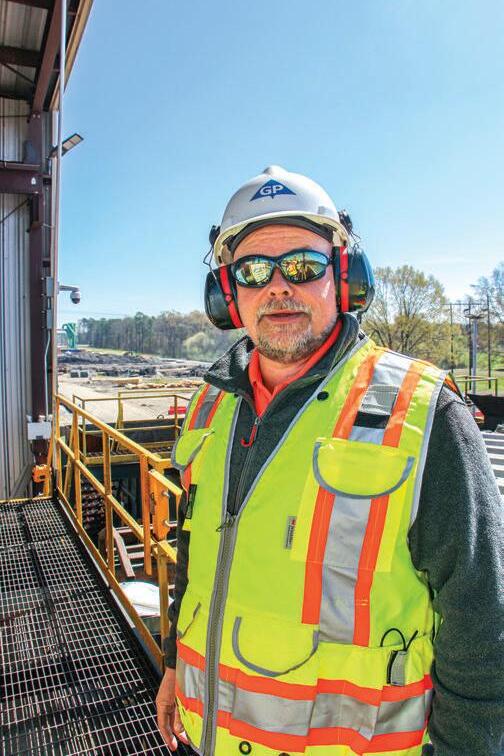
In all, the project took a lot of pre-planning which ultimately resulted in only five
days down and an on time startup. The amount of work completed in those five days was impressive. But even more impressive for Boyette and his team was during morning meetings when the sawmill team quit saying, “out of logs; out of logs; out of logs.” Now, it is the reverse, the wood yard can outrun the sawmill. Hamill says he remembers clear as day the first time Boyette said it—within a month of startup the wood yard was rolling.
The Warrenton, Ga. GP site’s realtime cameras were especially helpful to Meeks and his operators to get a feel for the big screen and multiple cameras to watch. It is completely different from how it was done before, so Hamill, Boyette, Meeks and the operators were clear they wanted to be as prepared as
has been a huge help to the operation.
Hamill says, “Looking back, there are things I see now I wish I had done differently, but every project you do is like that. This really made an impact for Gurdon. Gurdon has always been on a journey to improve. If you look back 10 years, we have constantly been improving, first getting up to 200MMBF and over the last few years increasing 2030MMBF. They have worked through some hard things and come out on top.”Undertaking a project of this scale was not only complicated for the Gurdon on-site crew, but also for the Georgia-
12 ■ MAY 2023 ■ TIMBER PROCESSING
Mill Manager Mike Hamill, left, with day shift wood yard supervisor James Meeks
CLICK HERE IF YOU HAVE NOT ALREADY OPTED IN!
Wood Yard Supervisor George Boyette
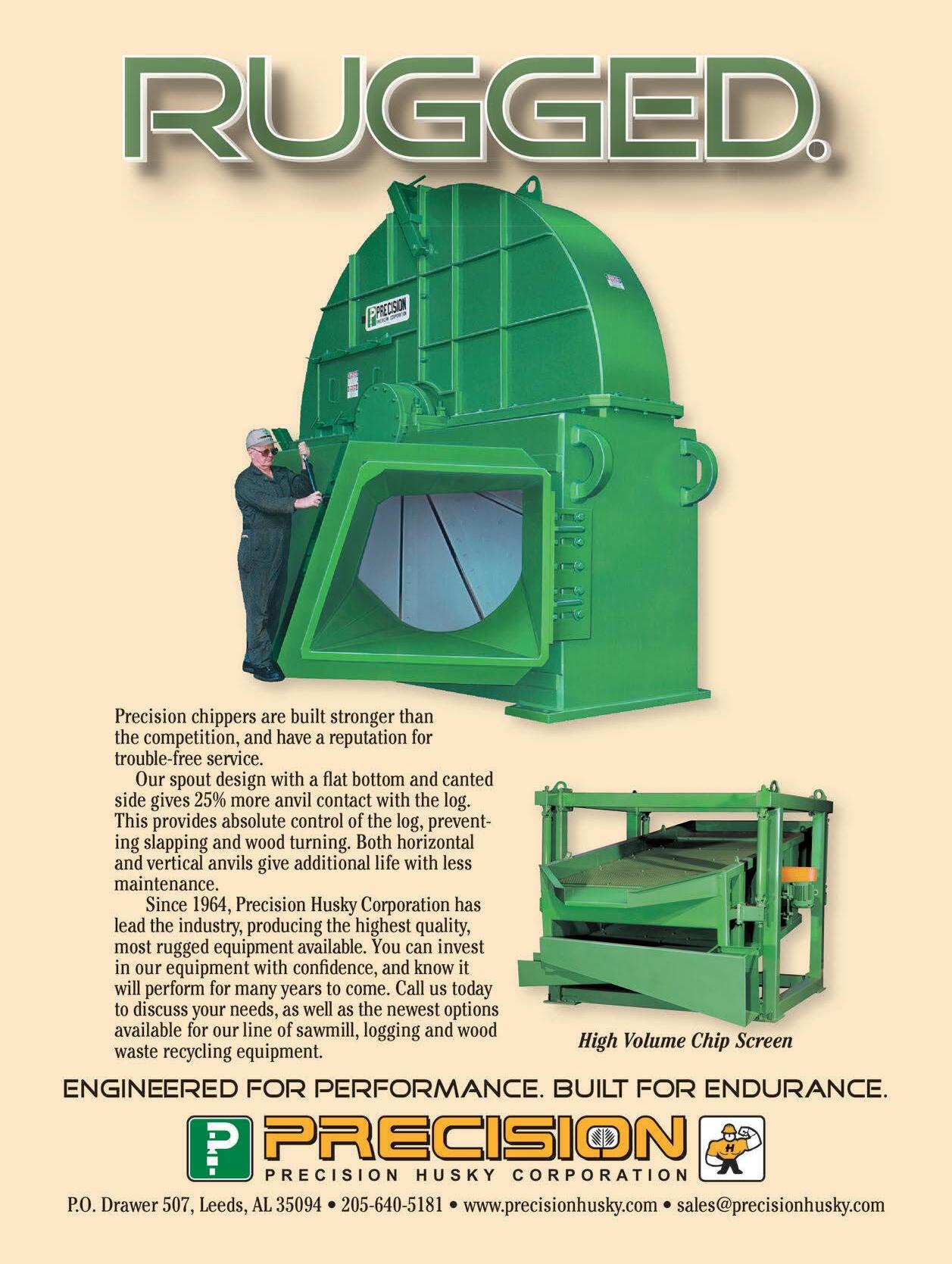
CLICK HERE IF YOU HAVE NOT ALREADY OPTED IN!
Pacific engineering groups, especially Devante Brown, and the entire BID Group team. Completing it during unprecedented times, while still remaining on track is quite the accomplishment.
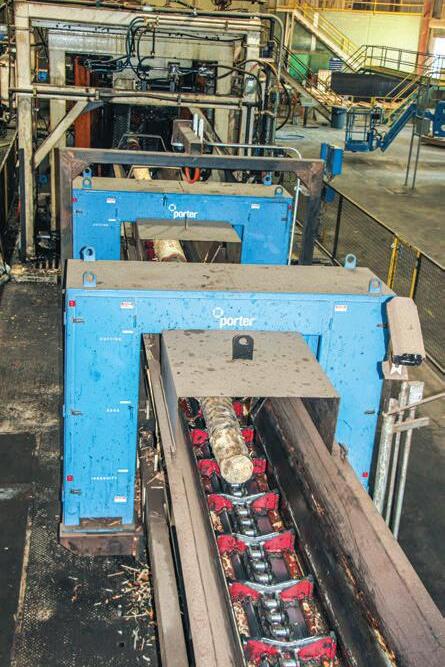

PUSHING AHEAD
Solving the wood flow into the mill has created new bottlenecks for Gurdon, specifically with the sawmill itself after making a few changes to the kilns, planer and of course merchandiser. Hamill says the team will figure out ways to continue to improve the bottlenecks. “The key,” he says, “is having people to think through the problems and find the solutions. It is not always capital. Everything we’ve got, people can buy. It’s not top secret but what makes it successful is the people and how they take what they have and how they win.”
For Hamill and his team, the wins have been huge, but he is never satisfied. He uses that to push everyone to be better. Keep changing and getting stronger—all the time. It’s been an uphill battle at times because it can be hard to motivate employees, especially for the wood yard where they knew they were going to “lose” each day, Boyette says.
“It is hard to try to keep and motivate your employees when the deal was you were going to lose. You were not going to win. Our wood yard was not winning. You

14 ■ MAY 2023 ■ TIMBER PROCESSING
CLICK HERE IF YOU HAVE NOT ALREADY OPTED IN!
Primary breakdown scanning supplied by Porter Engineering
were going to run out of logs, and you were not going to keep up. That was the number one thing, keep everyone upbeat even though we’re getting our tail kicked. Now we’ve got the new merchandiser, we kick back!” Boyette says triumphantly.
Hamill simply says what is a motto for Gurdon: “The process of never giving up.”
PEOPLE POWER
Meeks points to the culture of Gurdon’s employee base—where both he and Boyette first started—as one of innovation and to always come out as victorious as they could.

Hamill says the planer team is another example: Give them data on run rates with a given product and they will work on trying to find ways to improve. Those constant conversations are what led Hamill and team to figure out why the motors on their saws were burning up. The maintenance team took one apart and discovered the breaking coil didn’t have enough insulation, causing it to short. A local rewind shop applied epoxy as insulation and Gurdon was able to extend the life of the motor. When the vendor came on-site, Hamill and the team explained what had been happening and how they fixed it. “He wasn’t really sure if it was a QC issue at their facility or not,” Hamill remembers of the exchange. “Every time we had a new motor come in, we sent it for epoxy. One day the shop calls and says, ‘this one is already done,’ so the vendor evidently got it right.”
Though obviously very cognizant of the need to push innovations to get production, Hamill is as equally mindful of his 175 employees. Coming out of COVID, he knows things have changed, and maintaining a work/life balance for the employees is important to him. “Our team feels this way and I want this to be the place people want to come to work,” he emphasizes.
After an employee survey, Hamill learned that many (including himself) drive at least an hour plus to get to the mill. With a commute like that in a rural area, it makes 12 hour shifts somewhat unattractive to new talent. So, Hamill adjusted as he could to the sawmill work schedule to accommodate it. “All leaders should care about people. If you don’t care about people, you aren’t a leader, you’re a boss,” he believes.
PRODUCTION
Though of course Hamill has projects he would like to do to bump up volume, Gurdon can hold its own within the GP
portfolio at 230MMBF with a consistent mix of 2x4s through 2x8s, with plywood cores being sawn into 4x4s.
A vintage crane (serviced by Kone Machinery) unloads trucks, and a 988 wheel loader feeds logs onto the new stem deck. The entire new merchandiser line is a turnkey installation supplied by BID Group, with exception of the bark hog, which was provided by Valon Kone. The stem deck feeds into the debarker, where logs travel to the scanner to make a solution. Logs kick off into chains that feed the merchandiser saws. Since the
system feeds both plywood and lumber, the scanner first finds the “start length.” Logs 10 in. and smaller are for the sawmill, larger goes to plywood. Once logs are merchandised, they fall to a second belt with an hourglass roll design and individual gearbox combination. Hamill notes this design was intended to mean quicker recovery if it fails. Though Gurdon has not had any issues, the team claims the design as a big win since it was birthed after a discussion on possibly opportunities for innovation.
Logs for the sawmill land into a

TIMBER PROCESSING ■ MAY 2023 ■ 15 CLICK HERE IF YOU HAVE NOT ALREADY OPTED IN!
pocket, then a belt feeds a log roundtable. At the roundtable logs make a 90° turn in order to get the right positioning for the breakdown. Then it is pretty standard, Hamill says of the facility. Using two decks to feed the primary breakdown from Optimil, logs pass Porter scanning before meeting the DLI with bands and chip heads, which according to Hamill cuts well and is incredibly productive. Edger is vintage (oldest part of the sawmill, serviced now by USNR) and now that’s to a certain degree the bottleneck. “We’ve done
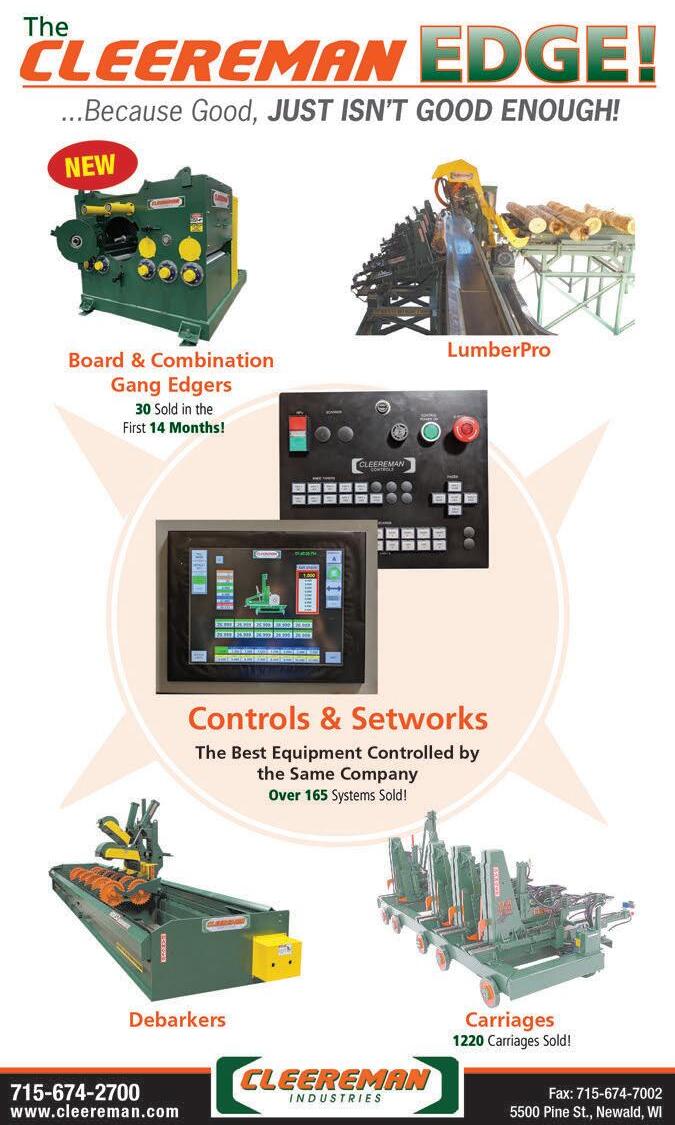
a lot of work on it lately, but it is still tough to keep up,” Hamill admits. Sideboards go to the edger. Cants come out and land on a deck before passing another set of Porter scanners.
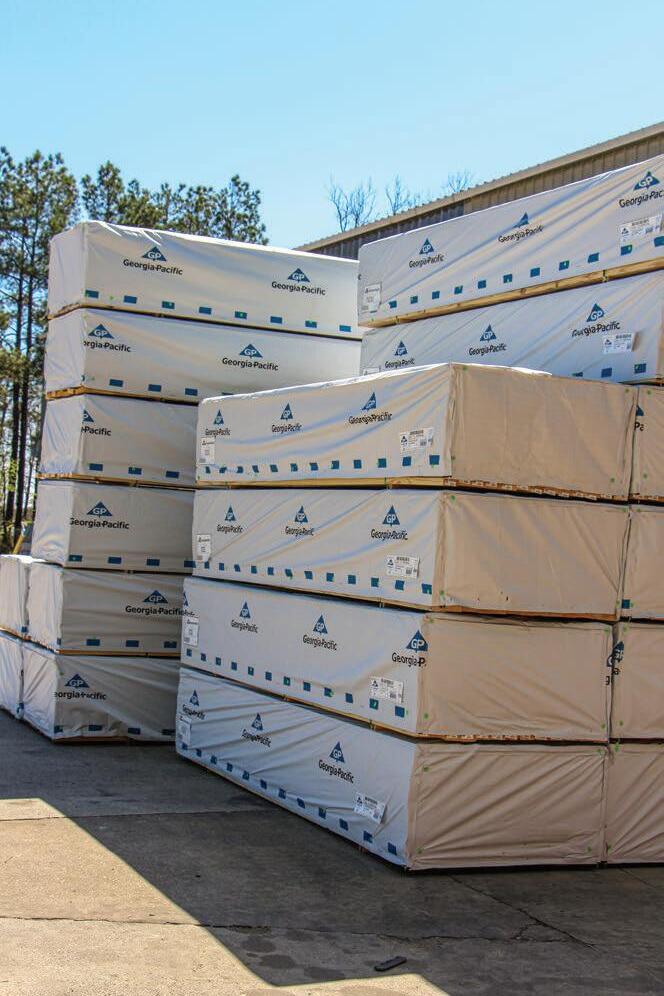
Then cants are centered up and go to a USNR curve-sawing gang, with lumber flowing out to a landing table ahead of the trimmer infeed table. These are all Newnes systems, including the old revolving lug loader, another project Hamill would like to do to increase productivity, which feeds into an older USNR scanning system.
Wellons and KDS Windsor. Two of the kilns are gas-fired; one is a modified batch kiln that uses steam.
With the wood yard handled for the moment, the bottleneck was the kilns. The approach for Hamill and the team was the same with the kilns as it was with all other issues and projects: Identifying the root cause of the failures, talking it through, asking more questions and figuring out what can be done. By figuring out the dynamics, Gurdon was able to make one small adjustment that completely changed the productivity of one kiln so much that it had to be throttled back to not exceed permitting.
“In our industry so many times, we say ‘gotta have capital. . .can’t do anything without capital.’ We gained four cants a minute in the sawmill without a lot of capital, just understanding some of the things that were causing slowdown,” Hamill says. “We can fix things better if we understand why they are broken.”
T P 16 ■ MAY 2023 ■ TIMBER PROCESSING
CLICK HERE IF YOU HAVE NOT ALREADY OPTED IN!
Gurdon production increased to 230MMBF with key projects.

CLICK HERE IF YOU HAVE NOT ALREADY OPTED IN!
EDITOR’S NOTE: The following companies submitted these editorial profiles and images to complement their advertisements placed elsewhere in this issue with regard to the Ligna event in Hannover, Germany, May 15-19. Please refer to those advertisements for web site and contact information. All statements and claims are attributable to the companies.
BARTON MAQUINARIA
Barton Maquinaria, S.L. is a family-owned manufacturing company with more than 60 years of experience in the sawmill industry. From its headquarters located at Valga (Pontevedra) in Galicia (a northwest region of Spain well known because of its forest), Barton Maquinaria designs and manufactures sawmill solutions that are used all around the world.
Barton Maquinaria has modern manufacturing facilities and a highly qualified human team for PLC programming and technical remote support, so important when it comes to after sales service.
At Barton we are always ready to provide the best possible technical solution to meet the needs of our customers. Regardless of the climate or the type of wood, your process or your volume of production, Barton will be ready to give you an answer. The dialoguing phase with our customers is an essential part in the innovation of our products. We greatly value your practical experience.
Barton Maquinaria is taking part in industry conventions and machinery expositions in Germany, Poland, India, Italy, Portugal and Spain as a strategy to give more visibility to the company and as a meeting point with both existing customers and new potential customers.
We are very proud of the achieved technical level of our Independent Columns log carriages. Available in vertical or tilted versions, with pneumatic or hydraulic hooks, these log carriages are fast and precise. Durability and reliability are standard features.
Our log carriages are suitable for all type of woods, from softwood to exotic wood. We will take care of configuring the machine according to the wood to be processed.
In the picture shown is our log carriage with 3 independent columns, Model CPTH-3B4 ECOBAR, with hydraulic hooks and hydraulic turning system, suitable for exotic wood.
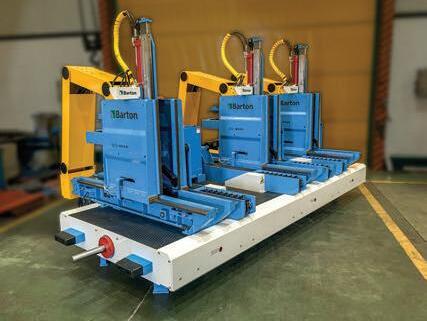
Our band saw headrigs, with double side cutting technology and driver to control the cutting speed (optional), will meet your cutting needs regardless of the wood that you need to cut.
Of course, at Barton Maquinaria we also take care of the design, manufacture and installation of all the necessary mechanizations: dosing chains, roller conveyors, firewood evacuation systems, etc..., which, together, will allow us to get the most out of our log carriages.
Hall 25, Booth H22
BRUNNER-HILDEBRAND
Brunner-Hildebrand is Germany’s leading kiln dryer manufacturer complemented by a U.S. branch operating out of Nashville, Tenn. Their newest development in kiln drying technology is labeled “HCK” for Hildebrand Continuous Kiln with lumber transport in longitudinal direction. Lumber packages may be arranged on several kiln tracks with actuation of the kiln carts performed in uniflow mode.
Brunner-Hildebrand will be installing four HCKs at PATA in Jekabpils, Latvia. PATA is the leading forest management, lumber production, logistics and trade company in Latvia. They focus on sawmilling, logging, round and sawn lumber trade as well as forest-derived biomass energy and financing solutions. PATA’s overall mission is creating a forest industry ecosystem where all the stakeholders, from forest owners to end consumers, not only develop individually and gain added value, but also lay the groundwork for sustainable development in the future.
In 2021, PATA decided to choose Brunner-Hildebrand to supply four continuous kilns for their greenfield project at Jekabpils, about 85 miles southeast of the capital city Riga. After thorough examination, the order was placed with Brunner-Hildebrand due to the combination of high KD output and superior energy efficiency the German company is able to provide.
The continuous kiln purchase is part of a large investment in a state-of-the-art sawmill in central Latvia for producing high-grade lumber made from local wood supply. More than 80% of that lumber will be delivered to the United Kingdom, France, Belgium, Sweden, Finland, the U.S., and others.
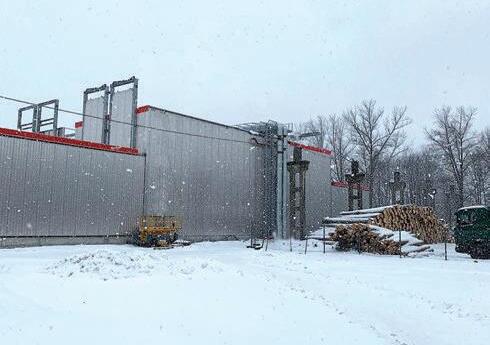
The Hildebrand continuous kilns at PATA are designed as dual-track kilns with six individual drying zones. Indexing of kiln carts on the tracks may be performed independently for each track, thus making the kilns suited for simultaneous drying of different lumber dimensions. In terms of air velocity, drying temperature and climate, each of the six drying zones is designed for reaching the specific drying goal in that section. Drying capacity for 1 ½ in. spruce and pine mix will be approximately 17MMBF per year.
Drying is performed in cycles with each kiln cart resting in the respective drying zone for an optimal time span as computed by the control system. When the cycle time has run out, a powerful hydraulic pusher system advances the entire lumber load by one drying
18 ■ MAY 2023 ■ TIMBER PROCESSING LIGNA CLICK HERE IF YOU HAVE NOT ALREADY OPTED IN!
Barton Maquinaria log carriages are fast and precise. Brunner-Hildebrand HCK drying technology
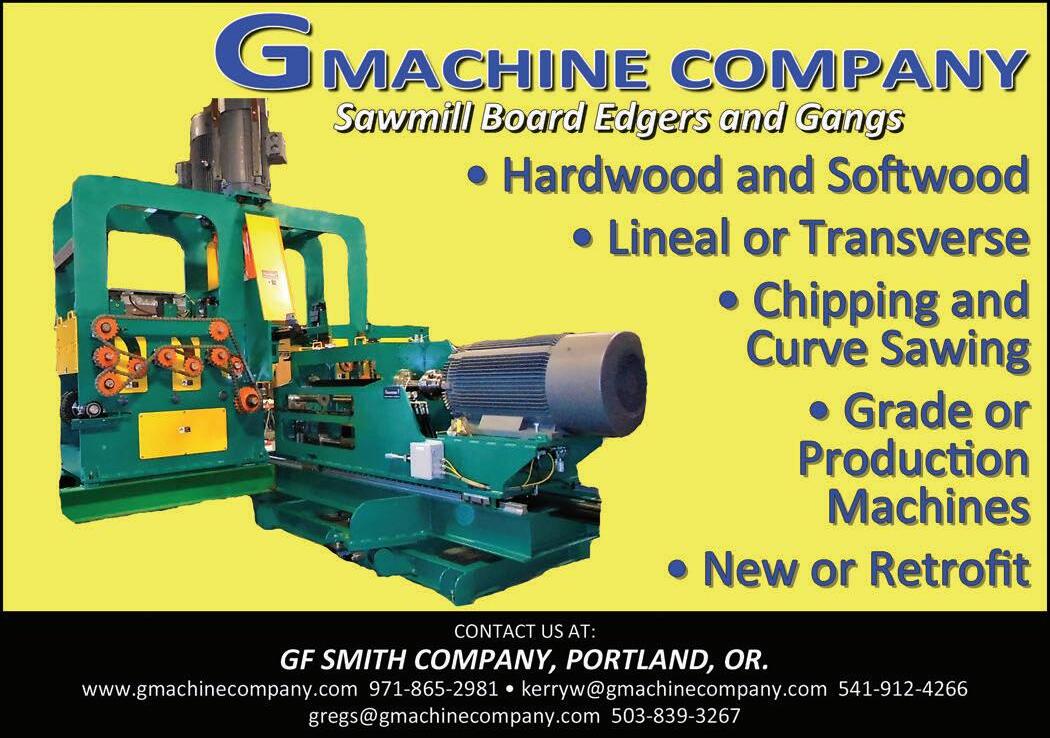
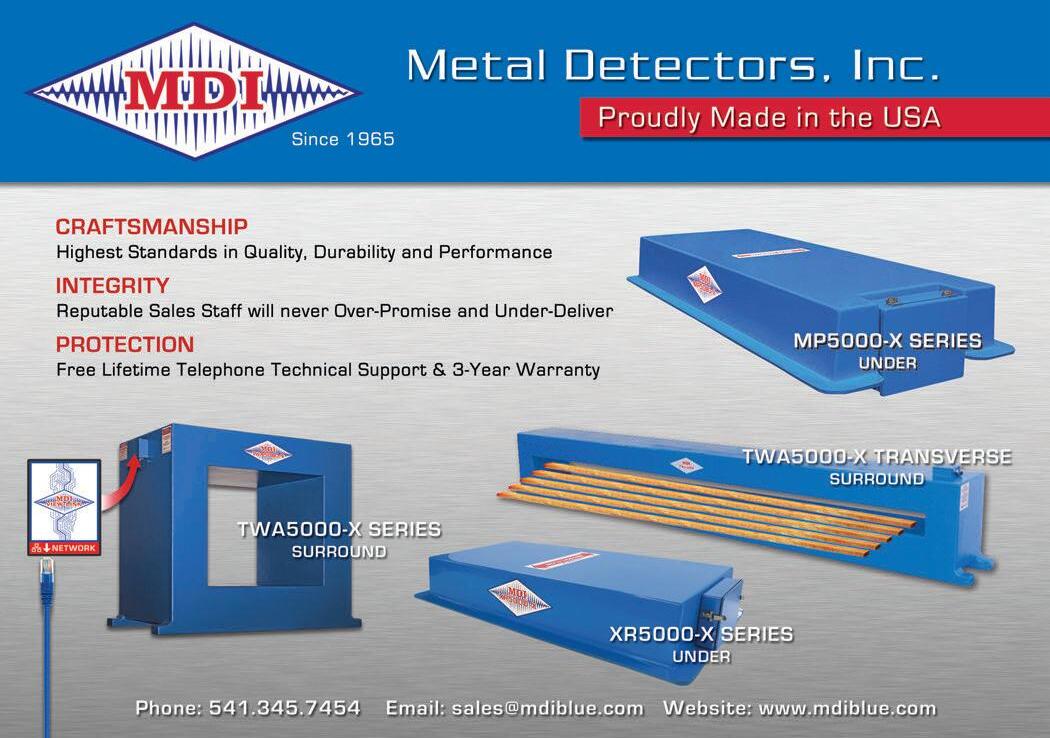
CLICK HERE IF YOU HAVE NOT ALREADY OPTED IN!
section. This allows for the use of vertical lifting doors on both sides of the continuous kiln, reducing heat loss through the door openings to the minimum.
Unidirectional flow of lumber makes for clear distinction between wet side and dry side in the mill layout and helps minimize costly forklift transport. PATA’s long-term objective is direct linkage of the kilns’ transport system to the sawmill’s stacking machines.
Brunner-Hildebrand’s patented GreenKilns system makes the drying zones work together in a thermal compound where excess heat from one drying zone is guided to another one with actual demand for extra energy. Combined with powerful cross-flow heat exchangers, this system establishes a level of energy efficiency that was previously unknown in continuous kiln drying.
Hall 25, Booth M21
CARBOTECH
Carbotech is a specialist in the manufacture of sturdy equipment for sawmills, planer mills, and other businesses that need reliable, long-lasting technical solutions for their operations. It strives to provide optimal equipment and solutions that contribute to their clients’ success.
Thanks to its 35 years of experience, Carbotech is renowned as an innovator in the manufacture of lumber handling solutions. The company constantly invests in R&D to make its equipment more efficient and reliable while continuously improving the industry.
Recently, Carbotech has used its solid expertise to enter a new market—log handling, with the recent addition of the Stream Feeder to its lineup. Designed to improve efficiency, productivity and, ultimately, profitability, it is ideal for any process that needs to unscramble logs before they head to a log merchandiser, log sorting system, debarker infeed, or primary breakdown infeed.
• Autolog—optimization and automation of the wood processing industry

When Carbotech acquired Autolog, which has 35 years of knowledge and expertise in sawmill optimization/automation technologies, it took a big step toward offering a truly comprehensive range of turnkey solutions for the industry. Autolog provides solutions to the wood transformation industry for businesses of all sizes, from large corporations to small entrepreneurs.
Autolog started its journey by offering industrial controls such as lumber sorters to reduce head count and streamline operations. It has since become recognized worldwide as a pioneer in wood processing optimization. It offers solutions for every part of the sawmill processes, including log merchandisers, log sorting systems, breakdown equipment, board edgers, trimmers, sorters, and stackers. It also offers innovative solutions for optimizing planer mills, such as the well known ProGrader, the fully automatic grading system using AI, and for automating their processes.
For Carbotech, acquiring Autolog was a natural choice. Both companies share similar values such as offering optimal solutions and excelling in customer service. It was simply the logical next step to providing an all-encompassing solution for the industry.
Please come to see our team.
Hall
25, Booth B06
CERATIZIT
With our customers at the heart of all we do, CERATIZIT is committed to providing innovative carbide solutions for wood and stone working, metal cutting and many other applications. While we have always been driven by the desire to increase our customers’ efficiency, we know full well that business as usual is no longer enough. We must go further.

For us as a company, this means making sustainability a top priority and have made it our mission to ensure that this planet is still worth living on in the years to come. That is why we aim to be the sustainability leader for the hard metals and cutting tool industry by 2025.
To meet this ambitious objective and become truly sustainable, we are implementing an array of sustainability measures along the entire value chain. However, these efforts are not limited to our in-house measures, as we are also applying these to partnerships moving forward in order to set new standards in cooperation.
l Climate neutral by 2025
The first phase of our sustainability journey will focus on reducing our carbon footprint. This means going the extra mile to minimize our carbon footprint and becoming climate neutral by 2025—including a 35% reduction in emissions. By 2030, we aim to reduce our corporate carbon footprint (CCF) by 60% over our 2020 figure. Our most ambitious target, however, is achieving “net zero” by 2040. Through comprehensive internal measures and actions along the entire supply chain, we aim to reduce our CCF by a total of 75%, thereby beating the targets of the Paris Climate Agreement by 10 years.
Carbotech-Autolog Prograder automatic grading system with AI
20 ■ MAY 2023 ■ TIMBER PROCESSING LIGNA CLICK HERE IF YOU HAVE NOT ALREADY OPTED IN!
CERATIZIT is tooling a sustainable future.
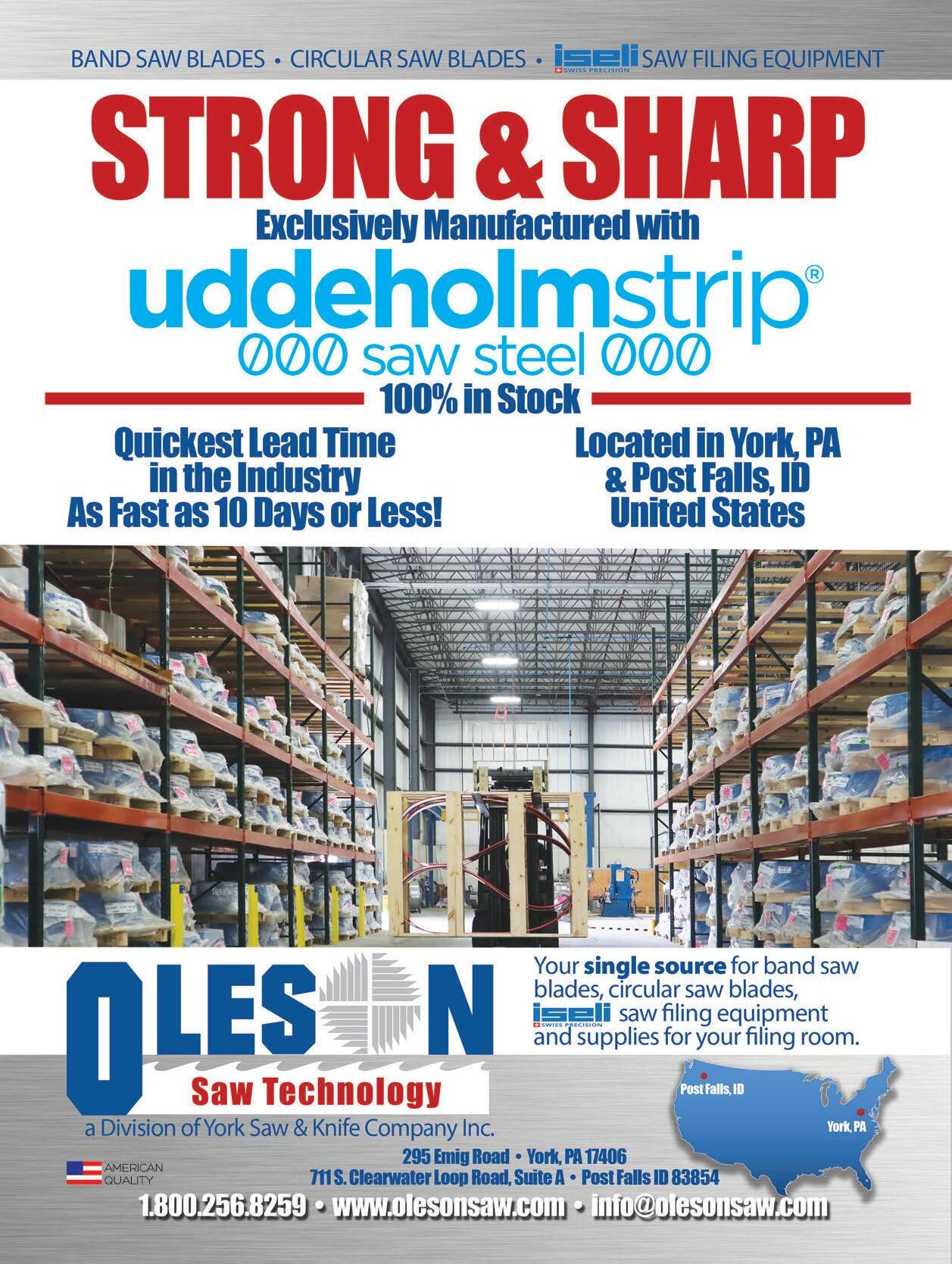
CLICK HERE IF YOU HAVE NOT ALREADY OPTED IN!
l Switch to green electricity and hydrogen
We have already begun our journey towards net zero by focusing on electricity, which we have identified as one of three key levers to quickly reduce our carbon footprint. In 2022, we used sustainable sources to satisfy more than 90% of our electricity needs—and are on pace to reach nearly 100% by the end of 2023.
The second step toward reducing our carbon footprint lies in the sourcing of hydrogen, which is primarily required in the production of raw materials. Instead of cracking natural gas to obtain grey hydrogen, moving forward we will use green hydrogen, which is an ecofriendlier alternative as it is produced from water by electrolysis and with green electricity.
l Recycling beats virgin raw materials
The third major lever is the continuous increase of raw materials remaining in the carbide production chain. By expanding the amount of recycled materials used, we are able to achieve a significant reduction in both energy use and carbon emissions compared to reprocessing primary raw materials. Furthermore, the increased use of recycled materials helps secures our supply chain. With a current recycling rate more than 80%, we intend to increase the proportion of raw materials that remain in the production chain to more than 95% by 2030.
If you would like to learn more about our initiatives and embark on a new era together with us, visit us at Ligna.
Hall 27, Booth B60
COMBILIFT
Since the last Ligna, Irish handling specialist Combilift has been busy introducing new models, finessing technology and expanding its global markets even further. Ligna 2023 coincides with the company’s 25th anniversary, and the company’s new product launches will be the main focus. But Combilift also likes to entertain as well as inform, so expect dancing trucks, Irish music and refreshments, too.
Multiple exhibits will demonstrate that Combilift has a solution for pretty much every handling and storage scenario for companies in the timber sector, which range from small pedestrian 1,000 kg capacity stackers to straddle carriers and mobile gantries which can lift loads of 100,000 kg and over.

So let’s take a virtual walk around the stand to pick out some of this year’s highlights. There are two of the largest Combilift models, the Combi-SC Straddle Carrier and the Combi-CSS Slip Sheet, which guarantee safer and more productive operation when working with containers. The Combi-CSS was designed for fast loading of freight containers, allowing a full container load cycle to be completed in under six minutes with minimum risk of product damage.
In another area there are two compact counterbalance design Combi-CBE models and a Combi-MR4, described at its launch last year as “taking multidirectional capability to the next level” with its new Dynamic 360° steering. These will be used for the very popular dancing forklifts routine that is always guaranteed to draw a crowd—and which demonstrates the unrivaled maneuverability of the trucks as well as the skill of the drivers.
As part of the 25th anniversary celebrations there will be an unveiling of a new model on the first day of the show. As electric trucks grow in popularity it is likely that this will be an emission-free, quiet machine that enables customers to reduce their carbon footprint.
“2023 is a very special year for us,” says Combilift MD Martin McVicar, “and Ligna has always been an important event so it is a perfect framework for celebrating 25 years in business and the launch of numerous new models.”
Open Air Site, Booth M61/M62; Hall 13, Stand G18
DYNALYSE
While at Ligna be sure to make a visit to Dynalyse’s stand to learn more about high quality strength grading and moisture control and sorting.
Dynagrade and Precigrader are two products designed for lumber or timber strength grading. To date, the systems have been installed in more than 200 planer mills, sorting mills and glulam factories in 15 different countries.

Combining robust design, low maintenance costs and accuracy, both Dynagrade and Precigrader are particularly well-suited for sawmills looking to maximize their international potential, as they offer strength grading in compliance with standards used all over the world. They allow for timber strength grading for most of the common grades in Europe, such as C18, C24, TR26, C30, T15 and T22, and in North America the MSR grades such as 1650f and 2100f. The products are also used for grading into standards used in Australia, Japan and New Zeeland.
Precigrader also includes an accurate measurement of the wood E-modulus (MOE) and wood density of each passing piece. The efficient machine stress grading capacity is more than 250 lpm. This fact and the strong correlation to wood strength makes Precigrader an optimal solution for structural grading of lumber or timber.
The products are easily installed in dry sorting mills and planer mills, with a footprint of less than 1.5 m (5 ft.) each. For any sawmill
Combilift-CSS for fast loading of freight containers
22 ■ MAY 2023 ■ TIMBER PROCESSING LIGNA CLICK HERE IF YOU HAVE NOT ALREADY OPTED IN!
Dynalyse specializes in high quality strength grading.
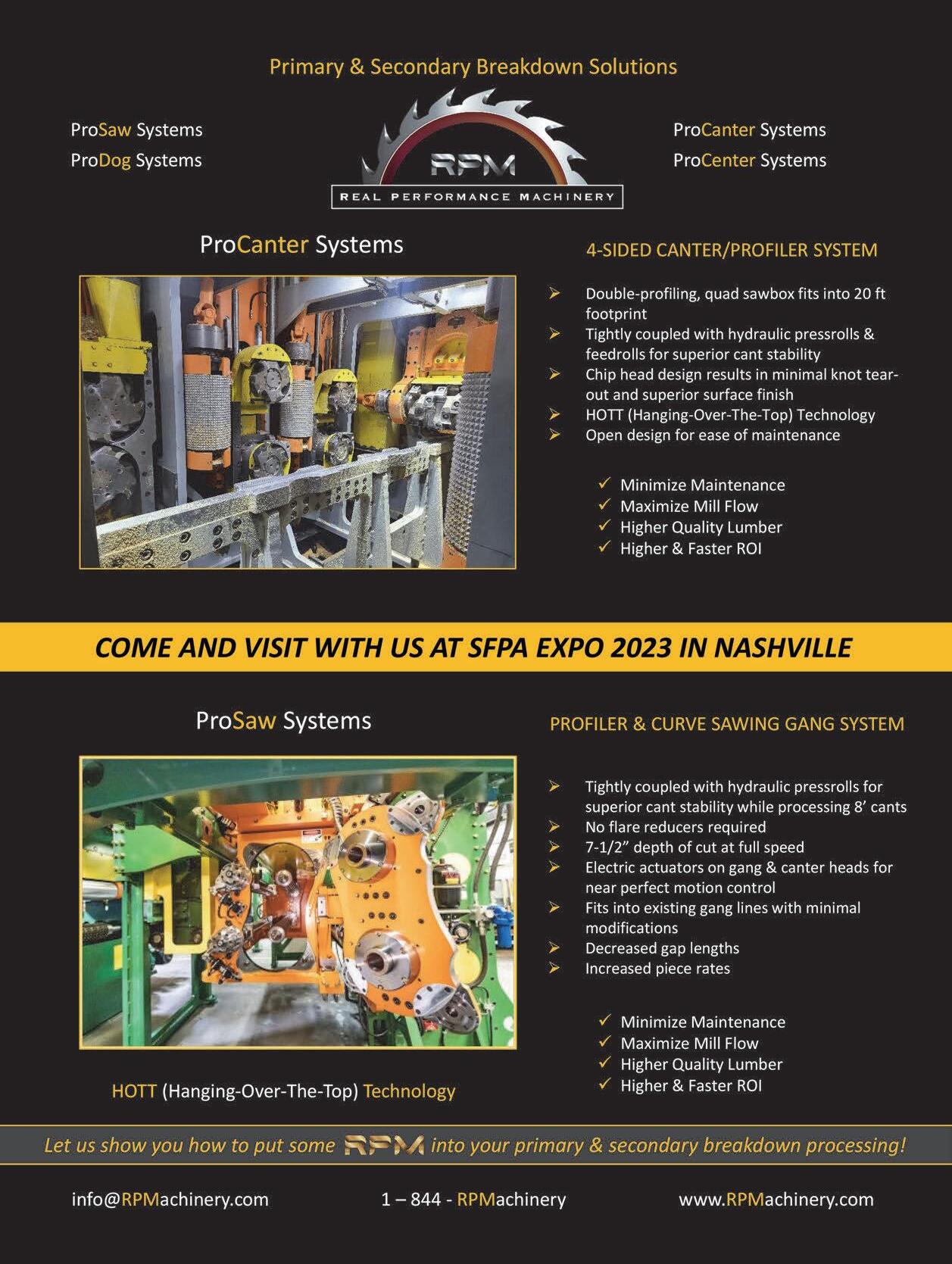
CLICK HERE IF YOU HAVE NOT ALREADY OPTED IN!
looking to maximize their potential, accurate strength grading particularly in higher quality classes is a great addition to the business.
l Densigrader is Dynalyses system for moisture sorting of each passing wet lumber or timber piece up to 250 lpm. With Finna Sensors’ moisture meters, the combination provides an accurate moisture measurement and sorting of dry and wet wood. The moisture data is aggregated into a database for further handling by the kiln operator, allowing for high efficiency drying processes.
Dynalyse is a Swedish company specialized in product quality measurements for sawmills. The company’s experience in developing and offering products for measuring quality properties spans more than 25 years. Through technical development, collaboration with both academia and the industry, Dynalyse has developed products that are used in sawmills around the world. The company’s solutions have been tested and verified by independent institutes. Through knowledge, long-term relationships with customers, an international outlook, Dynalyse has developed robust and sustainable products.
Hall 25, Booth H45
EASY-LASER
Easy-Laser is the world’s leading manufacturer and supplier of laser-based measurement and alignment systems for rotating machines, including sawmill equipment. Alignment of sawmill equipment is nothing new in itself, but the methods used have improved significantly in recent years. Older methods with a wire/cable stretched along the saw line are rarely sufficient for today’s precision and productivity requirements. In addition to increased precision, a major advantage of lasers is that the beam is not in the way during the alignment work, as a wire is. This makes it possible to move freely around the machine during the alignment, and adjust in real time during the measurement.
Regular checking and adjustment of the machine’s angles and straightness increases the quality of the sawn timber, and allows yield and production speed to be maintained at the highest level hour after hour. Transmission components and saw blades also do not wear in the same way. With a laser measurement system, the work can be done quickly and with high precision by the sawmill’s own service and production staff.
Easy-Laser has tools specially developed for measuring sawmills with functions to measure straightness, flatness and perpendicularity, in relation to a level and a plumb line if you so wish. These can be used both on circular saws and band saws and other components in the saw line such as reducers, guide planes and more. The measurements are easily documented with PDF. Visit us at Ligna for a live demo of our tools.

Hall 25, Booth A51
GILBERT
Come visit our team at Ligna. We would be happy to discuss our complete line of planers and our available upgrade options.
—Gilbert High Speed Planer: the fastest in the world, with feed speeds up to 4000 FPM (1200 mpm). Cutterheads have 42 knives for the nicest finish on the market.
—Gilbert 6 Roll Planer: Designed to deliver high performance speeds for mid-size planer mills, and produce a luxurious lumber finish. The feed speeds run up 2800 FPM (800 mpm)
—Gilbert S Series Planer: It’s the ultimate machine to produce value added manufactured wood products such as moulding, sizing and splitting. The feed speeds are from 300 to 1800 FPM (up to 500 mpm)
—Gilbert Moulder Planer: Recognized for its strength, versatility and high quality results. Additional cutterhead modules offer the most exquisite lumber finish on the market. It is designed to receive all profile and special products as well as construction products. The feed speeds are from 100 to 4000 FPM and wood from 1/2 to 6 ft. thickness, 2 in. to 16 in. width and 5 ft. to 60 ft. length.
We will also present many of our upgrades like the Gilbert Automatic Positioning System and Controls. The automatic positioning system allows fast and easy recipe changes offering greater flexibility, less downtime and a safe environment.
Many automatic and safety functions have been developed over the past years, like top and bottom head jointers, side head jointers, top head pressure plate, width and height adjustment, after-cut shoes and triple pattern side heads. Very precise, these automatic upgrades increase the quality of the wood finish, ensure safety and efficiency.
Adjustments are made remotely from the HMI screen outside the planer room, or from a tablet or phone anywhere in the mill. With special features like the triple pattern side heads, the operator can remotely switch from one pattern to the other, without stopping for jointing, or changing side heads on the machine. Keeps nicer finish, and less work required!

Gilbert’s engineering team is presently working on the 4.0 Intelligent Planer with fully automatic self-adjustments.
We hope to see you at Ligna! Hall 25, Booth C14/1
Increase yield with Easy-Laser laser alignment
24 ■ MAY 2023 ■ TIMBER PROCESSING
CLICK HERE IF YOU HAVE NOT ALREADY OPTED IN!
The Gilbert team is ready to discuss new and upgraded planer technologies.
LIGNA
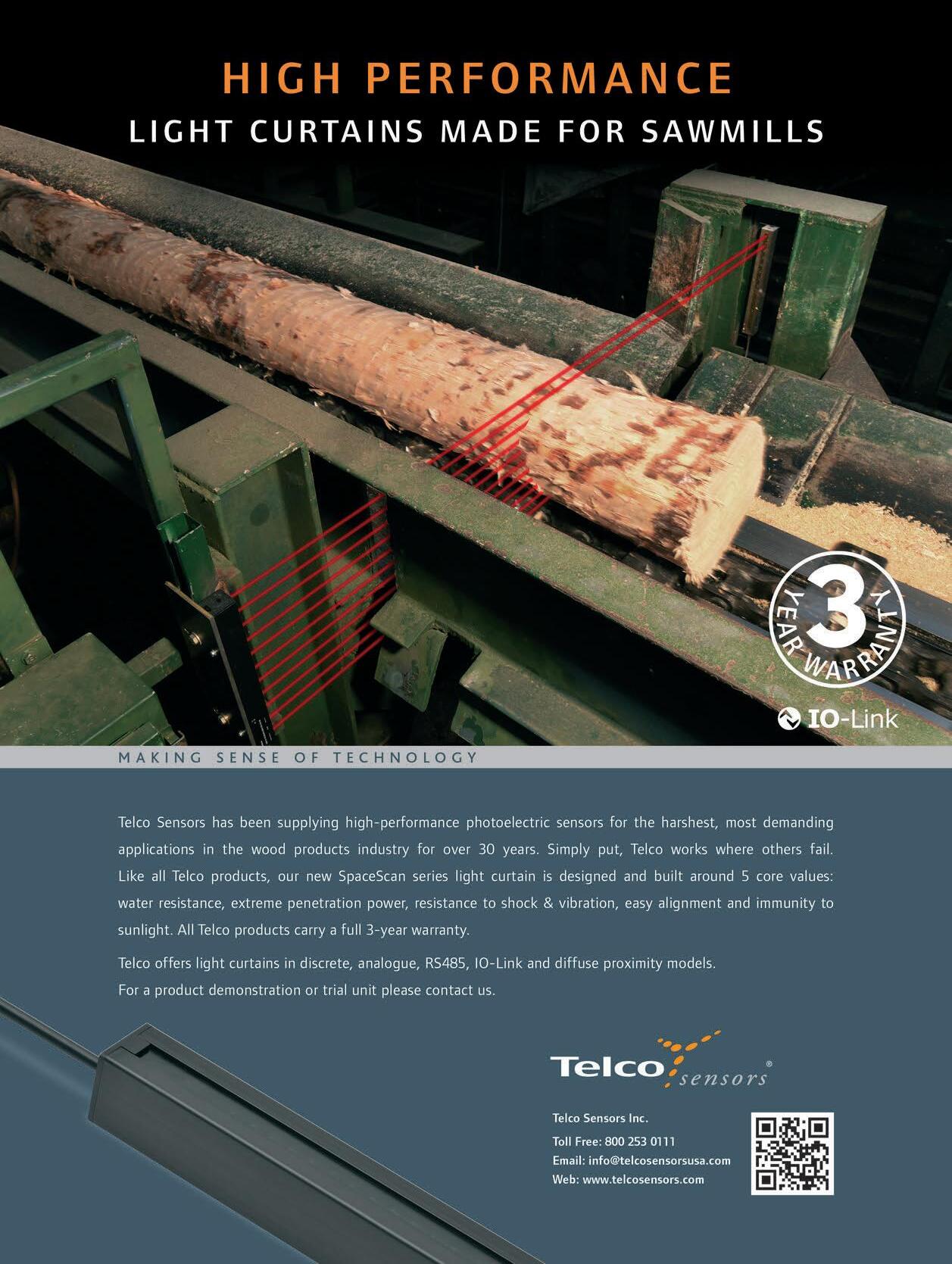
CLICK HERE IF YOU HAVE NOT ALREADY OPTED IN!
GRENZEBACH
For decades, fiberglass, mineral wool, cotton batt and Styrofoam insulation have been mainstays to help boost the energy efficiency of buildings in the United States. Although satisfactory to meet building code requirements, they do present drawbacks both environmentally and healthwise. For example, OSHA requires a cancer warning on all fiberglass products, and skin, eye and lung irritation are common hazards. Issues with installing cotton batt insulation include ill-sizing of the pieces requiring compression into place, reducing R-value. Most insulation materials are non-recyclable and contribute to indoor air quality issues.
The demand for better environmental performance of buildings to offset rising energy costs, support sustainability, and improve indoor air quality is driving the need for more ecofriendly insulation materials. This is accentuated by the massive number of existing buildings that are either entirely uninsulated or in need of serious renovation. The insulating material that has generated the most interest recently among builders to support these objectives is wood fiber.
Made from wood chips, wood fiber insulation has physical properties equal to or better than insulation material from inorganic materials. Here are some of the key advantages:
l Thermal Performance
l Moisture Control
l Sound Insulation
l Carbon Footprint
l Easy and Safe Installation
The challenge that builders in the U.S. have experienced with wood fiber insulation is the lack of manufacturing facilities in North America. Wood fiber insulation could only be obtained from Europe, at a significant cost to cover freight.
This situation, however, has changed. Grenzebach, a world leader in process systems for manufacturing a wide range of insulation materials, is also located in North America (Newnan, Georgia) since 1980. Grenzebach can serve North American companies more directly. Grenzebach is one of the first companies to provide machinery for wood fiber insulation manufacturing in North America.
The company has set high standards in terms of equipment performanceandproduct quality, providing a full range of equipment and systems for producing, processing, and finishing of wood fiber insulation materials. As a full-service partner, Grenzebach provides indepth know-how and expertise throughout the equipment’s entire lifecycle.
The market for wood fiber insulation in North America is poised for growth, as evidenced by the overwhelming push for sustainable building, energy conservation and a more health-conscious public. Companies who are intimately associated with the raw materials needed to produce wood fiber insulation are best positioned to capitalize on this trend. These include for example sawmills and plants that manufacture wood products as well as plywood producers and fiberboard producers. Fortunately, these plants can be built turnkey right here in North America by Grenzebach.
Such producers are uniquely positioned to leverage the turnkey plant manufacturing capabilities of experienced companies like Grenzebach, with decades of experience building wood fiber insulation plants throughout Europe.
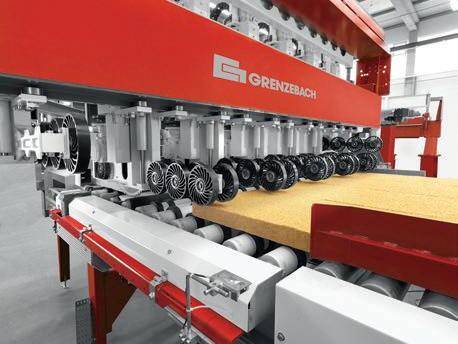
Hall 26, Booth F45
HATTON-BROWN PUBLISHERS
The Hatton-Brown organization, which dates back to 1948 in Montgomery, Ala., today publishes five business magazines geared to the wood products industry. These include:
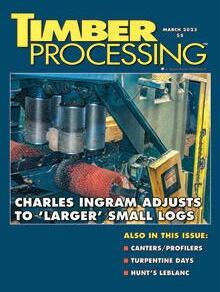
l Timber Processing (covering the North America and international softwood and hardwood sawmill industries)
l Wood Bioenergy (covering the North America and international wood-to-energy industries including industrial wood pellets, biomass electricity and biofuels)
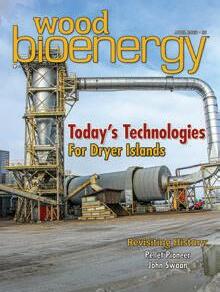
l Panel World (covering the North America and international structural and non-structural wood panel industries
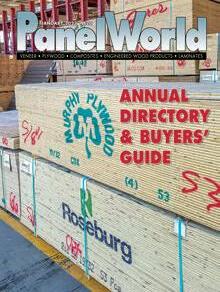
l Timber Harvesting (covering the North America and international in-woods harvesting industry)
l Southern Loggin’ Times (covering the Southern U.S. logging industry)
In addition, Timber Processing serves as the media host of the biennial Timber Processing & Energy Expo, with the sixth edition scheduled September 25-27, 2024 at the Portland Exposition Center in Portland, Ore.
Wood Bioenergy serves as the media host of the biennial Wood Bioenergy Conference & Expo, with the eighth edition scheduled March 12-13, 2024 at the Omni Hotel in downtown Atlanta, Ga.
Panel World serves as the media host of the biennial Panel & Engineered Lumber International Conference & Expo (PELICE), with
26 ■ MAY 2023 ■ TIMBER PROCESSING
CLICK HERE IF YOU HAVE NOT ALREADY OPTED IN!
The wood fiber insulation industry in North America is poised for growth with process machinery manufactured by Grenzebach.
LIGNA

CLICK HERE IF YOU HAVE NOT ALREADY OPTED IN!
the ninth edition scheduled March 14-15, 2024 at the Omni Hotel in downtown Atlanta, Ga.
All three of these events are produced by Hatton-Brown and its affiliates.
Hatton-Brown will be promoting its magazines and its Atlanta conferences and Portland machinery expo during Ligna, with Editorin-Chief Rich Donnell and International Sale Specialist Murray Brett on-site.
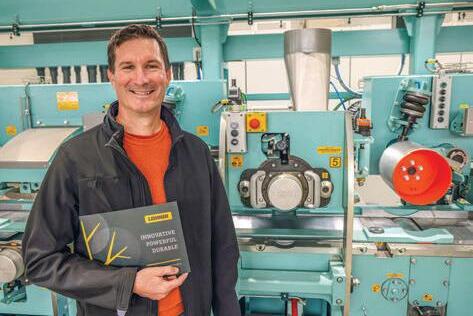 Hall 26, Stand F31
Hall 26, Stand F31
JOESCAN
Team JoeScan will once again venture across the pond to showcase their special brand of sawmill scanning solutions for Ligna 2023.
“We’ll be showcasing our new lineup of JS-50 scan heads,” says JoeScan President Joey Nelson. “With the launch of three new scan heads since the last Ligna event, JoeScan now offers easy-to-use, high performance scanning for every machine center in your sawmill.”
The newest JoeScan model is the JS-50 MX extended range scanner. It is an upgraded version of the popular JS-25 MX scan head, and was designed specifically for lineal applications that require a little extra stand-off distance, such as bucking lines or sharp chains.
“The JS-50 version of the MX offers the same scan zone as the JS25 model that has been a crowd favorite for lineal scanning in sawmills for many years now,” says JoeScan Senior Business Development Manager Blake DeFrance. “But the new model runs much faster, with a much higher resolution to give even more data for the optimizers to make decisions with.”
The JS-50 MX also brings all of the same quality of life improvements as other new JoeScan models, such as a single cable PoE connector allowing faster installation and a QuikLock mount for rapid hot swaps. There is even an available adapter mount to allow JS-50 MX upgrades to use the same ring mounts as the older JS-20 and 25 models.
JoeScan has been a regular exhibitor in Germany. The companyhas been making sawmill scanners since 2002 and took their first booth to Ligna in 2013. “We love coming to Ligna,” Nelson adds. “It really is the wood processing show for the entire world, not just Europe. We bring a bunch of our engineers to chat with our customers from all over the globe. It’s the best way to find out what kinds of problems we can help them solve.”
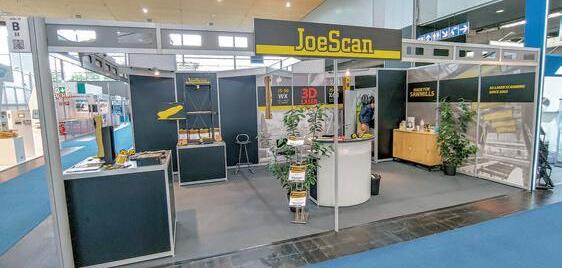
Stop by the booth to learn more about the past, present, and future of sawmill scanning with the JoeScan team.
Hall 25, Booth G65 LEDINEK
Ligna. Here we go again!
Organization of taking part at a trade fair, especially one as big and as important as Ligna, is always quite a challenge and starts many months before the event itself. But as the nature of fairs has also changed over time and everyone expects the atmosphere at a fair to be optimistic and relaxed, I have decided to concentrate in this article on our goals and wishes for Ligna 2023 rather than going into serious technical discussion. For that there will be plenty of time at other occasions.
As a multi-decade exhibitor at Ligna fair, Ledinek has always participated in this special event in good spirits and with high hopes and have always tried to freshen up our stand for our customers and fair visitors. In that light, this year we have along with presenting our newest products, concentrated even more on the social aspect of the fair, spending time with our customers and enjoying their company. We believe that trust is crucial in business, therefore we perceive customers as our long-term partners and friends. Accordingly, we have adapted our appearance at the fair visually as well as in our minds.
With a new design and arrangement of the stand, we wanted to express our core values and add to one’s imagination, hoping our guests will feel welcome and comfortable and enjoy our hospitality. We are also looking forward to the already traditional Slovenian party at our stand, featuring our traditional food and beverage as well as traditional alpine folk music performed live by a famous Slovenian music band. If you still don’t know how to dance polka, learn it!
We are always proud of the exhibited machines as they are the result of our innovative solutions and hard work. This year our Ligna exhibits will be less in number, but by no means less impressive. As our main focus is on development, you will be able to see that a period of four years has been very busy and fruitful for us. Although we would love to present all our latest developments, for space reasons we limited the number to three. We are showing three representative equipment pieces that cover the three main areas of our production program: planing, finger-jointing and pressing, which make us a major global CLT & GLT plant builder.
I believe these are enough reasons for you to visit Ledinek at Ligna; let me only add the detail that the weight of all three pieces will sum up to 85 tons, and the heaviest one will approach the 50 tons weight.
JoeScan will exhibit a new line of scan heads.
28 ■ MAY 2023 ■ TIMBER PROCESSING LIGNA CLICK HERE IF YOU HAVE NOT ALREADY OPTED IN!
Andrej Holc, sales engineer responsible for Ledinek representation on Ligna (and the author of this Ledinek article)
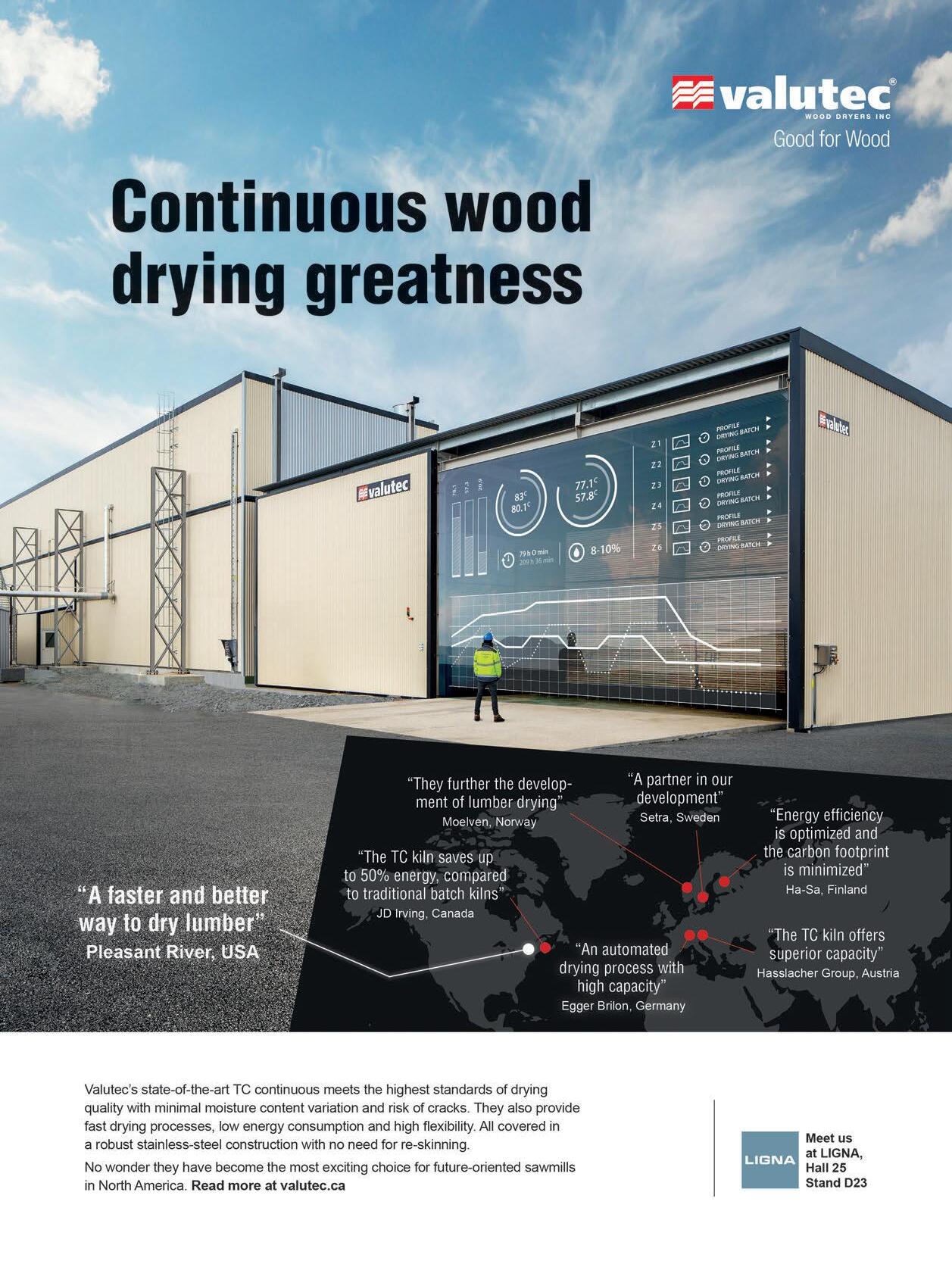
CLICK HERE IF YOU HAVE NOT ALREADY OPTED IN!
In all these years from 1977 when we first took part at Ligna till today, we have reinvented ourselves many times through our products as well as in our appearance, but our core has always been the same and pushes us to be innovative and build powerful and durable machines.
See you soon on Ligna!
Hall 27, Booth C20
LINCK
The latest innovations from LINCK will be presented at Ligna. Already on the EV50 infeed system, the new Log Motion Control ensures a precise rotation of the logs. It uses the scanning data received from the Microtec “Truespin” scanner to determine the true log rotating position to be compared with the theoretical one. Any deviations will be compensated by immediately adjusting the position of the rotating rollers.
In the profiler units VPM350 and VPM45, the non-stop concept allows changing tools during production. Each profiler unit is thus freely and safely accessible and all cutting tools can be changed one after the other.
The latest LINCK innovation, the SEL separating conveyor, is used for separating sideboards from multiple center products. Its functional principle for which a patent is applied allows safe separation without any restrictions on the product dimensions. In the experience walk, visitors can dive into the LINCK world and explore the portfolio as well as the latest innovations.
Hall 25, Booth F25
MEBOR
Mebor is one of the biggest European sawmilling machinery manufacturers as well as the leader in horizontal log sawing technology. Mebor provides machinery for small, medium and bigger scale sawmills—from a small band saw to complete sawing lines. Until today it has supplied machines to more than 65 countries worldwide and gained experience with all sorts of wood and working conditions. Originating from a sawmill business the Mebor team understands the needs and problems of sawmills, which makes them competent in advising customers on how to improve their production.
At this year’s Ligna, Mebor will be presenting a wide range of machinery. Among Mebor’s famous horizontal log band saws, Mebor will present the HTZ 1100 PRO and HTZ 1300 PLUS. The flagship HTZ 1300 PLUS will be presented with new features, such as a newly designed band saw bed for faster speed of operation and with new control features. This machine is recognized worldwide for being the fastest horizontal band saw and has been achieving record levels of production.
The mid-range HTZ 1100 PRO will be showcased as a machine for sawmills looking to cut with high precision (wide blade) and flexibility.
Mebor will also present the vertical band saw VTZ 1400 PLUS with its superfast log carriage. Since its premiere at Ligna in 2019, Mebor has done more than 15 installations worldwide. The log carriage’s structure is designed to have an optimal weight and strength ratio. This is achieved by using high performance structural steel and an optimized structure. Combined servo brushless carriage drive with regeneration of energy, results in significant energy savings and very high return speeds. It has proven to be among the most energy efficient and fastest carriages. Its unique carriage drive with a chain feed has proven to need less maintenance compared to traditional drives.

Besides band saw technology, Mebor will also be presenting circular saw technology—board edgers, multi rip saw and continuous circular saws (scrags) for continuous sawing of logs; as well as its debarking machine SLH 1200 (rosserhead style), which has been in high demand with its robust frame and fully automatic debarking sequence.
Among newer designs, Mebor will present BM 600/400 chipper canters for logs and cants as part of its high production sawing lines range. Mebor’s 3D scanning solutions will be presented within the VR 1300 combination board edger and multi rip saw.
Open Air Site, Booths L50, L51/1
 LINCK new SEL sideboard separation
LINCK new SEL sideboard separation
30 ■ MAY 2023 ■ TIMBER PROCESSING LIGNA CLICK HERE IF YOU HAVE NOT ALREADY OPTED IN!
Mebor VTZ 1400 PLUS vertical band saw with superfast carriage.

CLICK HERE IF YOU HAVE NOT ALREADY OPTED IN!
LIGNA
MENDES
More than six decades of providing development and prosperity, offering complete solutions based on world-class technology, performance, and reliability, through our employees and partners, ensuring full customer satisfaction will be emphasized at the Mendes Sawmill Equipment exhibit.
This is a much-awaited event because it is the moment we can show our continuous development, the way we apply technology, and meet with our customers, international partners, and suppliers.
Innovation, launch, trends, business, and much more.
You are our special guest! Come visit our booth and get to know the turnkey solutions for your business.
Hall 25, Booth M10
MICROTEC
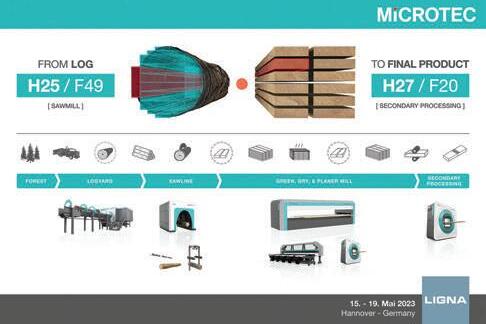
Experience MiCROTEC Connect, the unique fingerprint system from log to final product based on CT scanning, live at both of our booths! See how the MiCROTEC Ai platform boosts our scanning performance, discover the new QC Assist, the quality control tool to maximize your grading accuracy, the new Goldeneye & Woodeye generation, and new product features and innovations added to the MiCROTEC product portfolio.
Finally, discover what our customers say about our solutions, get in touch with our experienced Sales & Customer Care experts, and have a good time at our booths at Ligna.
We are looking forward to meeting you.
Hall 25, Booth F49 (sawmill processing)
Hall 27, Booth F20 (secondary)
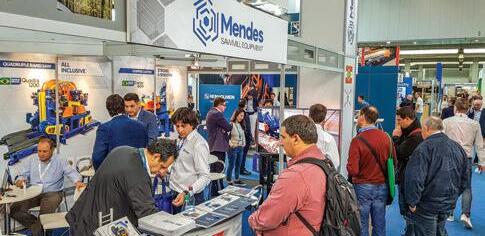
MINDA
After a long developmental period beginning a few years earlier, MINDA—a plant specialist with more than 40 years of experience—won the order at the end of 2018 to build, install and set up a new CLT production line at the XLAM Industrie site in Mignovillard, France. Delivery and installation began just over a year after order placement, and commissioning took place in January 2020. Due to unexpected Corona interruptions, the production startup was delayed to May.
A key requirement of the customer was to have space-saving production facilities in an existing hall. The finger-jointing outfeed and the remaining production sections were placed in a new hall.
The line consists of a compact package feeding with two qualities: a manual marking station and the infeed to the finger-jointer. The finger-jointer and the production control system receive the production data in advance from the work preparation system.
Behind the finger-jointer, MINDA takes over the lamellas and tracks each one from this point on in the MINDA MCS overhead control system. The lamellas are then stored in a multi-level storage area. After the finger-joints are cured, the lamellas are fed to a lamella planer. Lamellas for the cross layers are produced in multiple lengths, cut to the needed size and then collected to layers.
The cross and length layers are centered and pre-compressed on the two pick-up stations. A following vacuum gantry places the layers in the appropriate sequence on the laying table. The one-component PUR glue is applied by a driving gantry. Once a press package has been completed, it automatically runs into the TimberPressX 334.
The front and side pressure systems close all gaps between the loose lamellas. The CLT panels can be produced between a length of 26 and 54 ft. and a width of 7.8 to 11.2 ft., fully automated without any manual intervention and without any pattern. After buffering, the CLT panels are transported to the CNC machine.
MINDA delivered the first CLT line to Eugen Decker in Morbach, Germany in 2011. Meanwhile, MINDA lines can be found on almost all continents. CLT panels can be produced on MINDA lines in batch size 1. Each panel can be a different length and width—infinitely variable—and of any possible layer structure. There are no manual setups to be done in the press area—everything is fully automated.
The high-speed version of the TimberPressX introduced in 2019 has become an integral part of high-performance lines. The potential use of even faster glues (and thus shorter pressing times) allows a capacity increase of up to 30%.
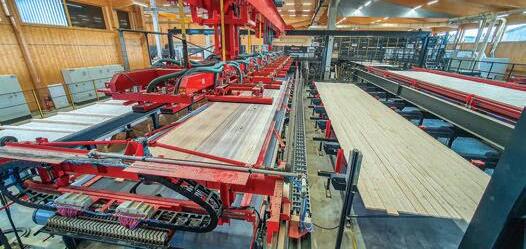
Hall 26, Booth F27
Hall 27, Booth F38
32 ■ MAY 2023 ■ TIMBER PROCESSING
Mendes world-class turnkey solutions for sawmill projects
CLICK HERE IF YOU HAVE NOT ALREADY OPTED IN!
Minda TimberPressX and CLT production
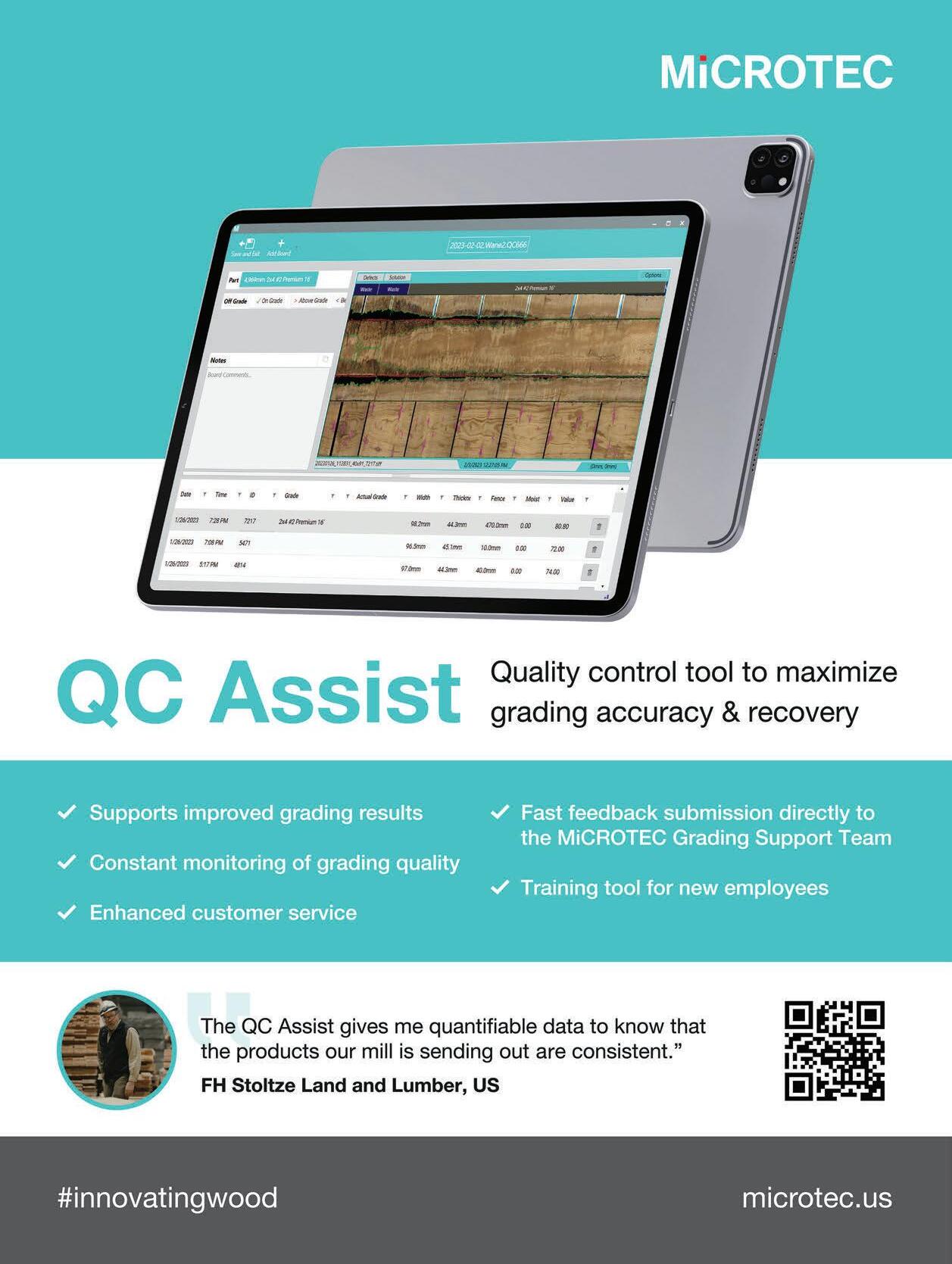
CLICK HERE IF YOU HAVE NOT ALREADY OPTED IN!
MÜHLBÖCK
With its innovative drying technology, Mühlböck Holztrocknungsanlagen GmbH has been proving that drying wood and preserving resources can go together for more than 40 years. At Ligna, the drying technology specialist from Upper Austria presents itself as a timber industry pioneer and shows once again how efficient technology can reduce electrical and thermal kilowatt hours during the energy-intensive wood drying process. To this end, Mühlböck presents examples for and results of timber and sawmill byproduct drying systems combined with the 1003 PREMIUM and 1306 PRO heat recovery systems. Across the entire drying system range, these highly efficient systems allow for significant savings in terms of energy and resources.
From drying kilns to progressive kilns and belt dryers for wood chips and saw dust: Depending on the design, energy savings of up to 50% are possible thanks to Mühlböck technology. Mühlböck puts particular emphasis on its energy-efficient progressive kilns and belt dryers for sawmill byproducts as they are currently receiving strong interest from international customers.

In recent weeks alone, Mühlböck landed an order for five progressive kilns which will be delivered to Holzwerke Ladenburger in Kerkingen, Germany, in two stages until 2025. It marks the largest project in the company’s history, worth more than 10 million Euros. The Austrian wood drying specialist owes this lucrative contract to the energy-efficient technology of its systems and the tailored implementation of customer demands such as a customized transport system.
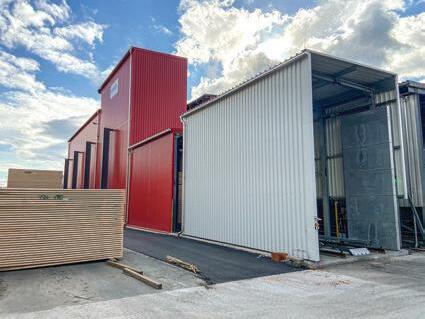
Its 1003 Premium belt dryer is yet another Mühlböck system that provides an important solution for climate protection and the energy transition. For instance, thanks to its innovative heat recovery system, the new belt drying technology helps pellet plants massively improve their efficiency. Reliable drying of sawdust and wood chips is crucial for the transition to biomass energy provision and the aim to make sawmills meet their zero-waste goals.
To make sure the generation of renewable energy from regrowing raw materials itself uses a minimum of energy during the production process, Mühlböck has revolutionized its belt drying technology with its efficient 1003 PREMIUM heat recovery system. Depending on system design, energy savings of up to 50% are once again possible in wood drying.
The performance of Mühlböck’s technology has, for example, convinced green energy supplier Cycleenergy to equip its latest pellet plant in Aschach an der Donau with a new Mühlböck belt dryer. Cycleenergy currently operates four biomass plants and three pellet plants in Austria and Germany.
“Careful handling of resources and energy is increasingly becoming a central topic in our activities,” Richard Mühlböck says. “Thanks to our willingness to continually improve, we have become a technology leader in all our product sectors. We have set a milestone with our revolutionary heat recovery systems as well as many innovations in detailed fields. And just like all other Mühlböck systems, they are custom-made on the basis of customer requirements.”
Hall 25, Booth K49
34 ■ MAY 2023 ■ TIMBER PROCESSING LIGNA CLICK HERE IF YOU HAVE NOT ALREADY OPTED IN!
Mühlböck dry kiln and heat recovery system
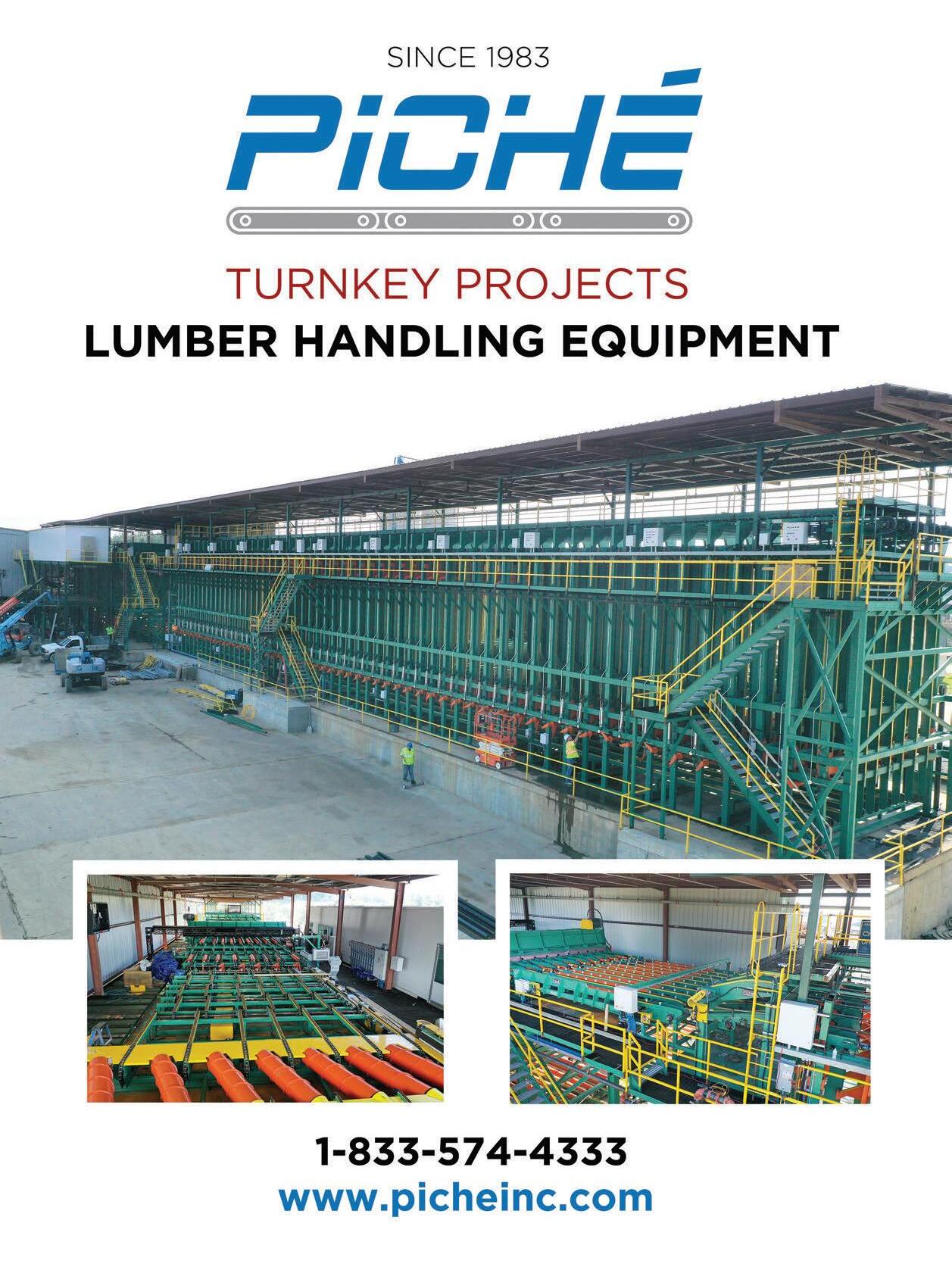
CLICK HERE IF YOU HAVE NOT ALREADY OPTED IN!
PRINZ
Based in Austria and backed by 75 years of experience, PRINZ has established itself as the leading supplier of crosscut saw systems custommade for individual customers.
The PC120 crosscut package saw stands out for its combination of efficiency and precision. High productivity is only possible with a high degree of automation. The PC120 from PRINZ was therefore designed so that loading, palletizing, strapping and cutting are all executed in a single line and fully automatically. After being cut precisely to the nearest millimeter, the materials can also be transported away on a cross conveyor. Disposal can be integrated and if need be, swivel-mounted roll conveyors can be used to dispose of long trims. Maintenance bridges provide easy and safe access to maintenance areas, reducing maintenance time to a minimum.
PRINZ is unique in the industry for its high degree of vertical integration. PRINZ continues to produce tools such as saw chains and guide bar, making it a one-stop supplier for all companies keen on clean, precise cutting.
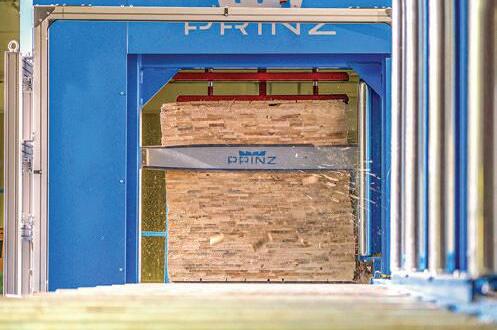
Hall 25, Booth H25
SPRINGER
Springer, the leading supplier of integrated solutions for the timber industry, is set to celebrate its 70th anniversary at the Ligna trade fair. The globally active, family-run business will be showcasing new developments in log and lumber processing, including their latest innovative product—a new high-speed feeder solution for lumber sorting called the E-Loader.
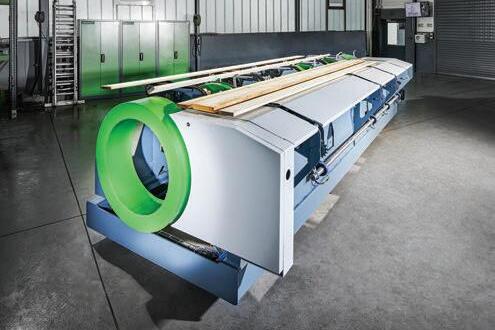
Customers from more than 30 countries and six continents rely on Springer’s decades of experience and innovative customized solutions. The E-Loader is the newest product innovation by Springer and once again brings a feeder solution for lumber sorting to market. What sets the ELoader apart is its high-performance capacity and the fact that the machine can simultaneously process board thicknesses between 12 and 120 mm without any restrictions on board width.

Egon Eisner, Head of Product Development at Springer, outlines the special features and functions of the new E-Loader. “The E-Loader is used for singulating pieces of lumber. An accumulating conveyor is used to gather the boards in a backlog position and hold them back with a flap located upstream of the E-Loader. From there, the feeder arms pick up the board and lift it directly into the lug of the downstream lug chain conveyor.”
Eisner explains the distinguishing features of the E-Loader: “What sets the E-Loader apart is its high degree of availability and
36 ■ MAY 2023 ■ TIMBER PROCESSING
PRINZ package saws for industrial use boost productivity.
LIGNA
CLICK HERE IF YOU HAVE NOT ALREADY OPTED IN!
Springer showcases innovative high-speed feeder solution.

CLICK HERE IF YOU HAVE NOT ALREADY OPTED IN!
performance capacity. Its variable, individually controllable feeding nose makes it possible to cover a very wide range of dimensions. Furthermore, it can be adapted to each board thickness. The thickness of the boards is determined by a measurement upstream of the feeder. This function causes the lower feeder nose to be lifted or lowered. Thanks to this flexibility, the upper and lower feeder arm hit the board at the same time. In addition, the geometry of the variable arm creates greater support during lifting. This means that even large dimensions can be singulated with a bigger board support.”
During development, Springer placed a special focus on the ease of handling and maintenance of the machine. Equipped with gas springs, the maintenance access plates can be opened easily by hand and can support the weight of maintenance personnel.
Springer’s machines are known for their reliability and precision. They continuously develop innovative solutions to adapt to their customers’ changing needs. This is yet another solution that Springer has added to their lumber feeder portfolio. It has been developed with a focus on reliability, ease of use and maintainability as well as integration into new or existing production lines. With different lug loader configurations available, Springer provides each customer with the opportunity to choose the right machine for their individual requirements.
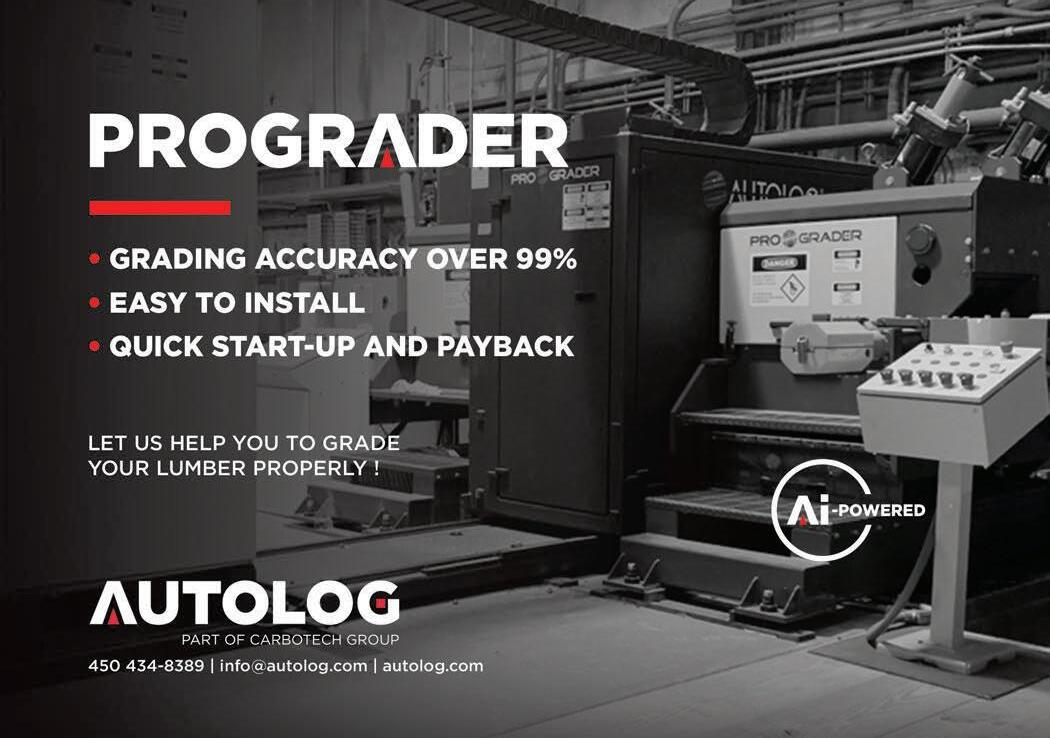
The E-Loader has already garnered significant interest with two European customers placing orders right after seeing the demonstration. Springer’s innovative product development continues to drive the industry forward, and their commitment to providing individual solutions to customers across the globe has made them a trusted partner in the timber industry for seven decades.
Hall 25, Booth F26
STENNER
Stenner staff are all looking forward to the return of Ligna for the first time since 2019. “ It’s been a long time coming and it’s been a huge miss,” says Stenner MD Syd Mather. “Shows give us manufacturers the opportunity to introduce our products to a wide audience but, more importantly, we are able to sit down in a focused environment and discuss projects with clients in fine detail, face to face and reach some conclusions. Remote meetings via modern media will never replace this in my opinion.”
Stenner machines on the stand are as follows;
l VHET100. This is the latest design in our very successful range of center cutting resaws. Based on 36 in. pulleys the machine has a new, but proven, servo motor based positioning system for the sawblades and feedboxes making operation very simple and user friendly. All controls are via a high-definition touch screen. Options included are remachinable saw guides, spray lubrication
38 ■ MAY 2023 ■ TIMBER PROCESSING
CLICK HERE IF YOU HAVE NOT ALREADY OPTED IN!
LIGNA

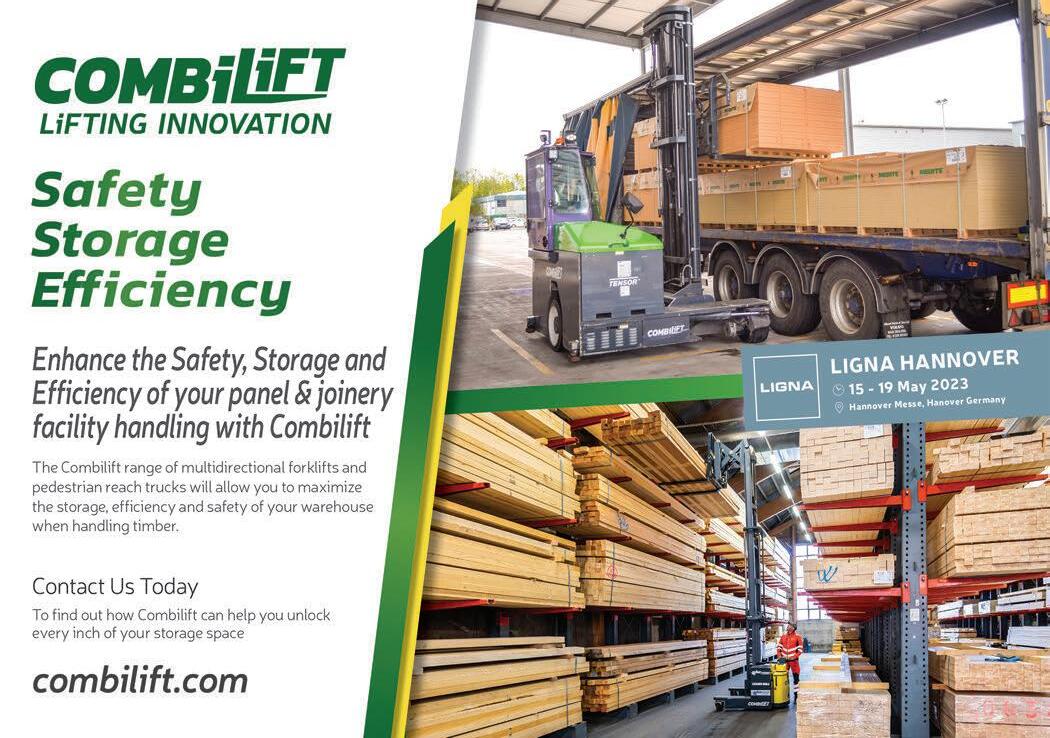
CLICK HERE IF YOU HAVE NOT ALREADY OPTED IN!
systems and remote tracking.
We are really looking forward to “showing off“ the VHET100 as it represents what modern Stenner is all about and is a credit to the Electrical and Mechanical Design Team in particular but also influenced by significant input from our shopfloor technicians. The VHET100 can operate as a stand alone hand fed machine or as part of an automated system in combination with other machines centers such as moulders and cross cut saws. Stenner can offer such handling systems as part of a “turnkey” package
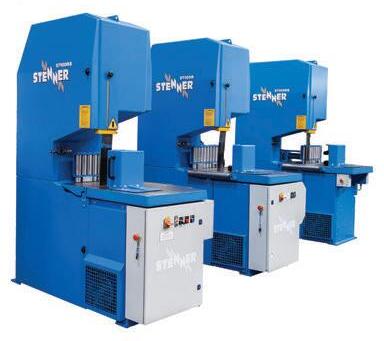
l ST100R. This is the latest design in the 36 in. stand alone range which has been core to the Stenner business since the 1950s and is probably what they are best known for throughout the world. This machine will be unsold and will come with a special show “package” of goodies.
We will have videos representing other machines in the range with particular emphasis on the very successful MHS multi head resaws with more than 900 of these models sold all over the world from Iceland to New Zealand.
All sales staff will be available as well as installation and production staff to give practical advice on service and operation of the resaws.
Hall 25, Booth L46
USNR
Recent mergers and acquisitions have solidified USNR’s leadership position in providing equipment and technology for the global wood processing industry, and we are sharing some of it with you at Ligna.

Experience the future of efficient lumber manufacturing technology and learn the details about our AI-powered scanning, optimization, and lumber grading systems, along with flexible solutions for log and cant processing.
Come and see the industry’s fastest band saw on display. Logmaster HPS effectively satisfies your need for high-speed band saw production. The design maximizes production and performance with its thin saw kerfs and excellent yields.
Designed for feed speeds up to 180 m/min (590 FPM) and saw speeds up to 100 m/sec (330 feet/sec), Logmaster HPS delivers excel-
40 ■ MAY 2023 ■ TIMBER PROCESSING
CLICK HERE IF YOU HAVE NOT ALREADY OPTED IN!
Stenner ST100 range of band resaws
LIGNA
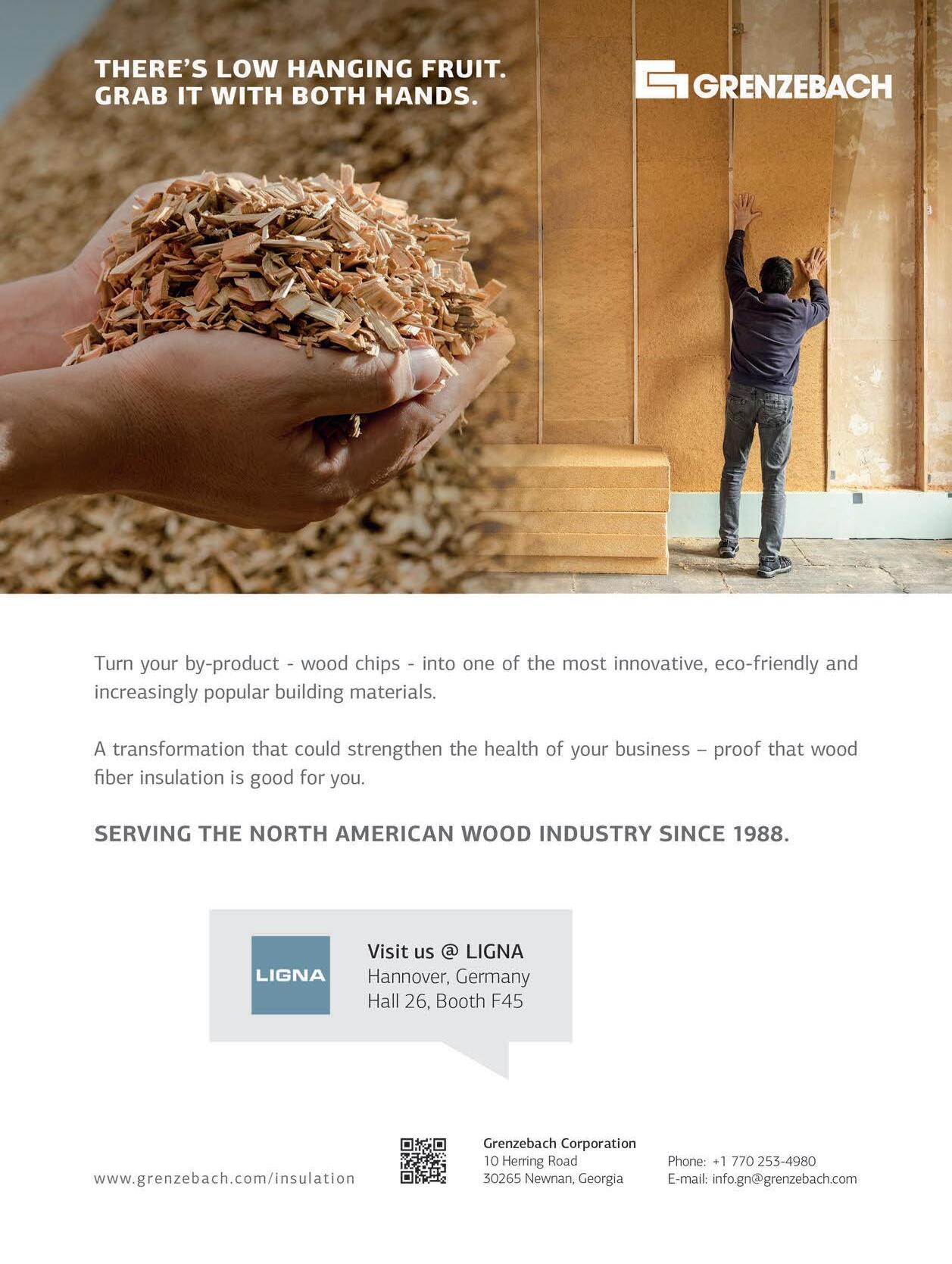
CLICK HERE IF YOU HAVE NOT ALREADY OPTED IN!
LIGNA
lent product accuracy. Electronic monitoring and self-adjusting features ensure system stability and reliability. It can be configured as a log or cant breakdown machine, with or without a reducer unit. Its high precision feedworks system guarantees the best accuracy for both straight and sweep sawing.
The Logmaster HPS is installed and operating with impressive results. Mills are reporting improved cutting accuracy and volume increases with thinner kerf sawing compared to circular saw blades.
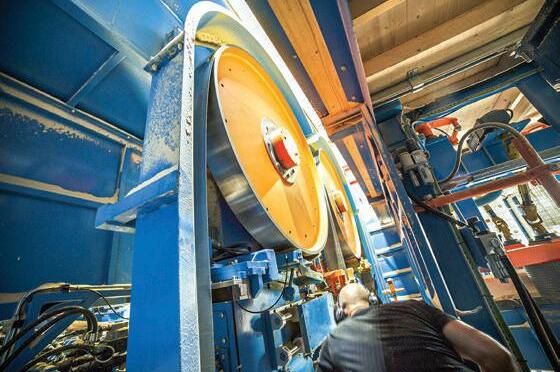
Get a taste of the future with SAM, our Self-Adjusting Machine technology that automates your quality control process.
We are also pleased to showcase the highly innovative optimization and grading solutions from VAB in our booth. On display you’ll see USNR’s second-generation VAB-brand lineal sawmill scanner and lumber grading optimizer. This system has a lineal orientation and is designed to increase the amount of premium lumber grades while decreasing economy grades. It decreases trim loss, increases production, and reduces the need for labor by eliminating the time required by manual graders to analyze boards. The system easily manages multiple grades in one recipe. Mills capture more wood volume. Its small footprint simplifies installation making it easy to integrate into existing production lines.

Visit us and let us share advances that will make your process more efficient and improve your bottom line.
Hall 25, Booth D65/D69; Hall 26, Booth D08
42 ■ MAY 2023 ■ TIMBER PROCESSING
CLICK HERE IF YOU HAVE NOT ALREADY OPTED IN!
USNR’s Logmaster HPS satisfies the need for high-speed band saw production, maximizing performance with thin saw kerfs and excellent yields.

CLICK HERE IF YOU HAVE NOT ALREADY OPTED IN!
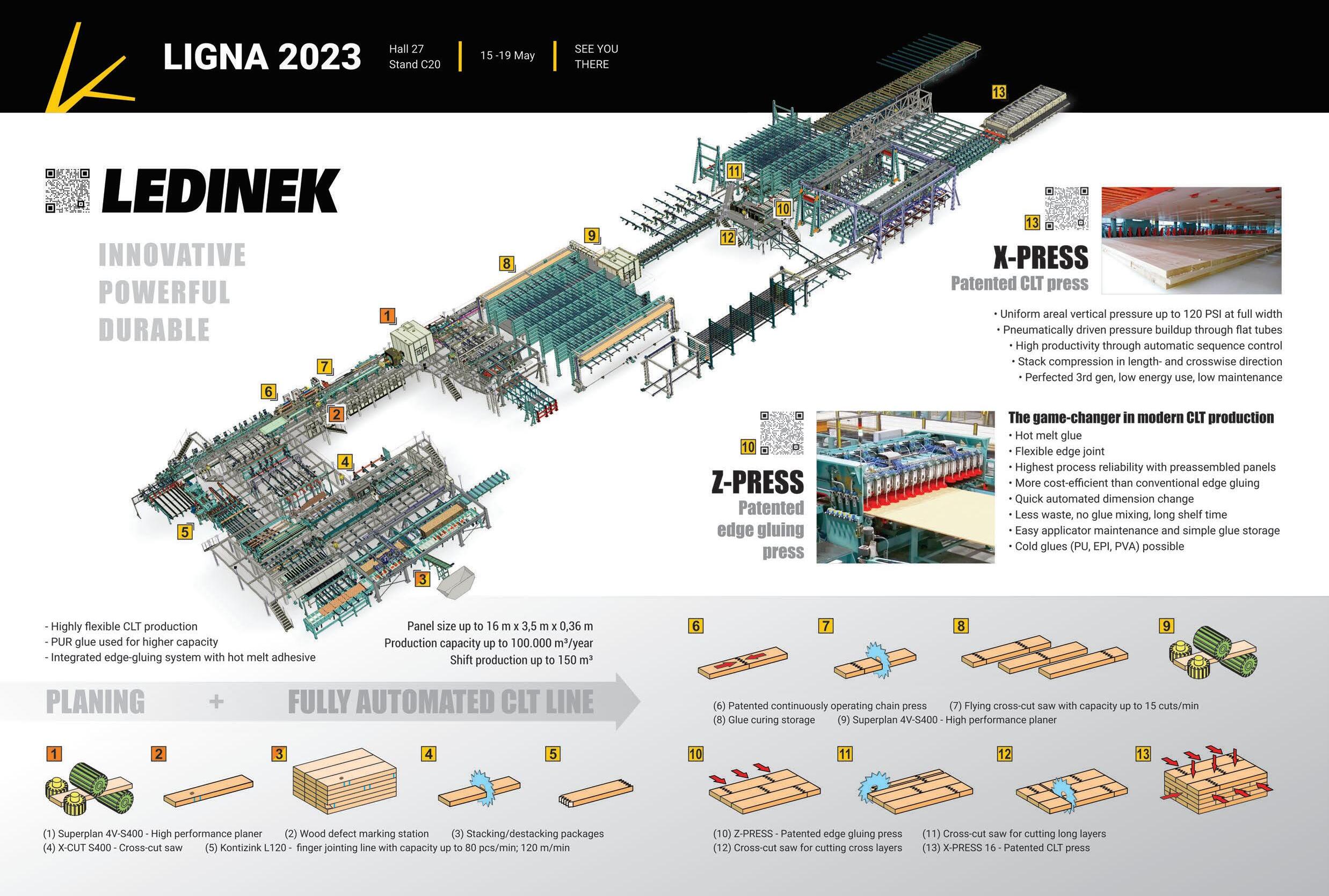
CLICK HERE IF YOU HAVE NOT ALREADY OPTED IN!

CLICK HERE IF YOU HAVE NOT ALREADY OPTED IN!
VALUTEC
In our booth we will tell you about the new generation of TC continuous kilns—the giant among continuous kilns that provides high capacity, optimum quality and a very high flexibility to mix dimensions. The TC continuous kiln is built in stainless steel and comes with IE 5 engines and heat recovery which makes it the most sustainable timber kiln on the market.
Among other things, you’ll get the chance to see a demonstration of our control system, Valmatics 4.0. With more than 1,500 systems sold since its introduction at Ligna, Valmatics 4.0 has quickly become the go-to control system for sawmills around the world. With Valmatics 4.0, you can automate and optimize drying in all types of lumber kilns. High process quality is assured by simulators programmed with data from hundreds of thousands of measurements that enable the calculation of drying processes with unbeatable accuracy from beginning to end.
Come and hang out with us for a while. When you get there, we will also take the opportunity to tell you about the successful projects that mean Valutec is now the world’s leading supplier of continuous kilns.
And as the tradition goes, we will be holding a Valutec evening in our booth on Tuesday, May 16, at 5-7 p.m.
Hall 25, Booth D23
WEINIG
Systems engineering is increasingly becoming the focus of Weinig. Highlights at Ligna include:
l an optimizing crosscut line with an OptiCut 450 Quantum crosscut saw, connected to a finger-jointing line and robot stacking
l a ProfiPress C 2500 HF gluing press for the production of wood panels
The fully automated crosscut system shows the production process from raw material to finger-jointed lamellas. A robot with a vacuum unit stacks raw material onto the line. The workpieces are evaluated by means of a CombiScan Sense scanner. Defects are cut out by the high-speed OptiCut 450 Quantum crosscut saw and the good parts are automatically fed to the downstream HS 200 finger jointing line for further processing. The mechanization for direct feeding of the finger-jointing line via the crosscut saw is patent pending.
The CombiScan Sense scanner scans up to 80 boards per minute to detect cracks, knots, etc. The scanner enables line automation and thus a reduction of the required manpower. It saves between 3 and 10% material, depending on the application.
The wood is cut to the required length using the OptiCut 450 Quantum high-speed crosscut saw. The VarioStroke sawing unit of the OptiCut 450 Quantum can be flexibly adjusted to eight different cutting positions, enabling very short cutting times for all cross-sections within the maximum cutting range.
The HS 200 is characterized by an output of up to 240 perfectly processed parts per minute. All tools are adjustable down to a hundredth of a millimeter. The minimal height offset of the finger-joints ensures high material yield.
For customers who need to produce solid wood panels cost-efficiently at high output, the ProfiPress C 2500 HF, one of the fastest gluing presses in the world, can be seen in live operation at the exhibition. Up to 100 lamellas per minute are glued at the edge, collected, and continuously pushed into the press.
—In live demonstrations, Weinig shows how the new Conturex Vario L achieves the fastest part transfer in the world.
—With a feed speed of up to 150 m/min, the PowerSplit 1250 cuts softwood quickly and hardwood reliably and efficiently. The new generation of band resaws from the Split series features band saw blades that allow variable cutting speeds of 20-60 m/s.
—With a feed speed of 400 m/min and WMC machine control, the new Hydromat high-speed moulder brings innovative dynamics to planing and profiling processes.

—With a feed speed of up to 100 m/min and its user-friendliness, the Hydromat 3000 scores in the further processing of sawn timber, e.g., into tongue-and-groove boards, decking boards and mouldings. CNC-controlled adjustment does not require manual intervention; the central dashboard of the control system is customizable and can be operated intuitively.
Hall 27, Booths D66, D50, D40, E40, E50, E60, D74, D60, D32
WEMA PROBST
WeMa Probst Wolfgang Hofmann GmbH is a manufacturer of modern, high-quality machines and complete lines for the economic processing of raw wood in diameter range from 4 cm up to 40 cm.
We engineer, construct and produce:
—Profiling lines to manufacture boards from wood in diameters from 10 cm to 25 cm on top and in lengths from 1.0 m up to 6 m. This profiling technology makes it possible to economically process both “simple” wood such as spruce and “difficult” wood such as maritime pine.

46 ■ MAY 2023 ■ TIMBER PROCESSING
LIGNA
Weinig Hydromat value-added processing
CLICK HERE IF YOU HAVE NOT ALREADY OPTED IN!
In 2020 Valutec installed Canada’s first continuous TC kiln at JD Irving, Grand Lake Timber, Chipman, NB.

CLICK HERE IF YOU HAVE NOT ALREADY OPTED IN!
LIGNA
Depending on the diameter, up to 50 m3 of sawn timber (at 120 mm) and up to 120 m3 of sawn timber (at 25 cm ) can be produced per shift. You can benefit from the economic advantages of the profiling technology, such as top output of weak wood, up to 65% depending on the sawing patterns and the lengths, low space requirements (the total length of the plant for processing wood up to 3 m long is 30 m), low primary energy costs—360 kW - 450 kW, high throughput capacity up to 50,000 fm etc.
—Rod Rounding machines (about 40 different types) to obtain optimally round milled logs for further working to different wooden products as fences, stakes, guardrails, palisades, battens, privacy screens, swings, sandboxes, plant troughs, as well as wooden constructions for playgrounds and gardens, etc.
For long or very conical timbers, a rod rounding machine with 2 cutter heads is recommended.
—Peeling machinery for telegraph poles and stakes
—Machinery to manufacture construction wood for log cabin constructions in round beams or for hydro constructions

—Machines for landscape architecture for pointing (pencil point or tetrahedral), chamfering, conic beveling, splitting etc.
—Transport equipment for step-less timber machining operations.
We offer you engineering service for complete production lines, aftersales service - spare parts, maintenance and repair of machinery, user training etc.
Wema Probst produces in Freigericht, Germany and distributes its machines worldwide .
Hall 25 Booth G39
WOOD-MIZER
The pandemic years without exhibitions have been a time of intense work for Wood-Mizer’s R&D group, resulting in a range of new machines, features, and solutions to improve overall usability and increase wood processing efficiency. Now it’s time to present these innovations to the public during Europe’s largest wood industry trade show, Ligna.
In the open area FG (K44), Wood-Mizer will exhibit the LX and LT sawmill series in action and a full line of EG edgers, starting with the small EG100 and the popular EG300 edger/multirip. A new WIDE head option to cut large-diameter logs will be demonstrated on the LT20 WIDE and LT15 WIDE sawmills. Europe’s most popular LT15 sawmill with a segmented bed will be displayed in a mobile version. Two LT15 sawmills will run at Ligna, including one sawmill with a new innovation never seen before!

The smallest Wood-Mizer LX50 sawmill, designed for homeowners and hobbyists, will be displayed in two versions. In addition, there will be new machines for processing slabs—the LX250 wide slab sawmill capable of cutting massive slabs up to 138 cm wide, and the MB200 SlabMizer that efficiently surfaces and flattens slabs up to 142 cm wide with minimal labor. The famous LT40 and LT70 sawmills in WIDE versions will also be displayed in the Wood-Mizer area.
Responding to the needs of high-performance wood processors, Wood-Mizer will present two types of industrial sawmilling lines. The first line is designed to process a large timber volume and is based on the well-known WB2000 industrial sawmill, using a band blade of 50-75 mm width. The WB2000 sawmill will be equipped with a new state-of-the-art control station, log loading, and material transporting system, and at the end of the line, exhibiting for the first time, the MR200, an industrial double arbor multirip with up to 12 circular blades at each shaft, capable of sawing timber up to 200 mm thick.
The second Wood-Mizer industrial sawmilling line at Ligna is designed to process logs into pallet boards and other timber. The machines in that line are the TVS heavy duty twin vertical saw with a new control station, a log loading deck, material sorting equipment, the industrial HR700 horizontal two-head resaw, and the powerful EG800 edger for slab processing.
At a separate area dedicated to industrial exhibitors (Hall 25, E06), Wood-Mizer will showcase its newest, most advanced heavyduty solution for the sawmilling industry—the EA3000 transverse edger, a part of Wood-Mizer Systems. It will be an outstanding opportunity for the visitors to research the topic of custom-designed sawmilling lines.
Wood-Mizer’s booth in Hall 13 (E08) will present new woodworking machines, including the four-sided MP280 planer/moulder and the MS750 panel saw. In addition, Wood-Mizer will be exhibiting for the first time at Ligna the CNC5003 machine for the automated processing of wood, plastics, composites, and light alloys.
Hall 25, Booth E06
Hall 13, Booth E08
Open Air Site, Booth K44
48 ■ MAY 2023 ■ TIMBER PROCESSING
Wood-Mizer eagerly awaits to showcase new machinery and features developed since the previous Ligna.
CLICK HERE IF YOU HAVE NOT ALREADY OPTED IN!
WeMa Probst log processing line

CLICK HERE IF YOU HAVE NOT ALREADY OPTED IN!
THE BLUES SINGING
—Third of Three Parts—
At its very best, logging work was tough, exhausting and dangerous in early America and through the first half of the 20th century, but by most historical accounts, conditions were tougher, in some instances downright cruel, for those who toiled in the gum turpentine woods.
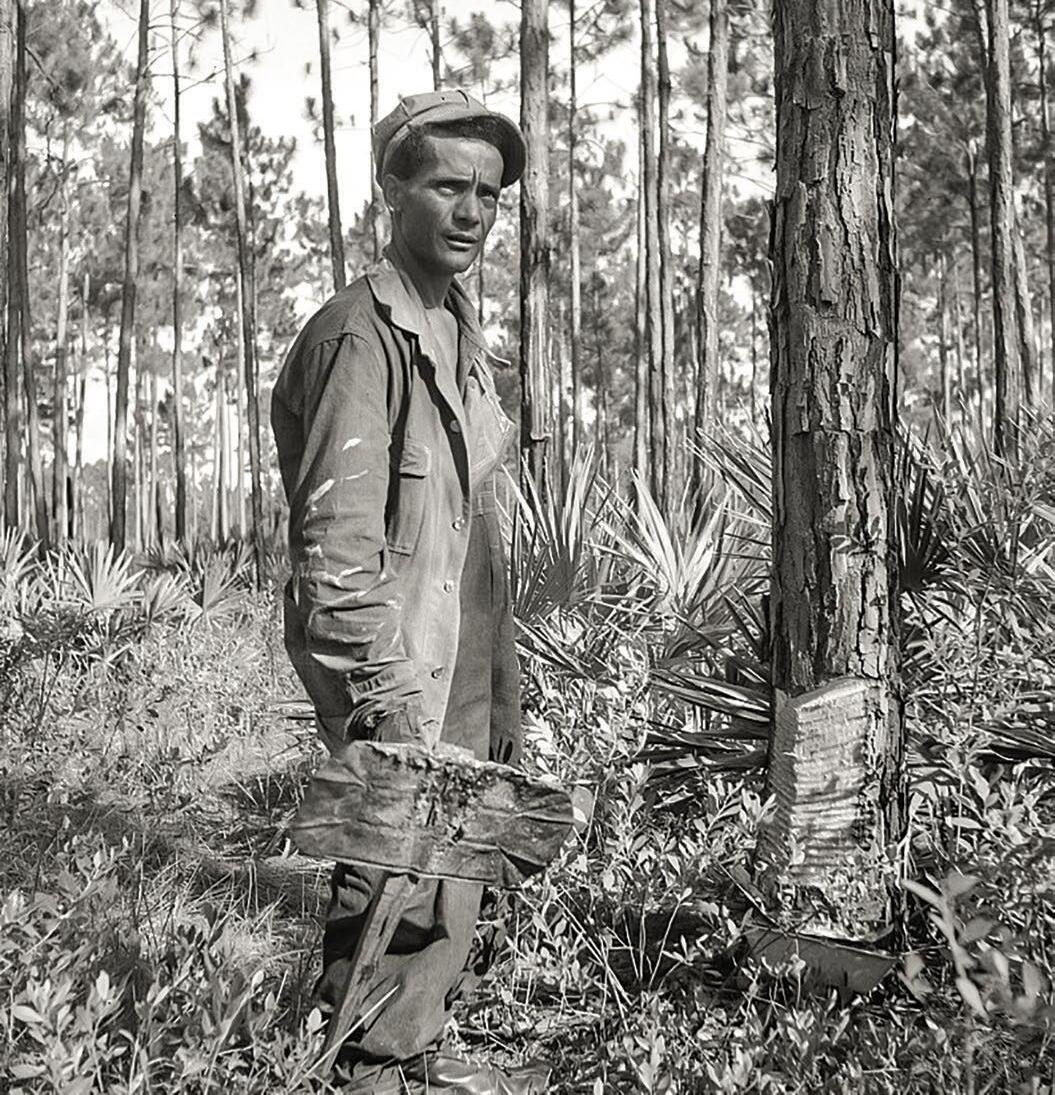
The dirty, sticky, ‘can to can’t’ work regimen was a grueling treadmill, given its tree-to-tree walking requirement, at times through thick brush, mud, or standing water. While heavy, the tools used for tree chipping were light compared with gum buckets, which could weigh 50 lbs. when full. Throw in searing heat, stifling humidity, hordes of mosquitoes and other insects, and the always there snake threat. Add high quotas imposed by demanding camp bosses and enforced by mounted woods riders, who could be ruthless.
No job in the woods paid very much in these decades, but at pennies a day, even up to World War II, wages for turpentiners were as thin as their occasional breakfast gravy.
Turpentine camps were typically located deep within the worked timber, isolated from other communities, houses, or towns.
50 ■ MAY 2023 ■ TIMBER PROCESSING CLICK HERE IF YOU HAVE NOT ALREADY OPTED IN!
A chipper takes a rare break.


CLICK HERE IF YOU HAVE NOT ALREADY OPTED IN!
It is not likely that most tree boxers, gum dippers, wagon drivers, barrel makers, and distillery attendants wanted to be turpentiners, but it is likely that a majority of them did not know anything else, or simply could not find anything better. So, they stuck with it, some for decades or a lifetime, some by choice or circumstance. As a group, turpentine troops were often intimidated by management to be submissive and generally were looked down upon as social outcasts, even though the turpentine industry was a mainstay in the
Southern economy.

Early on, turpentine tasks were carried out by slaves, although some poor whites did join in, often working trees of their own. When longleaf pine gave out in North Carolina around 1860 and turpentine operators relocated to South Carolina or elsewhere to the south and west, they generally moved their slaves with them. Some whites, and even a few Native Americans, joined them, creat-
ing a phenomenon known as the Turpentine Trail, which eventually extended to east Texas.
After the Civil War, many former slaves stayed the turpentine course, following whom they knew and what they knew. Most post-war workers were black, and a majority had roots in North Carolina. They were assigned to work in crops of 10,000 faces—some trees had up to three—and were expected to meet production quotas as tall as the trees themselves. Within a crop, hackers and dippers typically were in charge of 2,000 faces. Each time they worked a face, or a boxer made a new tree cavity, they yelled out their code name to a mounted rider, who recorded it in a tally book and otherwise coordinated the work of a specific squad or two. Boxers were expected to chop 80 to 100 cavities a day.

Few women and children worked in the trade, and those who did dipped gum or kept weeds and debris cleared from the base of chipped trees.
ISOLATION
Turpentine camps were typically located deep within the worked timber, isolated from other communities, houses, or towns. One important benefit of this isolation was the control it provided camp owners over workers and their families.
For the most part, only a token effort went into developing worker housing. Given a camp’s short life, housing for workers usually consisted of shacks or lean-tos, some with a wood stove and fireplace and a small plot for a vegetable garden. Houses in some camps were mounted on skids, facilitating movement from one place to another. Some had a school and church; most had a ‘juke joint’ where weekend drinking, dancing and gambling took place.
52 ■ MAY 2023 ■ TIMBER PROCESSING
CLICK HERE IF YOU HAVE NOT ALREADY OPTED IN!
A woods rider coordinated the work and kept a tally of each worker’s daily performance.
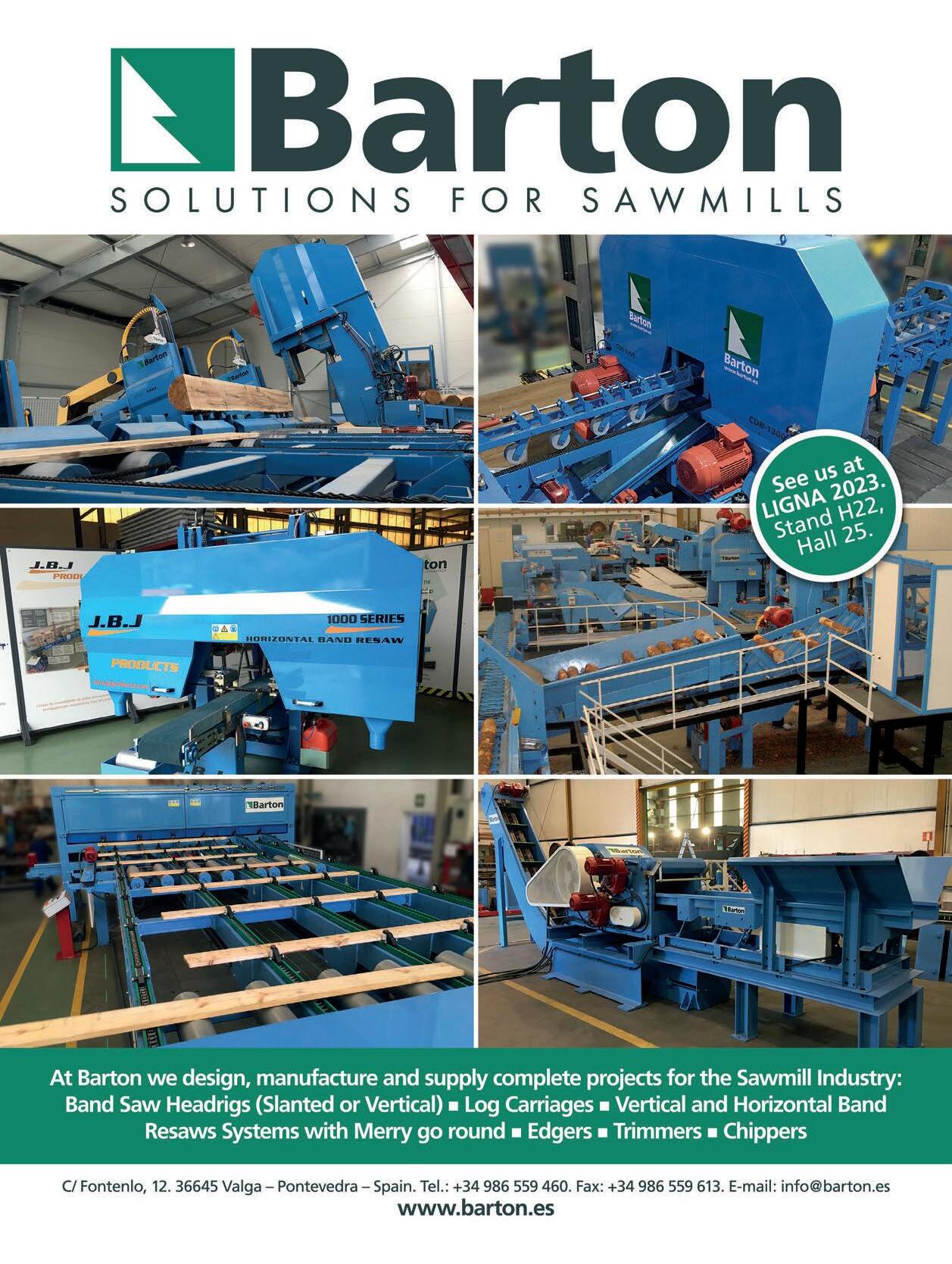
CLICK HERE IF YOU HAVE NOT ALREADY OPTED IN!
Many camps separated married households from unmarried ones, as this helped dampen, but failed to eliminate, confrontations between single and married workers. The number of workers in a typical camp ranged from 50 to 200.
WORKER WOES
Ironically, even though naval stores operations were heavily labor dependent, many of their managers, bosses and foremen treated workers with contempt and in some instances abused
them verbally and physically. On the other hand, a good number treated them with a degree of respect. Some never condoned abuse and a few permitted those unable to work due to age or physical impairments to continue living, rent-free, in camp housing.
The labor requirement led some turpentine, logging, and lumbering concerns to pay fees to agents

in Northeastern cities to recruit European immigrants, who often were fed misleading information concerning the work, pay, and living conditions. Numerous migrants were sent South and reported for work, only to later learn that their transportation expenses were charged against their wages. They were already in debt to their employer when they arrived. If they lasted, foreigners typically had difficulty fitting in with the established social order.
In keeping with the practice of many logging and lumber interests of the period, wages were paid in the form of script, specie or token, and pay was usually based on production. Workers used this ‘currency’ to buy goods at the operation’s on-site commissary, which usually charged higher prices than stores in distant settlements or towns. Even if a worker could get to an outside store, his company pay was no good there. Workers at times drew advances against wages and otherwise more often than not remained in debt to the commissary, the manager of which could easily conduct ‘creative’ bookkeeping.
If workers left to go elsewhere and were indebted to the commissary, they were routinely hunted down, sometimes with the aid of dogs, and forced to resume work. Technically, this was considered debt peonage (forced labor), and a violation of federal law, but several states had adopted laws that to some extent circumvented the federal statute. In the early 1900s federal authorities apparently had little or no enthusiasm for investigating alleged peonage incidents, and even when they did bring charges, few of the accused were convicted. The few convictions that did occur were often struck down by state courts. Prevailing racial attitudes of the period were a primary means of shaping and sustaining the elusive peonage system.
The labor scarcity led some logging, lumbering, mining, farming and turpentin-
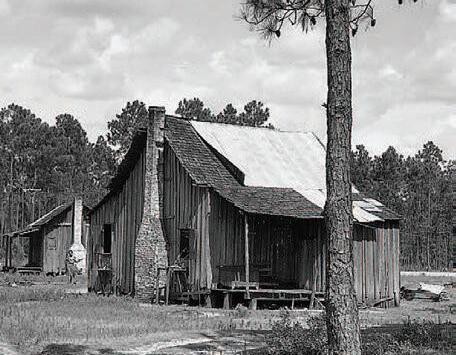
54 ■ MAY 2023 ■ TIMBER PROCESSING
CLICK HERE IF YOU HAVE NOT ALREADY OPTED IN!
Georgia turpentine camp houses, early 1900s
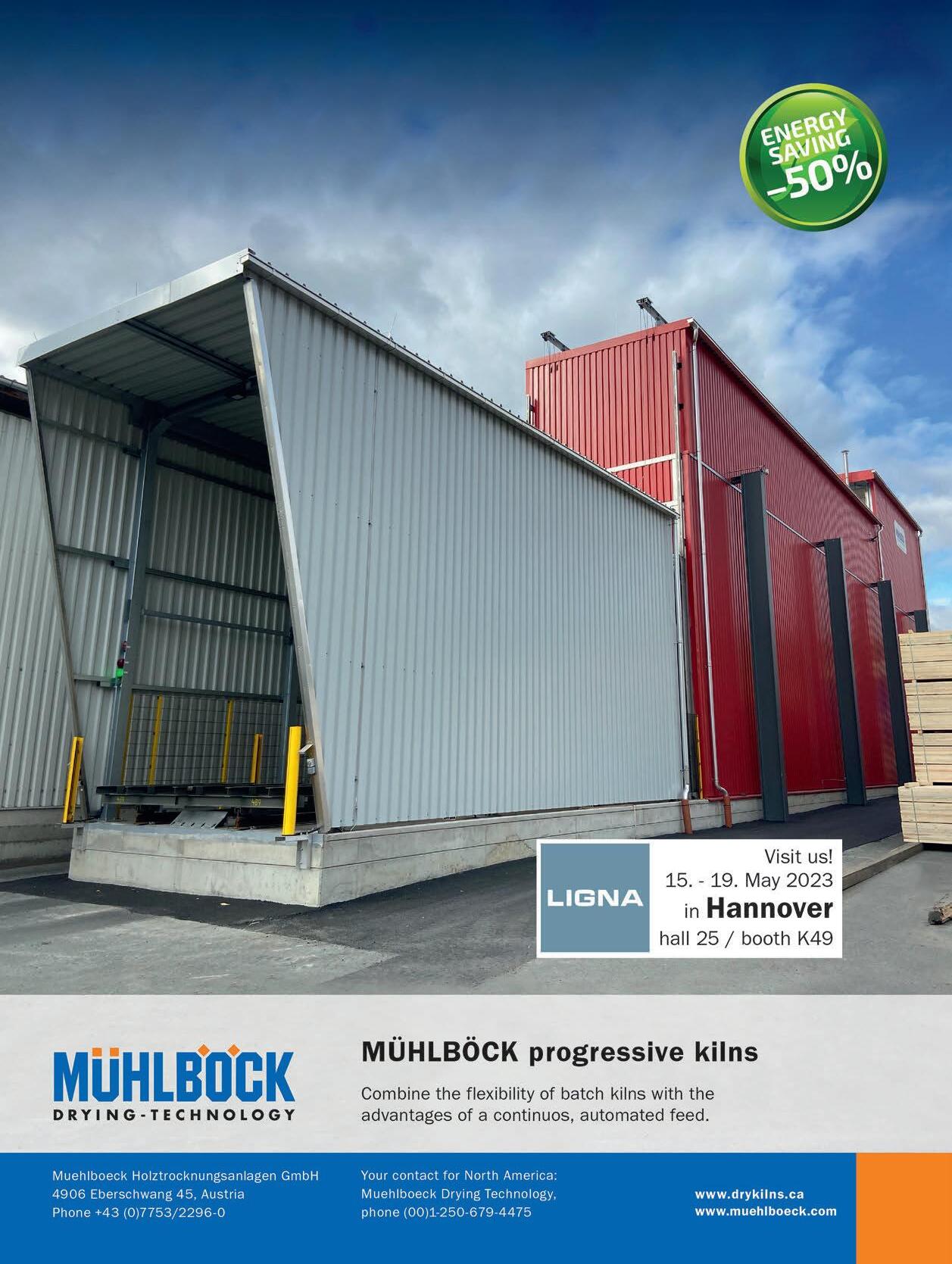
CLICK HERE IF YOU HAVE NOT ALREADY OPTED IN!
ing concerns in Florida and Alabama, and perhaps other states, to lease state and county convicts. At times these operations paid an under-the-table fee to government officials for this arrangement.
TO THE EXTREME

Jerrell Shofner, in an article titled Forced Labor in the Florida Forests 18801950 and appearing in the January 1981 issue of the Journal of Forest History, described two telling incidents, the first apparently in a non-convict camp:
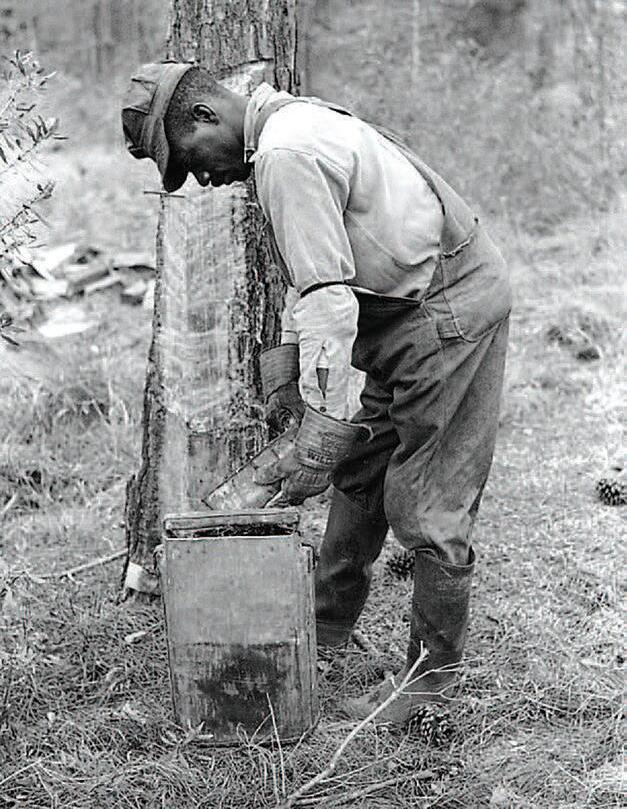
“In 1921 Fred Cubberly (U.S. Commissioner for the Northern District of Florida) found evidence that peonage in all its vicious forms had continued throughout the war years at the Putnam Lumber Company’s Shamrock turpentine camp. The camp boss was ‘Captain’ Austin Brown, who operated the camp according to his own set of laws and had the assistance of the judge of Dixie County.
“Rosa Whitlock described what she had seen while a resident of the camp. Men were beaten regularly for various infractions. They were not allowed to dis-
cuss their punishment or they would be beaten again.
“Brown enforced his rules by keeping workers inside a fenced enclosure guarded at the gates. He had several black informers who kept him apprised of all that happened. Whitlock knew people who had lived in the camp for 15 years, having never seen anyone, including relatives, from outside. She alleged that Brown’s operation differed from a chain gang only in that he paid workers once a month, but even that was small consolation. He operated a gambling house at which all blacks were encouraged under threats of violence if necessary, to gamble. Brown interpreted the rules of the games and usually won…
“Commissioner Cubberly prosecuted Brown (three counts of peonage) in 1923, but the trials were eclipsed by a sensational exposure that finally ended the county convict lease arrangement. Young Martin Tabert, a member of a prosperous, white farming family in South Dakota, set out to see the country
56 ■ MAY 2023 ■ TIMBER PROCESSING CLICK HERE IF YOU HAVE NOT ALREADY OPTED IN!
A dipper pours gum into a bucket.

CLICK HERE IF YOU HAVE NOT ALREADY OPTED IN!
in 1921. Arrested for vagrancy by a corrupt Leon County sheriff at Tallahassee, he was sent to the Putnam Lumber’s camp in Madison County. When his family finally located him weeks later, they found that he had died, allegedly from malaria. They later learned that he had literally been beaten to death by T.W. Higginbotham, the camp’s notorious boss.”
Shofner wrote that the state legislature investigated and found revolting conditions that existed throughout Florida’s turpentine belt, one of which that the local
sheriff had a private arrangement to provide Putnam Lumber with convicts for a fee. The legislature passed a law that forbade the leasing of county convicts to private employers. Higginbotham was later sentenced to 20 years for manslaughter.
Shofner continued the story:
“The shocking revelations and the emphatic legislation changed nothing. Even Higginbotham had his conviction overturned by the Florida Supreme Court. While on bond awaiting retrial, he was transferred by Putnam Lumber to its Shamrock camp, where Austin
Brown had but recently been in charge. There, Higginbotham allegedly killed another man. He was later acquitted in the Tabert case and charges were dropped in the latter one.”
Shofner reported that two turpentine camp operators in Calhoun County, Fla. at times would force an out-of-line worker to spend hours at a time in a small, coffinlike wooden ‘sweatbox.’ Short of the traumatic sweatbox punishment or whipping, authorities in some camps often goaded workers into making work-related mistakes, or falsely accused them of stealing tools or trying to influence co-workers in a negative way.
Conditions improved somewhat during World War II, given the growing scarcity of gum turpentine workers, additional employment opportunities, and more intense competition from wood and sulfate turpentine manufacturers and petroleum companies.

R.W. WISHART
A veteran of 50 years in the turpentine business, R.W. Wishart in 1939 offered his illuminating perspective on the industry and the worker subculture that accompanied it in the first four decades of the 1900s. He was interviewed by Lindsay Bryan of the Federal Writers Project. Wishart had worked at various camps owned by different companies in Georgia and Florida, the largest being a group of eight camps with 120 tree crops and 400 workers.
Wishart described turpentine workers as being in “class by themselves,” saying their behavior differed from that of farm workers or town people. He said most workers he had known were born in a camp, never lived elsewhere, and seldom went to town.
According to Wishart, except for crimes such as murder, local sheriffs tended to let the camp foreman enforce the law. Called “Cap’m” to his face and “the man” in his absence, the foreman was viewed as “the law, judge, jury and executioner,” Wishart recalled, saying it was important that he never show weakness. “If he ever stands for any back talk or shows a streak of yellow, he’s through, and might as well quit,” he said.
Wishart pointed out that fair but firm treatment of workers was an important aspect of handling workers, as was understanding their nature and tendencies. He said workers liked him and would follow him, if asked, when he quit one job and went to another.
He recalled an instance in Polk County, Fla. that depicted how turpentine op-
58 ■ MAY 2023 ■ TIMBER PROCESSING CLICK HERE IF YOU HAVE NOT ALREADY OPTED IN!
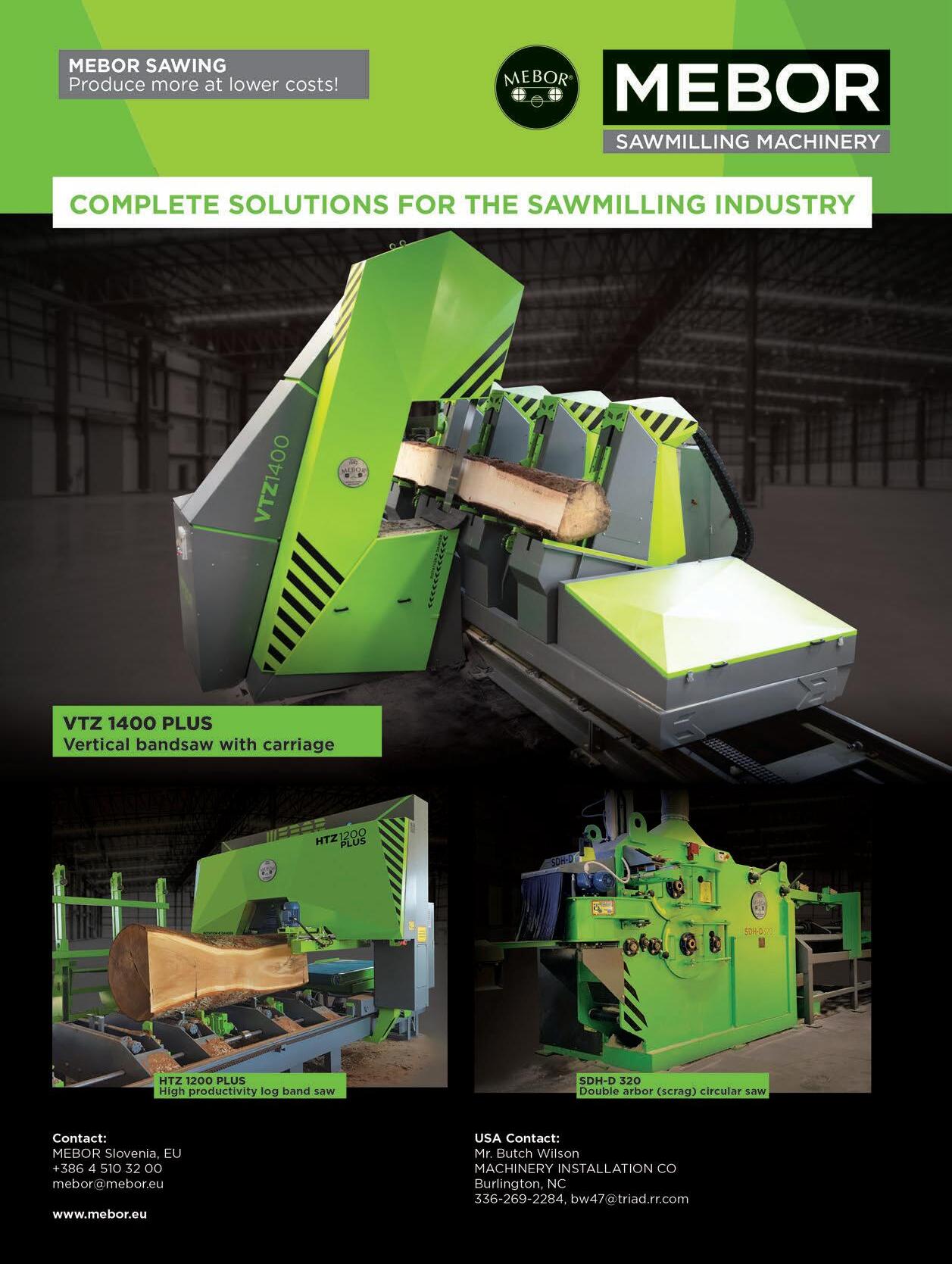
CLICK HERE IF YOU HAVE NOT ALREADY OPTED IN!
erators habitually competed for labor in a manner that was always serious and at times dangerous. On a Saturday night, some 40 of his hands were playing a favorite card game called ‘skin.’ An owner of the company happened to show up and took note of the illegal gambling, which he frowned on, and demanded that the county sheriff arrest them. The owner did not inform the camp foreman of his action. The men were jailed, pending payment of a $35 fine for each. Wishart’s boss refused to pay the fines. While the men remained in jail, word
got to another turpentine company rep that 40 solid workers could be had by paying their fines, which he did. The man sent the men toward his camp but remained behind. Wishart headed off the men and talked them into returning to his camp, promising they could gamble without fear.
Several days later Wishart said he encountered the man who had paid the fines, and he complained that “some SOB stole” 40 good workers from him after he had paid their fines to get them. “I sympathized with him and it was
weeks afterward before he found out it was me got his hands,” said Wishart, who later learned that meanwhile the man had “stolen” another turpentine operator’s workers.
Indeed, turpentine operators used whatever edge they could find to lure workers away from competitors. In the book Judge Harley & His Boys, Billy Langdale, son of Judge Harley Langdale, Sr., a largescale operator based in Valdosta, Ga., recalled going on recruiting trips to Florida with a generous supply of moonshine whiskey in hand to “soften up” potential recruits as he told them about advantages of working at the camp he managed at Mayday, Ga.
It seems fitting that this series should conclude with the way it began (March 2023 issue):
It was dirty, demanding, and destructive, a remarkable forest-based industry that endured for most of three centuries and even today is survived by a distant remnant. It was a major component of the South’s economy, but it wiped out untold volumes of longleaf and slash pine timber and scarred the lives of many who toiled at the tasks it entailed. And, in some instances, it left a shameful wake of social wrongdoing. TP
Note: Some information and illustrations in this article appeared in Naval Stores—A History of an Early Industry Created from the South’s Forests, James P. Barnett, U.S. Forest Service, June 2019.)
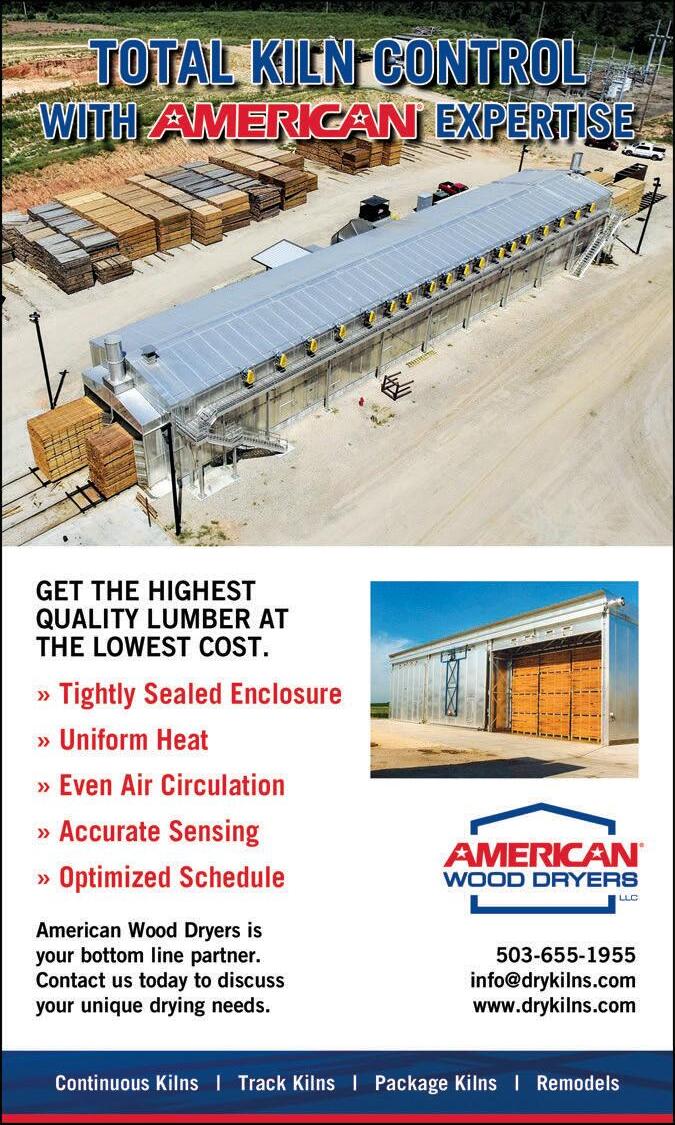
STILL GOING
Varn Wood Products of Hoboken, Ga. is known today as a progressive sawmill operation, but the Varn family history has turpentine running all through it, dating back to the mid 19th century. Much later, the family obtained the first government license for the Olustee distillation system and developed it commercially in 1939. That process greatly improved rosin quality by filtering out trash prior to stilling. The Varn family was in the naval stores business into the late 1960s, and then went into sawmilling. Even today, Varn proudly produces four barrels of gum each year—enough to run the fire still at the Abraham Baldwin College of Agriculture Museum in Tifton, Ga. Most likely, the Varns were some of the good guys as to the treatment of their labor.
60 ■ MAY 2023 ■ TIMBER PROCESSING
CLICK HERE IF YOU HAVE NOT ALREADY OPTED IN!
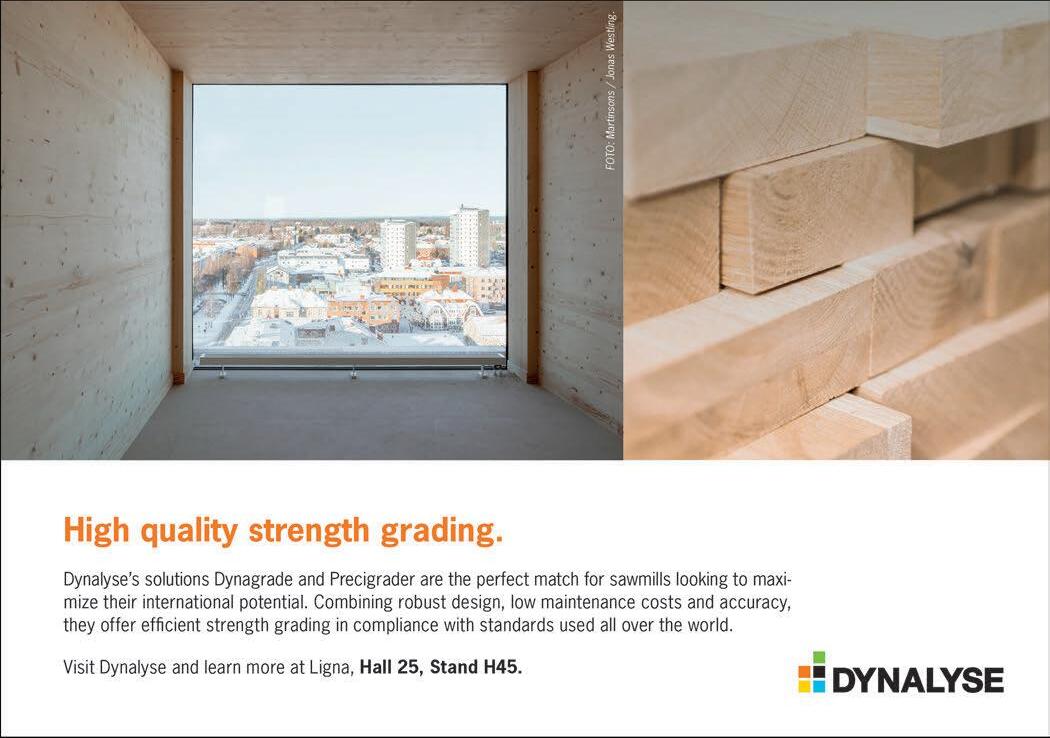

CLICK HERE IF YOU HAVE NOT ALREADY OPTED IN!
PLANERMILLBONANZA
EDITOR’S NOTE: The following companies submitted these editorial profiles and images to complement their advertisements placed elsewhere in this issue. Please refer to those advertisements for web site and contact information. All statements and claims are attributable to the companies.
BID GROUP
As you know, there is nothing like personal work experience, including frustrations, to motivate change and improvements. The design of BID Group’s Miller planer is based on an in-depth knowledge of the needs and problems in the planer mill. The result is innovative design and top-quality material and technology used to facilitate operation, maintenance and ensure maximum uptime.
l Easy to Operate with Our User-Friendly Dashboard
The planer dashboard displays data to provide visibility of all operating conditions which facilitates troubleshooting and maintenance. Recent features include the machine asset health as well as the vibration and temperature analysis.
l Built for Maximum Uptime, Speed, and Accuracy
The Miller planer is mounted on the heaviest frame and sub-base in the industry to handle the most demanding applications and ensure durability. All planer parts are manufactured with materials that reduce wear and metal fatigue. Price or complexity is not an issue because the objective is to ensure the planer offers maximum uptime, the fastest speed and absolute accuracy.
The planer can process pieces that are 8 ft. + in length (there is no length limit) and 1x3 to 6x12 in. width, with speeds up to 3,000 FPM. The Miller planer offers several automated functions, and adjustments can be performed easily on the outside of the machine.
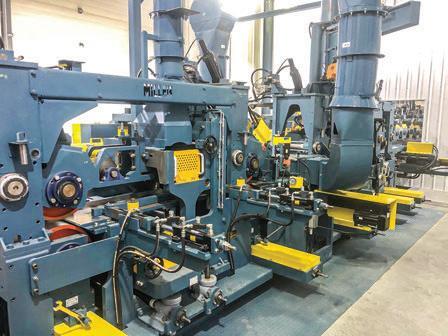
l Handles
Lumber in Every Possible Condition
Our new Integrated Force Position (IFP) technology allows feeding thick, thin and wavy lumber even when it is partially covered with snow or ice. Our planer has industry leading setworks that ensure repeatability, anti-backlash jacks, hydraulic locks and it is servo driven.
l Add Value with Our Profiling Splitter
The new Profiling Splitter module can be installed after the planer to execute the splitting of pieces. It can split the whole range of board sizes and finish the edges and corners. For example, if we split 2x8 into two 2x4s you can process up to 1,200 FPM, so it is actually a production of 2,400 FPM of 2x4.
CARBOTECH
Carbotech is a specialist in the manufacture of sturdy equipment for sawmills, planer mills, and other businesses that need reliable, long-lasting technical solutions for their operations. It strives to provide optimal equipment and solutions that contribute to their clients’ success.
Thanks to its 35 years of experience, Carbotech is renowned as an innovator in the manufacture of lumber handling solutions. The company constantly invests in R&D to make its equipment more efficient and reliable while continuously improving the industry.
Recently, Carbotech has used its solid expertise to enter a new market—log handling, with the recent addition of the Stream Feeder to its lineup. Designed to improve efficiency, productivity and, ultimately, profitability, it is ideal for any process that needs to unscramble logs before they head to a log merchandiser, log sorting system, debarker infeed, or primary breakdown infeed.
l Autolog—optimization and automation of the wood processing industry
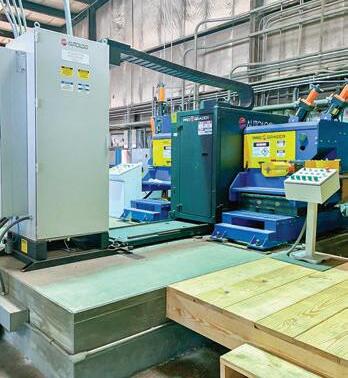
When Carbotech acquired Autolog, which has 35 years of knowledge and expertise in sawmill optimization/automation technologies, it took a big step toward offering a truly comprehensive range of turnkey solutions for the industry. Autolog provides solutions to the wood transformation industry for businesses of all sizes, from large corporations to small entrepreneurs.
Autolog started its journey by offering industrial controls such as lumber sorters to reduce head count and streamline operations. It has since become recognized worldwide as a pioneer in wood processing optimization. It offers solutions for every part of the sawmill processes, including log merchandisers, log sorting systems, breakdown equipment, board edgers, trimmers, sorters, and stackers. It also offers innovative solutions for optimizing planer mills, such as the well known ProGrader, the fully automatic grading system using AI, and for automating their processes.
For Carbotech, acquiring Autolog was a natural choice. Both companies share similar values such as offering optimal solutions and excelling in customer service. It was simply the logical next step to providing an all-encompassing solution for the industry.
62 ■ MAY 2023 ■ TIMBER PROCESSING
BID Group Miller planer is built for efficiency and uptime.
CLICK HERE IF YOU HAVE NOT ALREADY OPTED IN!
Carbotech-Autolog Prograder automatic grading system with AI


CLICK HERE IF YOU HAVE NOT ALREADY OPTED IN!
PLANERMILLBONANZA
DELMHORST
Delmhorst introduces the Navigator family of moisture meters with the release of models JX-20 and JX-30, bringing lumber/woodworking, flooring professionals and inspectors two professional-grade tools to use with complete confidence.

Both meters are packaged in a robust and ergonomically designed ABS case (pat pending) to provide a premium, tactile feel, and intuitive user interface with dashboard-like display. Together with the new Delmhorst EDGE app (JX-30), users can customize meter settings and share MC data quickly and accurately.
The meters carry a 2-year limited warranty.
The most valuable tool to use with the new JX meters, or any Delmhorst meter, is the 26ES hammer electrode. The contact pins that come with the 26-ES penetrate 1 1/8 in., have insulated shanks and only the tips are exposed. The pins’ uncoated tips make contact with wood fibers and provide much more accurate readings of moisture content at various levels of penetration. This feature is useful for a variety of different applications:
l Dry kiln operators: Identify shell vs core moisture levels. The moisture gradient is a critical piece of information for a defect-free, high quality lumber product.

l Furniture manufacturers and craftsmen: Easily check the MC of high density hardwood that short pins are unable to penetrate.
l Flooring installers and inspectors: Penetrate through flooring to plywood sub-floor.
Moisture meters are easier than ever to use and now with exciting Bluetooth connectivity, moisture meters offer great flexibility and customization. They are fast and accurate, and the information they provide are critical to making good decisions, whether drying lumber, building quality furniture or installing a hardwood floor. You can make best use of your meter by learning its capabilities, following the manufacturer’s procedures and recommendations, and of course supported by your own knowledge and experience.
Delmhorst Instrument has been in the field for more than 75 years. Our products are produced in our New Jersey facility and known worldwide for accuracy, rugged construction and our legendary support.
DYNALYSE
Dynalyse’s Dynagrade and Precigrader are two products designed for lumber or timber strength grading. To date, the systems have been installed in more than 200 planer mills, sorting mills and glulam factories in 15 different countries.
Combining robust design, low maintenance costs and accuracy, both Dynagrade and Precigrader are particularly well-suited for sawmills looking to maximize their international potential, as they offer strength grading in compliance with standards used all over the world. They allow for timber strength grading for most of the common grades in Europe, such as C18, C24, TR26, C30, T15 and T22, and in North America the MSR grades such as 1650f and 2100f. The products are also used for grading into standards used in Australia, Japan and New Zeeland.
Precigrader also includes an accurate measurement of the wood E-modulus (MOE) and wood density of each passing piece. The efficient machine stress grading capacity is more than 250 lpm. This fact and the strong correlation to wood strength makes Precigrader an optimal solution for structural grading of lumber or timber.
The products are easily installed in dry sorting mills and planer mills, with a footprint of less than 1.5 m (5 ft.) each. For any sawmill looking to maximize their potential, accurate strength grading particularly in higher quality classes is a great addition to the business.
l Densigrader is Dynalyses system for moisture sorting of each passing wet lumber or timber piece up to 250 lpm. With Finna Sensors’ moisture meters, the combination provides an accurate moisture measurement and sorting of dry and wet wood. The moisture data is aggregated into a database for further handling by the kiln operator, allowing for high efficiency drying processes.
Dynalyse is a Swedish company specialized in product quality measurements for sawmills. The company’s experience in developing and offering products for measuring quality properties spans more than 25 years. Through technical development, collaboration with both academia and the industry, Dynalyse has developed products that are used in sawmills around the world. The company’s solutions have been tested and verified by independent institutes. Through knowledge, long-term relationships with customers, an international outlook, Dynalyse has developed robust and sustainable products.
64 ■ MAY 2023 ■ TIMBER PROCESSING
Delmhorst new Navigator moisture meter
CLICK HERE IF YOU HAVE NOT ALREADY OPTED IN!
Dynalyse specializes in high quality strength grading.

CLICK HERE IF YOU HAVE NOT ALREADY OPTED IN!
GILBERT
Gilbert is well known in Roberval, Canada for its state-of-the-art manufacturing technologies. By using the most modern equipment to operate the factory, Gilbert’s engineering team has replicated the same technology in its planer equipment.
Many planer mills require extra flexibility and capacity today. The Gilbert technology can be compared to a CNC tooling machine. Tools can be used to plane high quality lumber from low speeds of 200 FPM (60 mpm) up to high performing speeds up to 4000 FPM (1200 mpm)! From 0.5 in. to 6 in. thickness and up to 16 in. wide. Then, different tools can be used to split the lumber in two, three or more pieces. Vertically and horizontally.
Gilbert has always been recognized for being the fastest planer in the world. And now, has proven to split at the fastest speeds as well, over 2000 FPM (600 mpm).
Special side head tools can be used to make special patterns, such as tongue and groove. Gilbert has developed 6 in. (150 mm) side heads with three or more patterns. If the mill changes from one product to the other, the side heads can automatically switch from one pattern to the other. Side heads can stay in the planer three times longer.
This Moulder Planer sold to AB Karl Hedin in Sweden is designed to run lumber at more than 200 lugs per minute, and with the same machine, make special profiles and split the lumber at the end. This is their second Gilbert Moulder, with the most recent upgrades. Their first planer was installed in 2008 and has been running successfully since.
Many automatic and safety functions have been developed over the past years, like top and bottom head jointers, side head jointers, top head pressure plate, width and height adjustment, after-cut shoes and triple pattern side heads. Very precise, these automatic upgrades increase the quality of the wood finish, ensure safety and efficiency.
Adjustments are made remotely from the HMI screen outside the planer room, or from a tablet or phone anywhere in the mill. With special features like the triple pattern side heads, the operator can remotely switch from one pattern to the other, without stopping for jointing, or changing side heads on the machine. Keeps nicer finish, and less work required!
HOGUE INDUSTRIES
Hogue Industries is now offering a single station high speed lumber stacking and strapping system. The system features a compact strapping system that fits within the stacker’s primary and secondary package accumulation lift area to replace the sprawling conventional strapping systems of today.
l A typically lower capital expenditure requirement due to a much smaller floor space requirement, less mechanical and electrical installation costs with far fewer outfeed conveyors and controls.
l High speed package strapping with all the required battens, corner protectors, top and side compression and 2, 3, or 4 straps applied simultaneously at the stacker.
l A finished unitized package discharges from the stacker lifts to the outfeed package transfers.
Simultaneous strapping can deliver a higher volume of finished packages to the discharge conveyors.
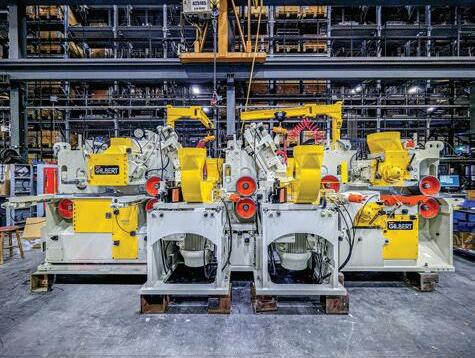
The operating costs have been reduced with the innovative corner protector and tie strip combination that is designed for safety, efficiency, and lower cost.
The new strapping system is designed to match the output of a double fork stacker all within a single station. No more package tracking, or disintegrating packages trying to get to a remote strapper systems, as the package is strapped at the stacker.
The system can shift out a disabled strapper and shift in a functioning strapper to optimize production. The system is all electric and pneumatic with no hydraulics.

66 ■ MAY 2023 ■ TIMBER PROCESSING
PLANERMILLBONANZA
CLICK HERE IF YOU HAVE NOT ALREADY OPTED IN!
Gilbert moulder planer bound for an operation in Sweden.

CLICK HERE IF YOU HAVE NOT ALREADY OPTED IN!
PLANERMILLBONANZA
MELLOTT
Mellott Manufacturing designs and builds complete tilt hoist and conveyor systems to unstack stickered packages of lumber, creating flow to streamline the stick handling process.
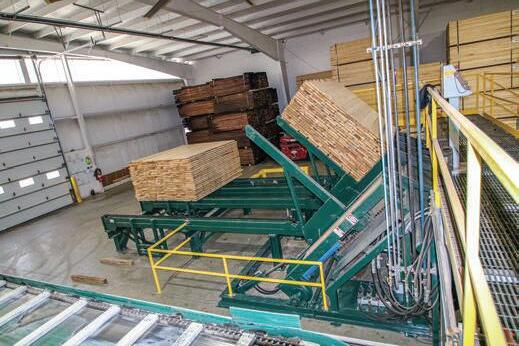
Mellott offers standard machine designs in a 7-ton tilt hoist and a 15-ton tilt hoist. The 7-ton tilt hoist is designed for lumber packages 66 in. high by 72 in. wide and 18 ft. long, and the 15-ton model will handle packages 72 in. high by 96 in. wide and 18 ft. long. Both models can be customized as required.
The Mellott tilt hoist design features a base frame constructed in two pieces so that the forks are able to be assembled onto the columns for shipping and ease of installation. The steel columns are welded to a 10 in. diameter pivot tube on the 7-ton tilt hoist and a 16 in. diameter pivot tube on the 15-ton tilt hoist with flame cut plates that completely wrap the tube. At the top is a 3 in. square tube to tie all the columns together for extra strength. Steel rollers are used in each of the forks in order to distribute the load to all of the columns.
The lift cylinders, lift chains, and leveling chains are protected behind removable steel plates. This prevents kiln sticks from sliding into this area, limiting damaged and broken sticks.
Hydraulically powered by dual lift and dual tilt cylinders, the hydraulic cylinders are cushioned and rated at 3,000 psi. Dual heavy leaf chains are used in an ‘X’ arrangement for load leveling. Packages are lifted using RC240 roller chains on the 15-ton tilt hoist and RC160 roller chains on the 7-ton tilt hoist.
The tilt hoist can be operated with manual or automatic controls. The automatic control package includes a PLC and necessary limit switches for automatic unloading of layers from the tilt hoist to deliver one course of stickered lumber at a time and two speed raising of the tilt hoist arms. Complete control systems including the main disconnect, and all motor controls can be provided and fully tested at the factory.
Mellott also provides conveyors to complete the system. Mellott is capable of providing engineering and custom designs to create infeed and outfeed conveyors for a new project or integrate into an existing system. The stick removal belt conveyors with slide will remove the sticks, and they can be transferred to a manual or automatic stick stacking system. The Mellott stick stacking system includes a 2-chain aluminum bar type stick unscrambler with chain transfer sorted to stick carts.
Mellott also offers unscrambler systems for breakdown of non-stickered lumber packages. These systems include package decks, waterfall decks, normal and singulating unscramblers.
Mellott Manufacturing has an on-site engineering and design team capable of meeting the specific needs of each application. Their product line covers log and lumber equipment for sawmills, resaw and grading systems, tie dapping, sorting and stacking, along with a wide variety of custom projects.
The Bundle Dumper system falls into the last category. It is a combination tilt hoist/unscrambler for use in applications with limited space. This standard unit is designed for packages up to 40 in. high, 48 in. wide, and 16 ft. long.
MURRAY LATTA
The MLPM Pro-Edge Tec 111 fully automated grinder is a reliable and user-friendly machine that offers a range of benefits. Designed with heavy duty components, this grinder is built to last and requires minimal maintenance. Unlike other grinders, the Pro-Edge Tec 111 does not rely on pneumatic or hydraulic components, making it a cost-effective choice for any production line.

The Allen-Bradley controls and ethernet access make it easy to troubleshoot the machine remotely, reducing downtime while increasing efficiency. The intuitive error codes and fault lists provide a clear platform for off-site maintenance and servicing, making it simple for operators to diagnose and fix any issues that may arise.
Accuracy is a key feature of the Pro-Edge Tec 111, which can hold tolerances of .002 in. to .005 in. for knives up to 15 in. in length. The machine can also grind a range of cutting heads, including top/bottom hydro lock heads, tapered side heads, flat knives and “L” type knives automatically during its transverse and indexing stages. With a maximum cutting circle of 20 in., this grinder is a very versatile solution for a range of cutting applications.
Overall, the MLPM Pro-Edge Tec 111 fully automated grinder is a reliable and user-friendly choice for any production line. With its heavy-duty design, intuitive controls, and ethernet access, this machine offers a range of benefits that make it a cost-effective choice for any business. Its accuracy and versatility make it an excellent choice for a range of cutting applications, and its low maintenance requirements ensure that it will continue to perform reliably over the long term.
68 ■ MAY 2023 ■ TIMBER PROCESSING
Mellott tilt hoist and stick stacking system
CLICK HERE IF YOU HAVE NOT ALREADY OPTED IN!
Murray Latta advanced automated grinder
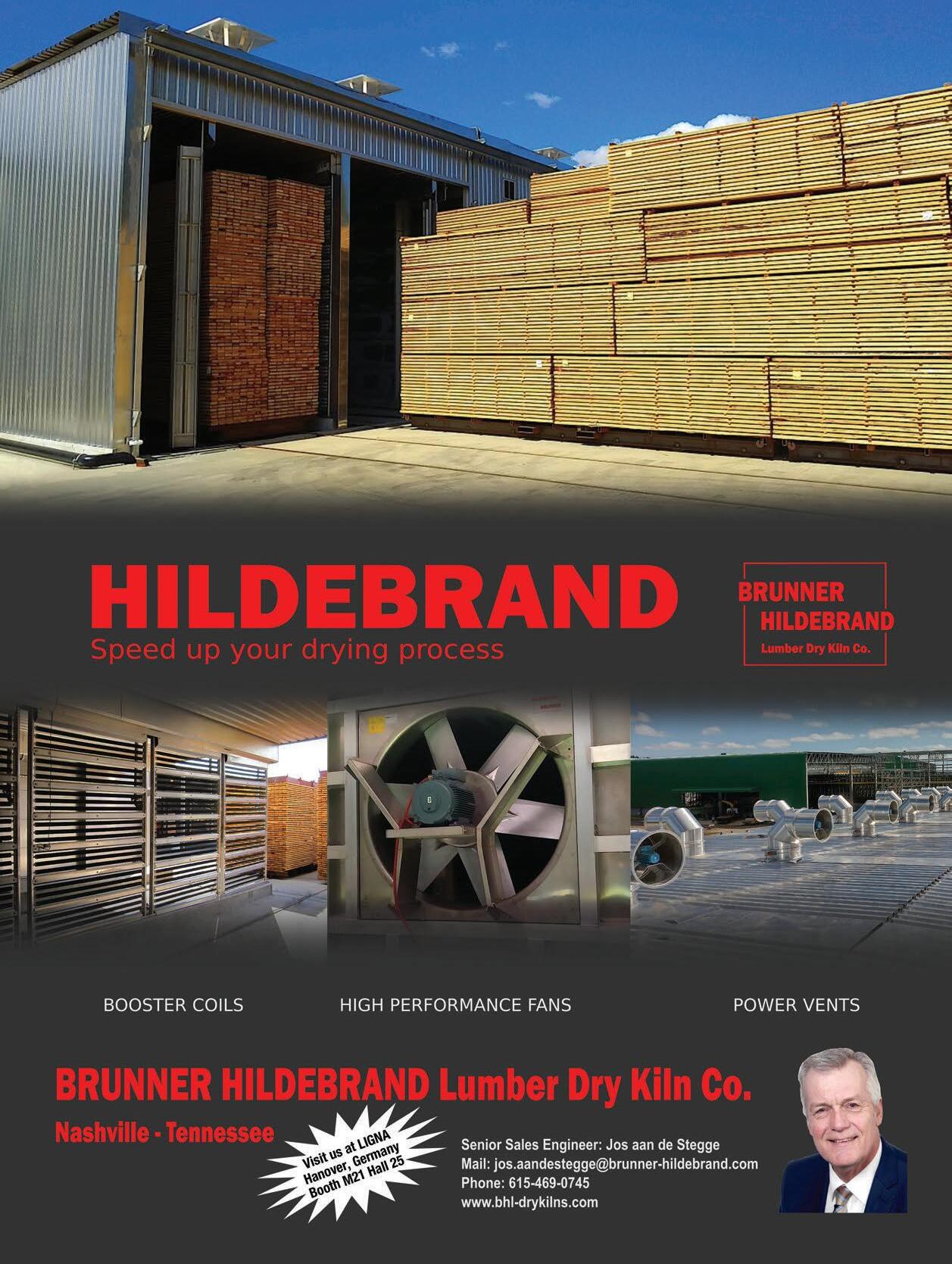
CLICK HERE IF YOU HAVE NOT ALREADY OPTED IN!
PLANERMILLBONANZA
PICHÉ
When it comes to your planer mill operation, PICHÉ can offer a multitude of innovative solutions to fit your needs—from the newly designed “servo-driven” auto leveling continuous tilt hoist with automated high-speed planer infeed transfers, to automatic “product driven” adjusting slow down belts.
Here at PICHÉ, attention to small details is our goal. Like our lug loader with servo driven transfers having our special designed pinchers to prevent marking of your high-grade material to our simple, robust infinite adjusting fences. The high speed, low maintenance, lineshaft trimmer with doors that open to act as service platforms on both sides. The heavy duty bin sorters that are fully lined with UHMW on bin walls and bin floors with internal diverters to keep that “chimney effect” out of the picture. We also manufacture tray sorters, both with integrated cut in two systems.
We build high speed package maker systems with automatic edge and layer even ending as well as dual inline strapping layouts to enhance strapping time and generating perfect finished packs for your mill. We offer full mechanical and electrical installation packages and controls. Our controls by Logitex are simple, very user friendly, and offer a specialized solution for your mill’s needs.

And last and most importantly, a dedicated startup, service, and parts team on call 24/7 365 days a year. Come Let PICHÉ help design and install your new, or upgrade your existing planer mill for the best results in the industry.
SPRINGER
Springer, the leading supplier of integrated solutions for the timber industry, is celebrating its 70th anniversary. The globally active, family-run business emphasizes new developments in log and lumber processing, including their latest innovative product—a new high-speed feeder solution for lumber sorting called the E-Loader.
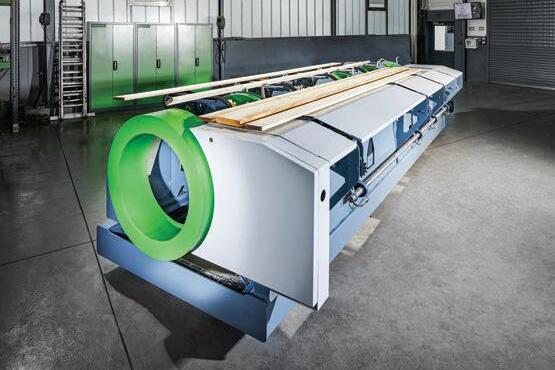
Customers from more than 30 countries and six continents rely on Springer’s decades of experience and innovative customized solutions. The E-Loader is the newest product innovation by Springer and once again brings a feeder solution for lumber sorting to market. What sets the E-Loader apart is its high-performance capacity and the fact that the machine can simultaneously process board thicknesses between 12 and 120 mm without any restrictions on board width.
Egon Eisner, Head of Product Development at Springer, outlines the special features and functions of the new E-Loader. “The E-Loader is used for singulating pieces of lumber. An accumulating conveyor is used to gather the boards in a backlog position and hold them back with a flap located upstream of the E-Loader. From there, the feeder arms pick up the board and lift it directly into the lug of the downstream lug chain conveyor.”
Eisner explains the distinguishing features of the E-Loader: “What sets the E-Loader apart is its high degree of availability and performance capacity. Its variable, individually controllable feeding nose makes it possible to cover a very wide range of dimensions. Furthermore, it can be adapted to each board thickness. The thickness of the boards is determined by a measurement upstream of the feeder. This function causes the lower feeder nose to be lifted or lowered. Thanks to this flexibility, the upper and lower feeder arm hit the board at the same time. In addition, the geometry of the variable arm creates greater support during lifting. This means that even large dimensions can be singulated with a bigger board support.”
During development, Springer placed a special focus on the ease of handling and maintenance of the machine. Equipped with gas springs, the maintenance access plates can be opened easily by hand and can support the weight of maintenance personnel.
Springer’s machines are known for their reliability and precision. They continuously develop innovative solutions to adapt to their customers’ changing needs. This is yet another solution that Springer has added to their lumber feeder portfolio. It has been developed with a focus on reliability, ease of use and maintainability as well as integration into new or existing production lines. With different lug loader configurations available, Springer provides each customer with the opportunity to choose the right machine for their individual requirements.
The E-Loader has already garnered significant interest with two European customers placing orders right after seeing the demonstration. Springer’s innovative product development continues to drive the industry forward, and their commitment to providing individual solutions to customers across the globe has made them a trusted partner in the timber industry for seven decades.
70 ■ MAY 2023 ■ TIMBER PROCESSING
PICHÉ offers innovative technologies and solutions in the planer mill.
CLICK HERE IF YOU HAVE NOT ALREADY OPTED IN!
Springer showcases innovative high-speed feeder solution.
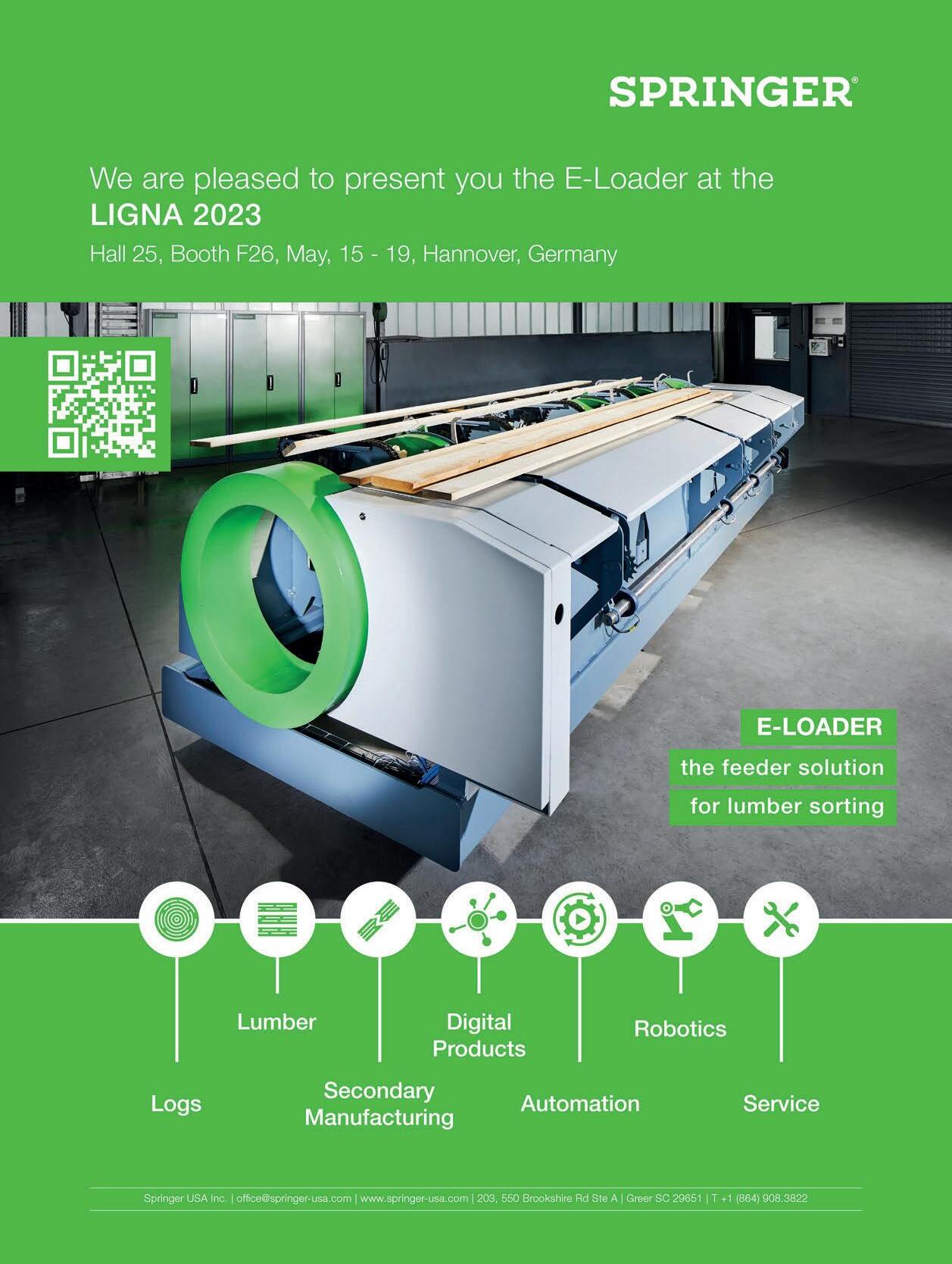
CLICK HERE IF YOU HAVE NOT ALREADY OPTED IN!
PLANERMILLBONANZA
USNR
USNR offers unique solutions to planer mill challenges with significant advances from AI-assisted defect detection to high-speed lumber finishing, ensuring your end products gain and retain their value. Deep learning AI technology is now active on all our auto-grading platforms, increasing grade solution accuracy and reducing startup times. The Transverse (THG) and Lineal (LHG) High Graders are industry-leading products renowned for accuracy and now with the application of deep learning AI, these systems deliver even more value and recovery through advanced optimization.
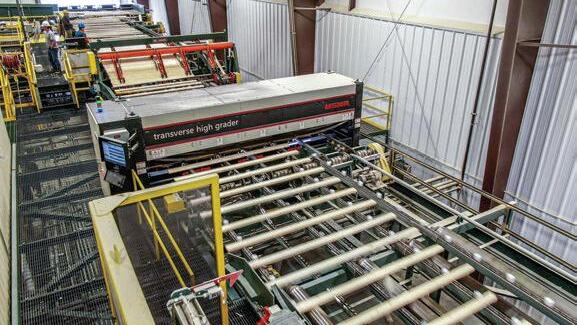
Time-tested image analysis and optimization software combined with the industry’s most advanced sensor available, the BioLuma 2900LVG+, accurately detects, measures, and classifies bow, crook, twist, skip, wane, knots, pith, stains, decay, bark pockets, splits, shakes, and worm holes.
USNR provides complete planer mill equipment solutions including a range of tilt hoist options from hydraulic and electric to continuous designs, and a variety of lug loaders to suit any budget, product recipe, and throughput requirement. The ElectraTong features allelectric actuation and delivers superior board control at speeds up to 250+ lpm while excelling in random thickness applications and handling feather-edge material; whereas the Virtual Lug Loader (VLL) uses belts to efficiently fill lugs with no overhead feeding apparatus, controlled and monitored by MillTrak.
USNR’s 4200E electric planer features all the latest functionality and is capable of gap or ribbon feeding at 3,000+ FPM. Its maintenance-friendly design with shimless bedplates provides fast and adjustable alignment. The ability to change feed rolls from the operator side significantly reduces change-out time.
The Multi-Track Fence has proven to be a top solution for high-speed mills needing super-accurate cost-effective fencing. For mills with a high percentage of cut-n-two solutions, our innovative tandem bin sorter with “no skip-a-lug” is a revolutionary concept that yields big gains in production.
USNR’s WinTally sorter management system integrates with our auto-graders to capture production information as boards pass into the sorter. USNR’s vision based MillTrak system manages the flow of boards at the planer infeed while the MyMill mobile sorter control monitors and controls the sorter from any location within the mill’s network. Contact us today!
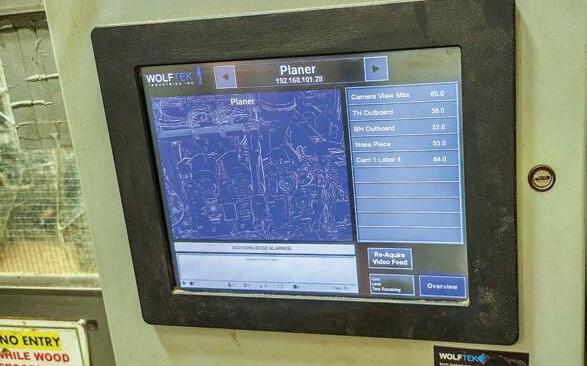
WOLFTEK
Wolftek continues to add to its already large supply of planer mill retrofits with the TMS (Thermal Monitoring System). Using state-of-theart technology the Wolftek TMS is not only used for fire protection but also for planer setup to ensure maximum throughput and uptime. With properly located cameras, mill operators can monitor for incorrect planer setup including misalignment, guide setup and even possible broken or worn out components.
Customers have told us over and over that they bought the TMS for safety and fire protection, but that the payback in the system is for monitoring the heat of the machine thus ensuring the initial planer setup is correct. As an example, a normal running temperature for one customer was 90° C but the TMS alarm was triggered which stopped production, indicating that the maximum temperature was over 200° C. Upon further inspection, it was found that broken pressure plate bolts were causing excessive pressure on one side of the boards being planed. However, with the TMS in place a potential fire was prevented. Production was stopped and the operator notified. while also directing maintenance personnel to the problem. The planer was back and running in a minimum amount of time.
Our thermal cameras monitor temperatures from -20 to +350° C, which ensures that all planers are covered without reduced accuracy and false readings. Up to 10 individual heat zones per camera can be added so that the complete machine will be covered for temperature fluctuations. With historical temperature trending, and active monitoring with interlocking directly to the planer PLC, problems are found more quickly and more efficiently than in the olden days. The active temperature monitoring has paid for these systems by catching bearings prior to failure, and have saved a lot of wear of components because of a tight or misaligned machine setup. With more and more safety concerns like having maintenance personnel inside the planer room while running, this type of tool is essential feedback to the maintenance personnel to ensure correct planer setup and preventing fires while maximizing component life cycles.
72 ■ MAY 2023 ■ TIMBER PROCESSING
Wolftek thermal monitoring system at the planer
CLICK HERE IF YOU HAVE NOT ALREADY OPTED IN!
USNR provides complete planer mill systems with powerfully accurate grading solutions driven by advanced optimization with deep learning AI.
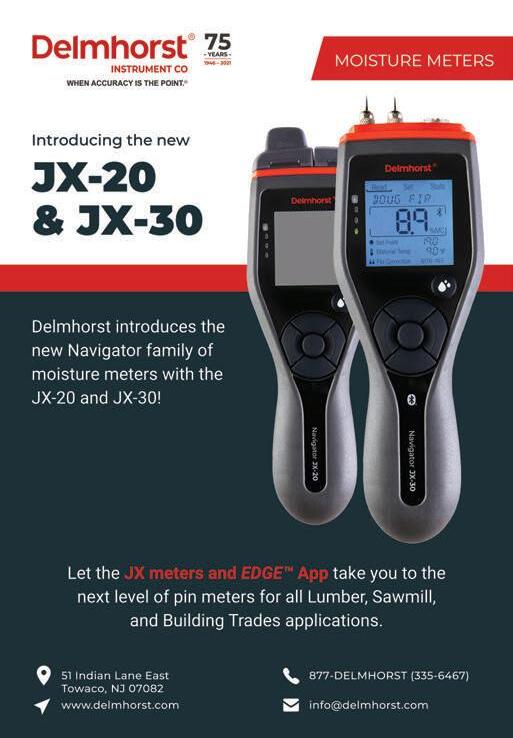
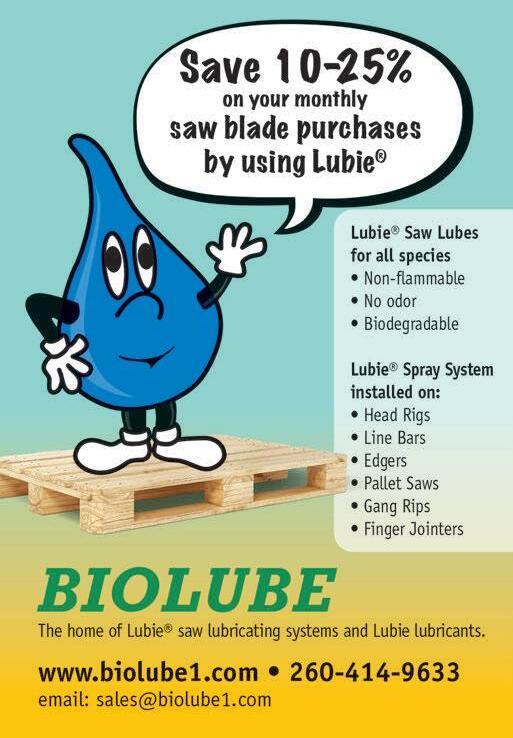
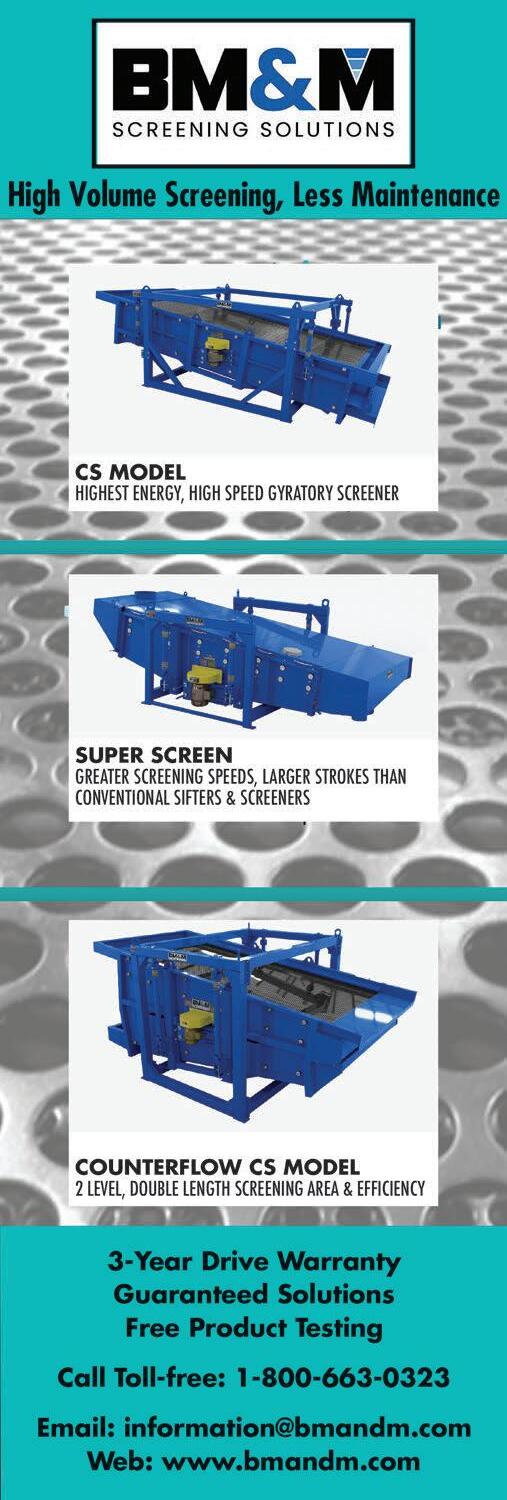
CLICK HERE IF YOU HAVE NOT ALREADY OPTED IN!
PLANERMILLBONANZA
WOOD-MIZER
Produce finished wood flooring, planed boards, crown moulding, cabinet trim, paneling, shiplap, door and window frames, furniture components, and more with Wood-Mizer woodworking equipment including planer/moulders, planer/moulder/rip saws, jointer/planer/moulders, jointer/planers, log moulders, and slab flattening mills.
l MP160 jointer planer efficiently shares one horizontal cutter between two cast iron tables to produce straight-edged boards with the top jointer table and evenly planed boards with the bottom planer table.
l MP180 jointer planer moulder takes the versatile functionality of the Wood-Mizer MP160 jointer planer and adds a vertical side cutter head to the planer table for moulding.
l MP220 planer moulder rip saw features one horizontal cutter for planing or moulding and one circular saw blade for rip sawing, edging, or resawing material.
l MP200 2-sided planer/moulder includes one horizontal top cutter and one vertical side cutter for planing and moulding on the top and side of material at the same time with each pass.
l MP260 and MP360 4-sided planer/moulder includes one horizontal top cutter, one horizontal bottom cutter, and two vertical side cutters for planing and moulding on the top, bottom, and sides of material at the same time with each pass.
l MP100 log moulder is a specialized log moulder head that planes and moulds beams and columns that join together perfectly for any project.
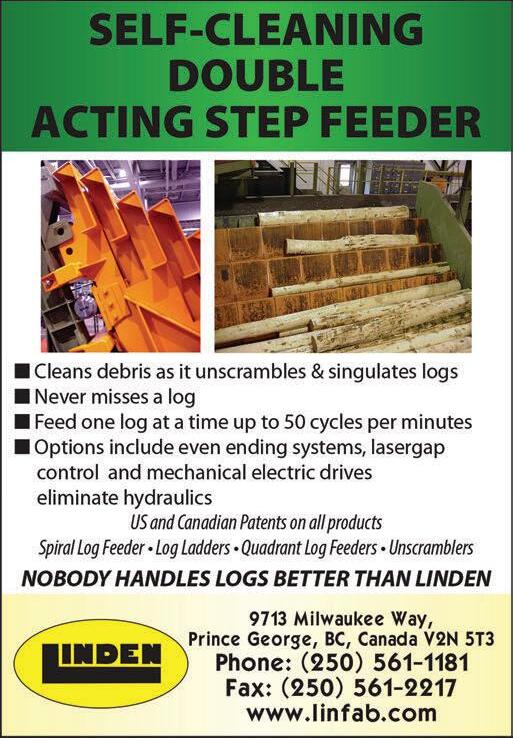
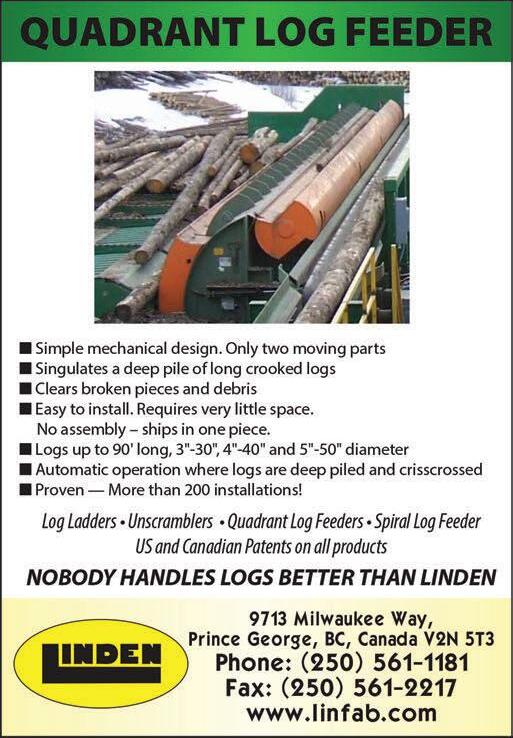
l MB100 and MB200 slab flattening mills efficiently surface and flatten material up to 72 in. wide using a 5 in. cutter head equipped with five 4-sided carbide knives. Compared to a traditional router or planer, the SlabMizer flattens wider and thicker material in less time with minimal effort.
Proven in workshops throughout the world, Wood-Mizer woodworking equipment is backed by the same legendary service, quality and safety features shared by the entire family of Wood-Mizer equipment.
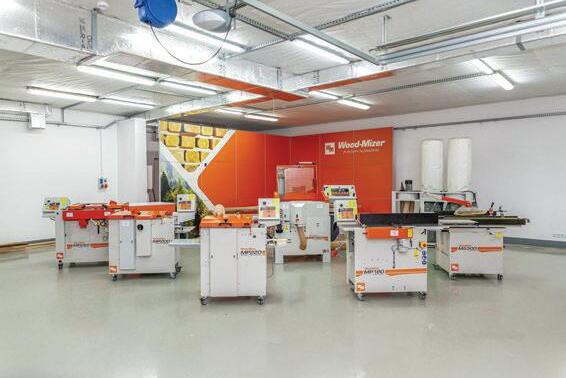
74 ■ MAY 2023 ■ TIMBER PROCESSING
CLICK HERE IF YOU HAVE NOT ALREADY OPTED IN!
Wood-Mizer family of finishing machinery
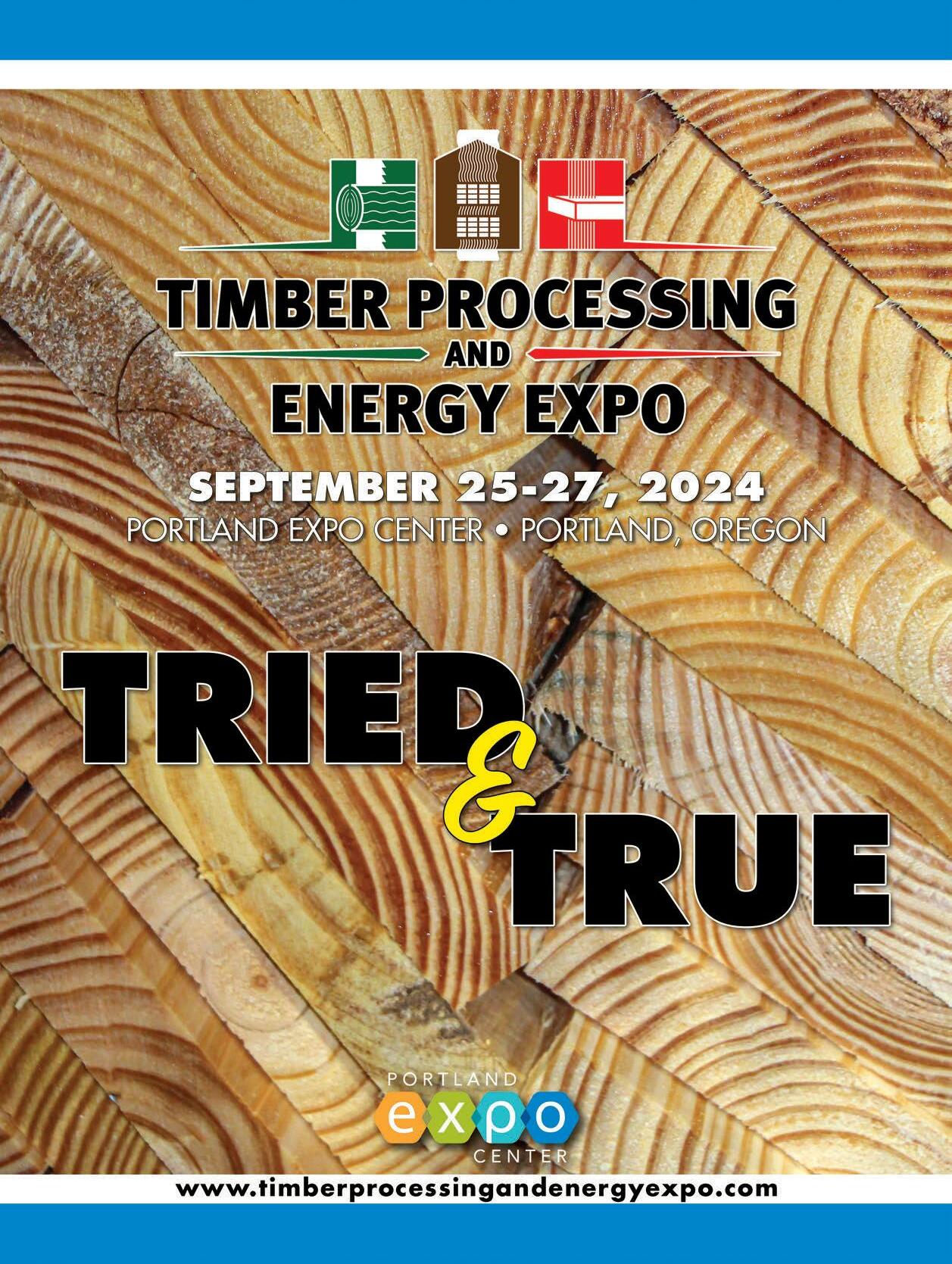
CLICK HERE IF YOU HAVE NOT ALREADY OPTED IN!
MACHINERYROW
Greentree Upgrades Primary Breakdown
Cleereman Industries/Cleereman Controls in cooperation with RTM Industrial Maintenance LLC recently carried out an extensive project at Greentree Forest Products, owned by Greg Wells, in Wallingford, Ky.
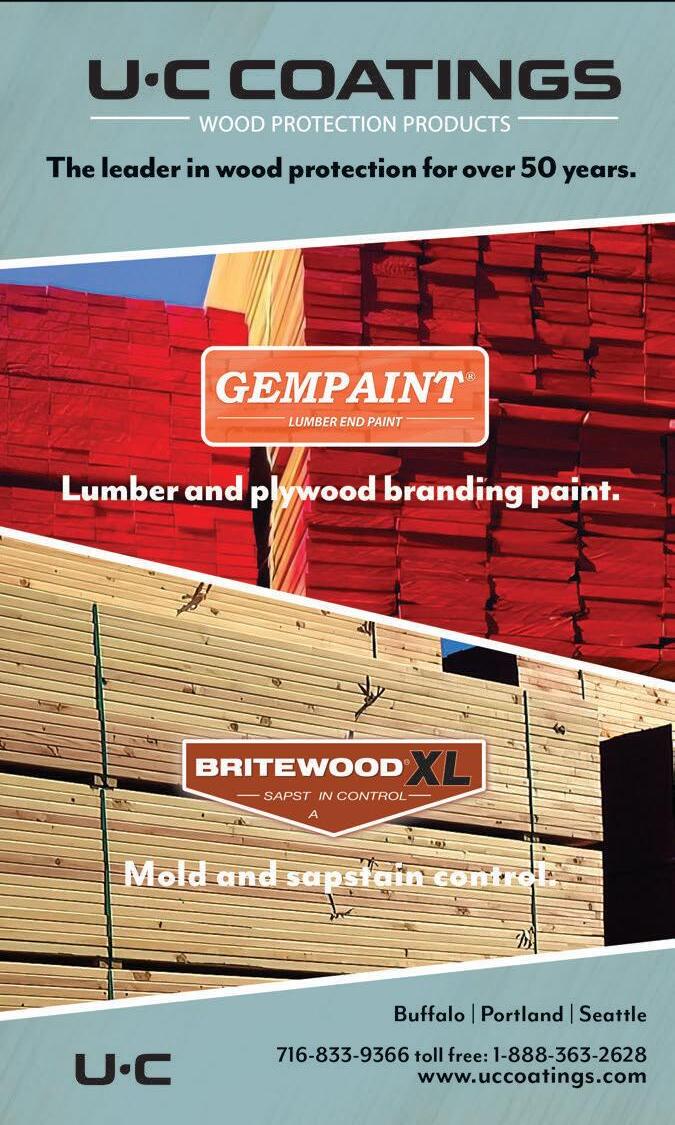

The RTM crew removed the old carriage line that Greentree had run for 27 years, an LP-42 Cleereman carriage, and
replaced it with a new one. Wells decided that as long as he was replacing the carriage with a Cleereman LP-48 Extreme Duty carriage, he would also replace his scanning system with a new Cleereman Controls 3-D scanning system and Cleereman Controls Operator Start/Stop Dispatch Console with everything mounted in a new Cleereman sawyer booth. Wells also decided to replace his older, inefficient shotgun carriage drive with a new energy-efficient Cleereman 200 HP Hy-
drostatic carriage drive. A new Cleereman 42 in. Bar Log Turner was also installed.
RTM Industrial Maintenance took out all of the old equipment and replaced it with new equipment in a little over a week’s time. Cleereman Controls engineers along with hydraulic engineer Jonny Cleereman of Cleereman Industries were on site for startup and training of the sawyer and mill maintenance crew. After a few days of sawyer training and final testing, the mill was ready to start running production.
Also installed were a Cleereman Modular Track-Frame with 80# rail and a Cleereman Cable Tensioner. This project from start to finish took less than two weeks.
Combilift Contributes To Convoy Of Hope

As part of Combilift’s celebrations for its 25th anniversary, the Irish materials handling specialist has announced that it is donating its 75,000th truck—an Aisle Master articulated forklift—to Convoy of Hope, a non-profit humanitarian and disaster relief organization.
Convoy of Hope works alongside communities and its wide network of volunteers aims to alleviate poverty and hunger and to bring help and hope wherever they are most needed in the world. As this type of aid is sadly always in demand, operational expansion has also
Cleereman carriage upgrade at Greentree
76 ■ MAY 2023 ■ TIMBER PROCESSING CLICK HERE IF YOU HAVE NOT ALREADY OPTED IN!
Left to right, Jeff Smethers, Convoy of Hope; Martin McVicar, Combilift; and Erick Meier, Convoy of Hope, as Combilift donates its 75,000th truck to the international charity
seen a corresponding increase in the requirement for warehousing capacity to accommodate the vast volume of supplies that are stored and ready for delivery to areas in need.



The World Distribution Center is based in Springfield, Mo., and from this location at the “Crossroads of America” truckloads of relief supplies and food are sent on their way across the USA and further afield around the globe.
Combilift supplied its first Aisle Master for this site four years ago, and a further three units were delivered last year. Convoy of Hope’s Senior Director - Distribution Jeff Smethers comments, “A lot of our exponential growth has been down to the Aisle Masters as they enable us to get more loads in and out faster. And thanks to Combilift’s free warehouse layout service and the Aisle Master’s narrow aisle capability we have achieved the best possible storage density and very efficient operation.”
The announcement was made at a gala dinner in Chicago during the ProMat trade fair, and Combilift CEO and Co-Founder Martin McVicar commented: “The work that Convoy of Hope does is invaluable to relieve suffering around the world
TIMBER PROCESSING ■ MAY 2023 ■ 77
CLICK HERE IF YOU HAVE NOT ALREADY OPTED IN!
➤ 82
Binderholz Celebrates Sawmill Opening
Binderholz Enfield LLC held a grand-opening in April to commemorate the official opening of its lumber production facility near Enfield in Halifax County, NC. Company, local community, and elected officials participated in the event alongside Binderholz’s corporate leadership from Austria.
The Enfield facility will produce southern yellow pine lumber used in residential and commercial construction. At full production, the plant will have an output capacity of over 200MMBF.
In January 2021, Binderholz acquired the assets of Klausner Lumber, which included production mills in Live Oak, Fla. and Enfield. Despite a pandemic and lingering supply chain issues, Binderholz was able to upgrade the Enfield manufacturing plant to their standards and meet state and local permitting requirements.

“We appreciate the support from Halifax County and the Enfield community during very challenging times,” commented Matteo Binder of Binderholz. “We have worked hard to get the facility operational and now we must shift our focus to getting employees to achieve full production.”
The company started as a small sawmill in Austria more than 70 years ago and grew into a multi-national company with 60 sites across Europe.

“This is a major milestone, not only for Binderholz, but for Halifax County,” Halifax County Board of Commissioners Chairman Vernon Bryant said. “We are grateful to the company for their commitment to Halifax County and we look forward to a long and prosperous partnership.”
The Enfield production facility will further strengthen Binderholz’s presence in the United States market. The Binderholz Enfield plant is forecast to have 120 full-time employees by 2024. Te hiring process will continue until the lumber mill reaches full production capacity.
HMA Elects Petzoldt As President
Hardwood Manufacturers Assn. (HMA) elected Tommy Petzoldt, East Perry Lumber Co., Frohna, Mo., as President of HMA during the National Conference and Expo in Nashville on March 22.
Other HMA officers for 2023 are Vice President Matthew Netterville, Fred Netterville Lumber Co., Woodville, Miss.; and Executive Vice President: Linda Jovanovich, HMA, Pittsburgh.
HMA Board of Directors also elected members to the Executive Committee. In addition to the officers, they are: Hal Mitchell, Atlanta Hardwood Corp., Mableton, Ga.; Scott Cummings, Cummings Lumber Co., Inc., Troy, Pa.; Tripp Josey, Josey Lumber Co., Inc., Scotland Neck, NC; Wayne Law, New River Hardwoods, Mountain City, Tenn.; and Tom Gerow, Wagner Millwork, LLC, Owego, NY. Troy Brown, Kretz Lumber Co., Inc., Antigo, Wis., will serve on the Executive Committee as the immediate past president.
ATLARGE 78 ■ MAY 2023 ■ TIMBER PROCESSING ➤ 80 CLICK HERE IF YOU HAVE NOT ALREADY OPTED IN!



CLICK HERE IF YOU HAVE NOT ALREADY OPTED IN!
During the Conference’s Business Meeting, HMA members elected the following Directors: Geoff Henderson, Anderson-Tully Co., Vicksburg, Miss.; Todd Breitenfeldt, Kretz Lumber Co., Inc., Antigo, Wis.; Jim ‘Jed’ Miller, NWH, Frisco, Texas; Brian Schilling, Pike Lumber Co., Inc., Akron, Ind.; Jason Dallas, Stella-Jones Corp., Pittsburgh; and Truss Beasley, Thompson Hardwoods, Inc., Hazlehurst, Ga.
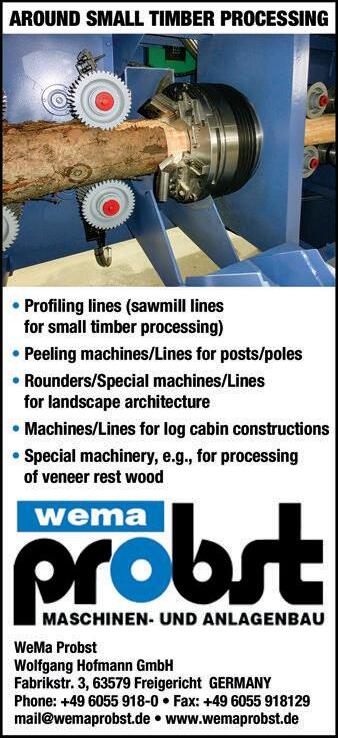


New Europe Coalition Focuses On Bioeconomy
European Panel Federation reports that a new group of 14 EU trade associations including the providers of highquality wood-based products, fiberbased, paper and board products and packaging, and renewable energy solutions, supported by EU forest owners and managers, has launched a coalition to present EU policymakers with an ambitious common vision leading toward a circular bioeconomy.
“Now, more than ever, is the time to embed into EU policy the circular bioeconomy as a fully integrated, resilient European value chain,” states the EPF news release. The coalition has made ➤ 85
78 ➤ 80 ■ MAY 2023 ■ TIMBER PROCESSING CLICK HERE IF YOU HAVE NOT ALREADY OPTED IN!

CLICK HERE IF YOU HAVE NOT ALREADY OPTED IN!
MACHINERYROW
and we wanted to make our own contribution by donating our 75,000th truck to this very worthwhile charity.”
Forest Pro Adds DEVELON Lineup
Forest Pro, Inc., a logging equipment dealership in Virginia, is partnering with DEVELON, formerly Doosan, to begin offering heavy equipment at its three locations: Scottsville, Manquin and Keysville.
All three locations will feature the full line of DEVELON construction equipment, including crawler, wheel and mini excavators, wheel loaders, dozers and articulated dump trucks, for general contractors, landscapers and loggers. Each location also provides parts and service for its customers.
“We’re thrilled to offer DEVELON products in Scottsville, Manquin and Keysville,” says Joel Matteson, general manager at Forest Pro, Inc. “Our company has been serving logging customers for over 30 years and continues to provide the highest level of customer service available in the forestry industry. We look forward to the future and to building strong relationships with customers and the community.”
Forest Pro employs 40 experienced sales, parts and service staff at the three locations.
“Forest Pro has had much success over the years since they know the logging industry very well,” says Matt Pixler, director of sales at DEVELON. “By adding DEVELON equipment to their available product offerings at their three Virginia locations, they can build upon their forestry success and expand into additional markets such as construction, landscaping and mining.”
WMF Returns To Shanghai
Shanghai International Furniture Machinery & Woodworking Machinery Fair (WMF) will co-locate with CIFF (Shanghai) at the National Exhibition and Convention Center in Shanghai Hongqiao, China, September 5-8, 2023 and serve as a vital platform for the entire woodworking and furniture industry. WMF will join hands with top machinery and raw materials exhibitors from all over the world to make a physical return, bringing a broader perspective to the industry.
More than 300 exhibitors and 30,000
high caliber domestic and foreign buyers are expected to gather at WMF seeking collaboration and staying ahead of the curve in the post-pandemic era.
WMF focuses on five major themes: Furniture Manufacturing Equipment, Wood-Based Panel Production Technology, Upholstered Furniture Production Technology, Surface Treatment Technology, and Knives, Blades, Machinery Accessories and Hand Tools.
A series of seminars and forums will be held during the show: “2023 Innovative Technologies and Materials Driving Sustainability and Healthy Life in the Wood Working Industry,” “An Exploration on Recycled New Material Industry Chain” and “2023 National Conference on Flexible and Smart Manufacturing of Upholstery Furniture.”
Registration for WMF 2023 is open now at https://bit.ly/40whwib. All industry players are welcome to pre-register online to enjoy free admission to both WMF and CIFF.
Arxada Teams With ICONX
Arxada and ICONX Chemicals, in partnership with service provider Zee Water & Energy, announced a new distribution partnership for AntiBlu and Mycostat products in the Eastern half of the U.S. Arxada’s antisapstain chemicals, including anti-mold and anti-fungals, brighteners, and defoamers, bring cleaner and brighter wood to the marketplace and protect the value of wood products. The products have protected wood products successfully in the sawmill market for decades. ICONX Chemicals is a complete source of high-quality specialty chemicals for sawmills, toll blenders, and water treatment service companies and will distribute Arxada’s broad line of antisapstain chemicals through their preferred service provider Zee Water & Energy.
The Arxada and ICONX team, in partnership with Zee Water & Energy, are equipped to provide on-site technical support and analytical services along with customized engineering and marketing services to meet your wood protection needs. Look for the companies at upcoming trade shows and industry events such as MLMA and SLMA.
Contact Brian Delbrueck (brian.delbrueck@arxada.com), Miles Stoffer (miles@iconxchemicals.com), and Lesa Johnson (Lesa.johnson@vincitgroup.com).
Bandit Industries Continues Growth
Bandit Industries, Inc. celebrated the acquisition of a facility in Mount Pleasant, Mich. with a ribbon cutting ceremony on April 5. This facility formerly owned by Burch Tank is situated on 24 acres with 60,000 sq. ft. of manufacturing space.
“These buildings and this property will be so instrumental in growing our company as we continue to ramp up to meet the growing demand for our products,” stated Bandit CEO Jerry Morey during the ceremony.
The location includes Bandit’s electrical team, consisting of wiring harnesses for all Bandit products. Components for the whole tree chipper and horizontal grinder product lines also are produced at this new location. Future plans include moving the rebuild department from the main headquarters. The rebuild department specializes in the refurbishment and service of existing Bandit machines.
“The primary facility of this site is ideal for producing one of our major product lines,” Morey adds. “We will be adding a new paint room before we move a line here.”
2023 marks Bandit’s 40th anniversary and much of its success is contributed to quality products, an amazing dealer network, loyal customer base, and their dedicated hard-working employees. The current product line consists of hand-fed and whole tree chippers, stump grinders, wood waste grinders, and Arjes slow speed shredders.
Bandit became an employee-owned company (ESOP) in 2018. During his speech, Morey briefly talked about how Bandit became an ESOP: “We initially looked at selling to another manufacturing company and then an investment banking company, but backed out of those offers over concerns for our employees and the future of the company.”
Over the next couple of years, Bandit will likely need an additional 200 employees and hopes to fill 95 open positions by the end of 2023.
In addition to the new Mount Pleasant facility, Bandit invested an additional $14 million throughout 2022 conducting several expansions at its main campus nearby at Remus, Mich., including adding an 80,000 sq ft. steel room featuring new cutting and machining equipment and robots. Once added together, the total manufacturing space across all Bandit locations equals 560,000 sq. ft.
77 ➤ 82 ■ MAY 2023 ■ TIMBER PROCESSING CLICK HERE IF YOU HAVE NOT ALREADY OPTED IN!
nered with local government, first responders, and the faith-based community to help fulfill unmet needs and provide empowering programming for families. Once operational, Enviva’s Epes plant will be one of the largest taxpayers in the county, resulting in economic benefits to the community with funding for programs like road maintenance, schools, as well as safety and emergency services.
Enviva started preliminary construction of its fully contracted Epes plant in July 2022. The plant is expected to have a capacity of 1.1 million metric tons per year and is expected to be in service in 2024 and fully ramped in 2025. Once operational, the Epes plant is expected to support approximately 350 direct and indirect jobs, including in adjacent industries such as logging and trucking.
● Enviva also issued a statement today thanking the Mississippi Dept. of Environmental Quality’s (MDEQ) permit board for unanimous approval for the construction permit of Enviva’s Bond, Miss. facility. The permit was issued after an extensive review process that included a public comment period, a wellattended public hearing, and numerous public comments.
The proposed facility will be designed to produce 1.2 million oven dried tons (ODT) per year of wood pellets. To obtain this permit, over the last year Enviva engaged closely with the community to hear and proactively address any concerns, as well as prove the plant will comply with all regulatory requirements to protect public health and the environment.
Enviva’s Bond plant will strengthen the regional wood market for previously unmerchantable timber. Once operational, the facility in Bond will support approximately 350 direct and indirect jobs.
ROSEBURG ANNOUNCES MASSIVE INVESTMENT
In a much anticipated announcement, Roseburg Forest Products revealed in mid-April its plan to invest $700 million during the next four years to upgrade and expand its manufacturing operations in southern Oregon, including at Dillard, current site of multiple operations and where the company was founded nearly 90 years ago.
The total investment package includes the creation of two new manufacturing plants, and technological improvements
and upgrades at existing plants in rural Douglas and Coos counties.
The total project represents the largest known investment in manufacturing in rural Oregon, and one of the largest private capital investments of any kind in the state’s history, according to Roseburg.
“Across the business, Roseburg is embracing advanced manufacturing and leveraging new technology and methods to make our current products and develop new ones, with the goal of ensuring we remain competitive in the global market,” Roseburg President and CEO Grady Mulbery said. “I want to thank our partners at the Governor’s office and Douglas and Coos counties for helping make this historic investment possible.”
Nearly 200 people gathered at the Douglas County Fairgrounds for the announcement. In attendance were Allyn Ford, Roseburg owner and board chairman, and representatives of the state and county agencies who worked with Roseburg on the project.
The investment includes two new highly technical manufacturing plants at the company’s Dillard Complex, located just south of Roseburg, Ore. Dillard MDF will use wood residuals from Roseburg’s local mills and other regional mill suppliers to manufacture standard medium density fiberboard (MDF) panels, as well as thin high density fiberboard (HDF), often used in cabinetry, doors and other applications.
Dillard Components will convert specialty MDF panels manufactured at Roseburg’s MDF plant in Medford, Ore.
into Armorite Trim, a finished exterior trim product for residential and shed use. Roseburg currently owns and operates three MDF plants in North America.
The company anticipates that both new plants will begin operations in 2025, and will employ approximately 120 once completed.
The remaining $200 million of the investment will go toward improvements at existing Roseburg plants in Oregon over the next four years, including significant upgrades at its plywood plant in Riddle, Ore., including two new lathe lines and a new hardwood plywood line; and a new dryer at its plywood plant in Coquille, Ore.
In June 2022, Roseburg revealed that it was exploring the feasibility of locating an additional MDF plant or other residual-based operation within its Western operating footprint. That study, combined with a years-long strategic assessment of company operations across the state, resulted in the decision to make this investment in southern Oregon.
Founded in 1936, Roseburg Forest Products is a privately-owned company and one of North America’s leading producers of particleboard, medium density fiberboard and thermally fused laminates. Roseburg also manufactures softwood and hardwood plywood, lumber, LVL and I-joists. The company owns and sustainably manages more than 600,000 acres of timberland in Oregon, North Carolina and Virginia, as well as an export wood chip terminal facility in Coos Bay, Ore.
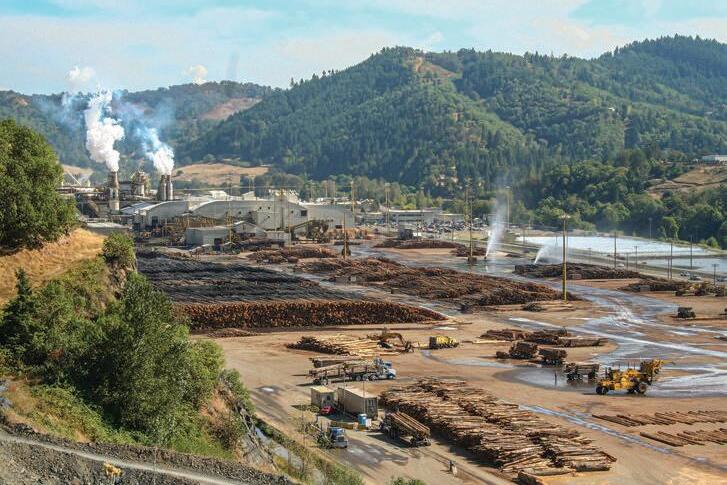
NEWSFEED TIMBER PROCESSING ■ MAY 2023 ■ 83 8 ➤
CLICK HERE IF YOU HAVE NOT ALREADY OPTED IN!
Roseburg’s site at Dillard, Ore.




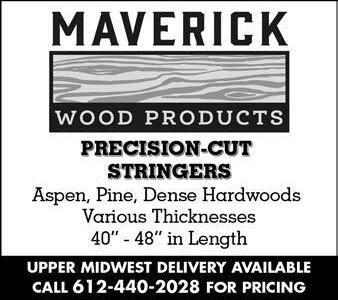

02/23 NORTH AMERICA ■ United States ■ Canada ■ North Carolina ■ Georgia ■ Ontario Manufactures Kiln-Dried 4/4 Red and White Oak, Poplar, Ash and Cypress Contact: Linwood Truitt Phone (912) 253-9000 / Fax: (912) 375-9541 linwood.truitt@beasleyforestproducts.com Pallet components, X-ties, Timbers and Crane Mats Contact: Ray Turner Phone (912) 253-9001 / Fax: (912) 375-9541 ray.turner@beasleyforestproducts.com Beasley Forest Products, Inc. P.O. Box 788 Hazlehurst, GA 31539 beasleyforestproducts.com WANT TO GET YOUR AD IN OUR NEXT MARKETPLACE? Call or email Melissa McKenzie 334-834-1170 melissa@hattonbrown.com WOOD PRODUCTS MARKETPLACE We produce quality 4/4 - 8/4 Appalachian hardwoods • Red Oak, White Oak, Poplar • Green Lumber: Air Dried, Kiln Dried Timbers & Crossties • Hickory, Sycamore, Beech, Gum & Elm • Custom Cut Timbers: Long lengths and wide widths Sales/Service: 336-746-5419 336-746-6177 (Fax) • www.kepleyfrank.us Buyers & Wholesalers Next closing: July 6, 2023 ■ Kentucky ■ Minnesota HAROLD WHITE LUMBER, INC. MANUFACTUREROFFINEAPPALACHIANHARDWOODS (606) 784-7573 • Fax: (606) 784-2624 www.haroldwhitelumber.com Ray White Domestic & Export Sales rwhite@haroldwhitelumber.com Cell: (606) 462-0318 Green & Kiln Dried, On-Site Export Prep & Loading Complete millworks facility, molding, milling & fingerjoint line STACKING STICKS FOR SALE AIR-O-FLOW profiled & FLAT sticks available Imported & Domestic DHM Company - Troy, TN 38260 731-446-4069 Fax: 707-982-7689 email: kelvin@kilnsticks.com www.KILNSTICKS.com ■ Tennessee WANT TO GET YOUR AD IN OUR NEXT MARKETPLACE? Call or email Melissa McKenzie 334-834-1170 melissa@hattonbrown.com CLICK HERE IF YOU HAVE NOT ALREADY OPTED IN!
LUMBERWORKS
GREENWOOD KILN STICKS
Importers and Distributors of Tropical Hardwood
Importers and Distributors of Tropical Hardwood




Kiln Sticks
Kiln Sticks
“The lowest cost per cycle”
“The lowest cost per cycle”
GW Industries
GW Industries
www.gwi.us.com
www.gwi.us.com
Dennis Krueger Jackie Paolo 866-771-5040 866-504-9095
Dennis Krueger Jackie Paolo 866-771-5040 866-504-9095
greenwoodimportsllc@gmail.com
greenwoodimportsllc@gmail.com
jackie@gwi.us.com
LUMBERWORKS
available a paper detailing common challenges, needs, and solutions (visit europanels.org).
Jointly, coalition members represent 3% of the EU’s GDP, €520 billion in turnover, and 20% of its manufacturing companies. They are an integrated part of the EU bioeconomy, using local renewably-sourced materials, made and recycled in Europe, and using European technology. But their contribution could go much further. They hope to work with the EU institutions towards creating an enabling policy environment for their sectors to collectively reach climate change mitigation equivalent to 30% of EU annual CO2 emissions. In 2019, this figure stood at 20%.
The coalition’s ambition will require consolidating the EU’s global leadership as a provider of sustainable and competitive alternative solutions for today, and innovative opportunities for tomorrow. Europe’s wood and fiber-based value chains are widely considered a laboratory for the future circular bioeconomy.
“In order to be climate neutral by
2050, the EU needs to work with the coalition to accelerate the uptake of bioproducts, encourage investments in green technologies for production processes and supply chains, and support a shift towards sustainable consumption while putting in place policies to boost the competitiveness of sustainable manufacturing industries,” the new release states.
EPF Chairman Martin Brettenthaler stresses: “Wood-based panels are integral to this journey using sustainable materials for furniture, construction, packaging and in multiple everyday applications. As a European global champion in this field, we urge policy makers to work with us to place industry, especially the circular bioeconomy, at the heart of this social, economic and environmental transition.”
Mercer Holz Launches German Forests Program
Mercer has launched its Growing forests – Growing a Future program to support forest owners in Germany. Mercer Holz, the wood purchasing organiza-
tion of Mercer, is committed to partner with forest owners in Germany to sustain the longevity of their forests.
Over the next few years, in a concrete step of solidarity, Mercer will provide participating forest owners across Germany with a careful selection of seedlings to help replenish their forests. The program is a step toward replacing and regenerating that which has been lost from the bark beetle and other natural disasters that have affected forests.
Philipp Freiherr von Oldershausen, one of the participating forest owners, says, “As a forester myself, I’ve seen the damage first-hand. Our forests and the forests of our clients have suffered, particularly in the last couple of years. We welcome Mercer’s initiative because it shows a clear, long-term commitment from Mercer to continue partnering with forest owners, and to support us with regrowing our forests.”
For more than 15 years, Mercer Holz been supplying pulp mills and sawmills with large quantities of industrial wood, sawlogs and wood chips.
Call Toll-Free: 1-800-669-5613 TIMBER PROCESSING ■ MAY 2023 ■ 85 Recruiting Services Executive – Managerial – Technical - Sales JOHN GANDEE & ASSOCIATES, INC Contingency or Retained Search Depending on Circumstances / Needs “Your Success Is Our Business” Serving the Wood Products and Building Materials Industries For more than 26 years. 512-795-4244 Call or Email me anytime! john@johngandee.com www.johngandee.com Austin, Texas 3220 Top Wood Jobs Recruiting and Staffing George Meek geo@TopWoodJobs.com www.TopWoodJobs.com (360) 263-3371 3779 1615 EMPLOYMENT OPPORTUNITIES
jackie@gwi.us.com 127
ATLARGE 13877
80 ➤ CLICK HERE IF YOU HAVE NOT ALREADY OPTED IN!
minutes for all of them to get through blowing. No. 2 Mill would have to blow, No. 1 Mill would have to blow, No 3 Mill would have to blow, it was the most foolish thing but it had to go on. They had a call at every mill.
“They did that so that the crew that was working at that mill would hear their call and know the mill was going to run that day. Then all the log trains started out about three o’clock in the morning and every one of them had to blow signals and get answers, and this was the whistle-blowingest place I ever heard tell of. It rocked on that way until now it has gotten to where you can hardly tell the mill is running now.” (Then again 43 years in a pre-PPE planer mill might have had a lot to do with hardly telling the mill is running now.)
During his overall 55-year career as a piney woods planer operator, Dunn said he saw feed rates go from 35-40 FPM to more than 400 FPM. He said when he came to Chapman the biggest lumber quality problem was everyone at the planer mill thought they were the boss. He mentioned good and bad coworkers and several bad accidents, and said the logging back then was absolutely rough work. His son Crawford worked at the mill starting at age 15 and rose to dry sorter foreman when he died unexpectedly at a young age. “They shut the mill down for his funeral. That was mighty nice of them. I appreciated that,” Dunn said.
Great granddad explained that he had only missed three days of work in 1950 but had been feeling run-down and tired, and when he went to the doctor he was told “not to go in that mill any more.” This led to his retirement in March 1951, and the newspaper interview six months later.
In closing, he said, “I wish them well-Messers. Floyd, Earl and Julian. I wish them well. It feels kind of homey, Chapman does-kind of homey. I’ve got a lot of friends in Chapman-white and colored.”
MAINEVENTS
MAY
15-16— Lumber Quality and Process Control Workshop, Embassy Suites, Perimeter Hotel, Atlanta, Ga. Call 541-7522751; visit lumberquality.com/Southern-Workshops
15-19—Ligna: World Fair For The Forestry And Wood Industries, Hannover Exhibition Center, Hannover, Germany. Call +49 511 89-0; fax +49 511 89-32626; visit ligna.de.
17-18— Lumber Quality Leadership Workshop, Embassy Suites, Perimeter Hotel, Atlanta, Ga. Call 541-752-2751; visit lumberquality.com/Southern-Workshops
19-20—Northeastern Forest Products Equipment Expo (Loggers’ Expo), Cross Insurance Center, Bangor, Maine. Call 315369-3078; visit northernlogger.com.
JUNE
9-10— PA Timber Show, Russell E. Larson Agricultural Research Center, Pennsylvania Furnace, Penn. Call 814-8632873; visit agsci.psu.edu/timber.
10-13—Assn. of Consulting Foresters of America annual conference, The Graduate Eugene Hotel, Eugene, Ore. Call 703548-0990; visit acf-foresters.org.
Listings are submitted months in advance. Always verify dates and locations with contacts prior to making plans to attend.
TIMBER PROCESSING
TP
A ● D ● L ● I ● N ● K ADLINK is a free service for advertisers and readers. The publisher assumes no liability for errors or omissions. A W Stiles Contractors 78 931.668.8768 American Wood Dryers 60 503.655.1955 Barton Maquinaria 53 +34 986 559 460 BID Group 88 843.563.7070 Biolube 73 260.414.9633 BM&M Screening Solutions 73 800.663.0323 Brunner Hildebrand 69 615.469.0745 Burton Mill Solutions 3 800.426.6226 Calibre Equipment 65 +64 21 586 453 Carbotech-Autolog 38 819.362.6317 Ceratizit 6 +352 31 20 85 1 Claussen All-Mark International 79 800.252.2736 Cleereman Industries 16 715.674.2700 Combilift 39 +353 47 80500 Cone Omega 42 229.228.9213 Delmhorst 73 877.335.6467 Down River Cryogenics 80 866.616.1405 Dynalyse 61 +46 (0)31 44 86 32 Easy-Laser 34 +46 31 708 63 00 Esterer Wd 57 +49 8671 503 0 EXPO 2023 79 504.443.4464 FiberPro 77 501.463.9876 G F Smith 19 971.865.2981 Gilbert Products 27 418.275.5041 Grenzebach Maschinenbau 41 770.253.4980 Halco Software Systems 77 604.731.9311 Hogue Industries 7 503.656.5100 Holtec USA 2 800.346.5832 Industrial Autolube International 80 403.754.3646 JoeScan 56 360.993.0069 Ledinek Engineering 44-45 +386 2 61300 51 Limab 47 +46 31 58 44 00 Linck 49 936.676.4958 Linden Fabricating 74 250.561.1181 McDonough Manufacturing 54 715.834.7755 Mebor 59 +386 4 510 3200 Mellott Manufacturing 15 717.369.3125 Mendes Maquinas 43 +55.49.3241.0066 Metal Detectors 19 541.345.7454 MiCROTEC 33 541.753.5111 Mid-South Engineering 79 501.321.2276 Minda Industrieanlagen 61 828.313.0092 Mühlbock Holztrocknungsanlagen 55 +43 7753 2296 0 Murray-Latta Progressive Machine 63 888.298.9877 Nelson Bros Engineering 51 888.623.2882 Oleson Saw Technology 21 800.256.8259 Opticom Tech 78 800.578.1853 PA Timber Show 63 814.863.2873 Piche 35 833.574.4333 Precision-Husky 13 205.640.5181 Premier Bandwheel 77 604.591.2080 Prinz 87 855.467.7469 Rawlings Manufacturing 36 866.762.9327 Real Performance Machinery 23 843.900.9494 Samuel Coding & Labeling Group 52 800.667.1264 Samuel Packaging Systems Group 8 800.323.4424 Sering Sawmill Machinery 14 360.687.2667 Sicam Systems 12 604.584.7151 SII Dry Kilns 17 800.545.6379 Smithco Manufacturing 14 800.764.8456 Springer Maschinenfabrik 71 +43 4268 2581 0 Stenner 51 +44 0 1884 255700 T S Manufacturing 58 705.324.3762 Telco Sensors 25 800.253.0111 Terex Deutschland 31 +49 0 7253 84 0 UC Coatings 76 716.833.9366 USNR 9 800.289.8767 Valutec 29 +46 0 910 879 50 Wagner Meters 40 800.581.2722 Weinig Group 37 +49 9341 86 1229 Wema Probst 80 +49 6055 918 0 Wolftek Industries 67 800.991.4399 Wood-Mizer 39 866.477.9268
ADVERTISER PG.NO. PH.NO.
This issue of Timber Processing is brought to you in part by the following companies, which will gladly supply additional information about their products.
86 ■ MAY
■
2023
5 ➤ CLICK HERE IF YOU HAVE NOT ALREADY OPTED IN!

CLICK HERE IF YOU HAVE NOT ALREADY OPTED IN!

CLICK HERE IF YOU HAVE NOT ALREADY OPTED IN!

















































 Hall 26, Stand F31
Hall 26, Stand F31



 LINCK new SEL sideboard separation
LINCK new SEL sideboard separation
































































































